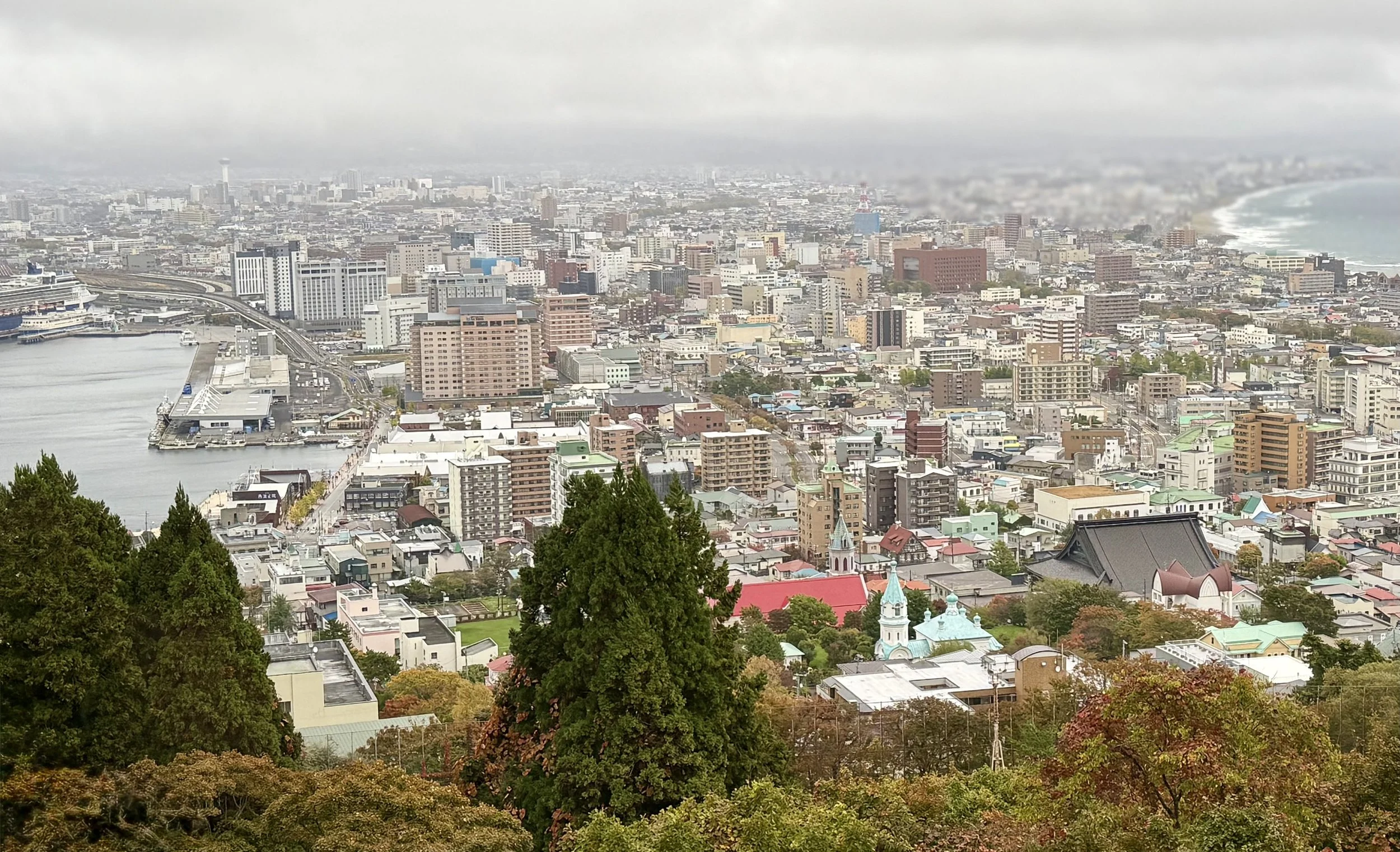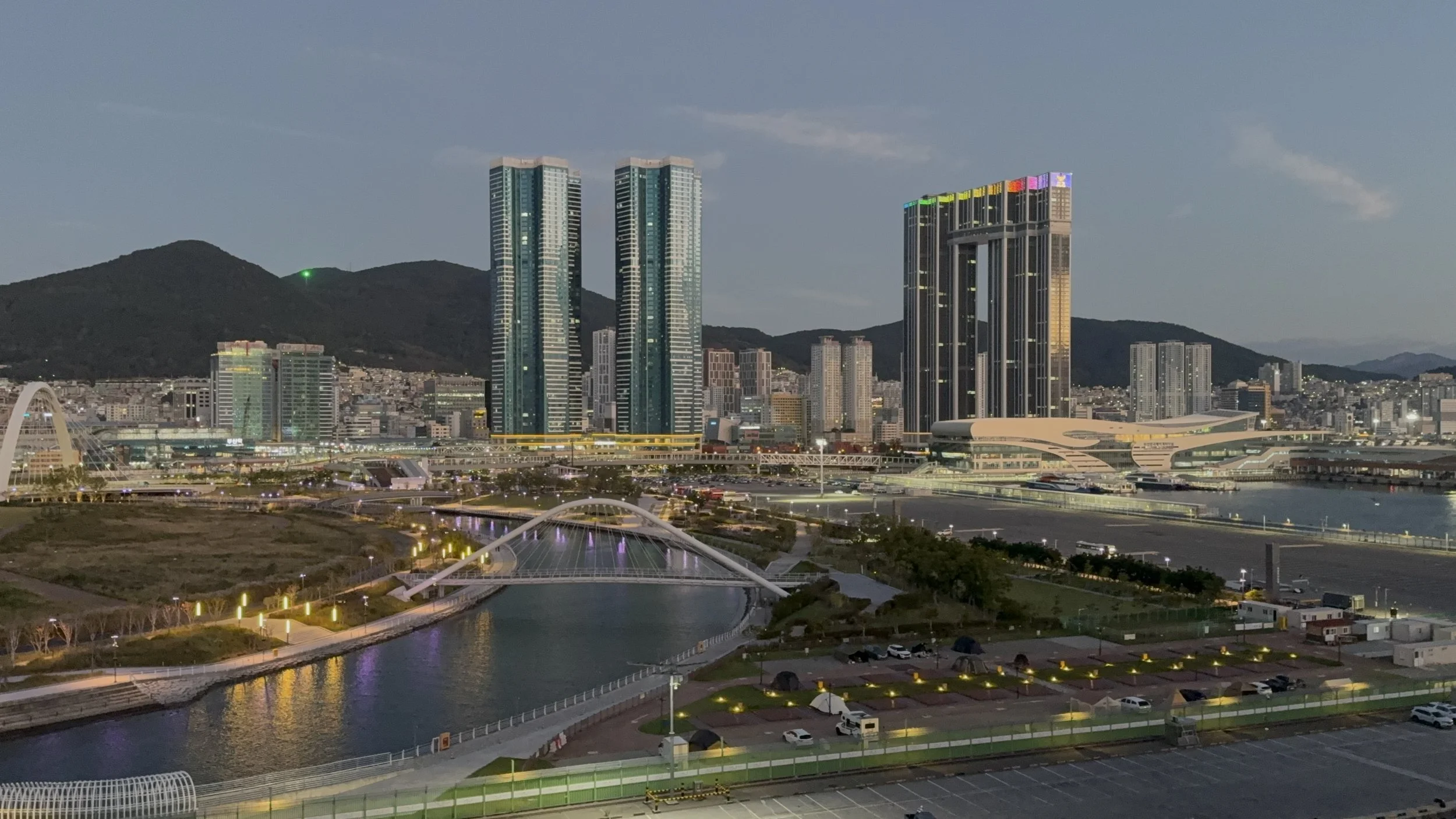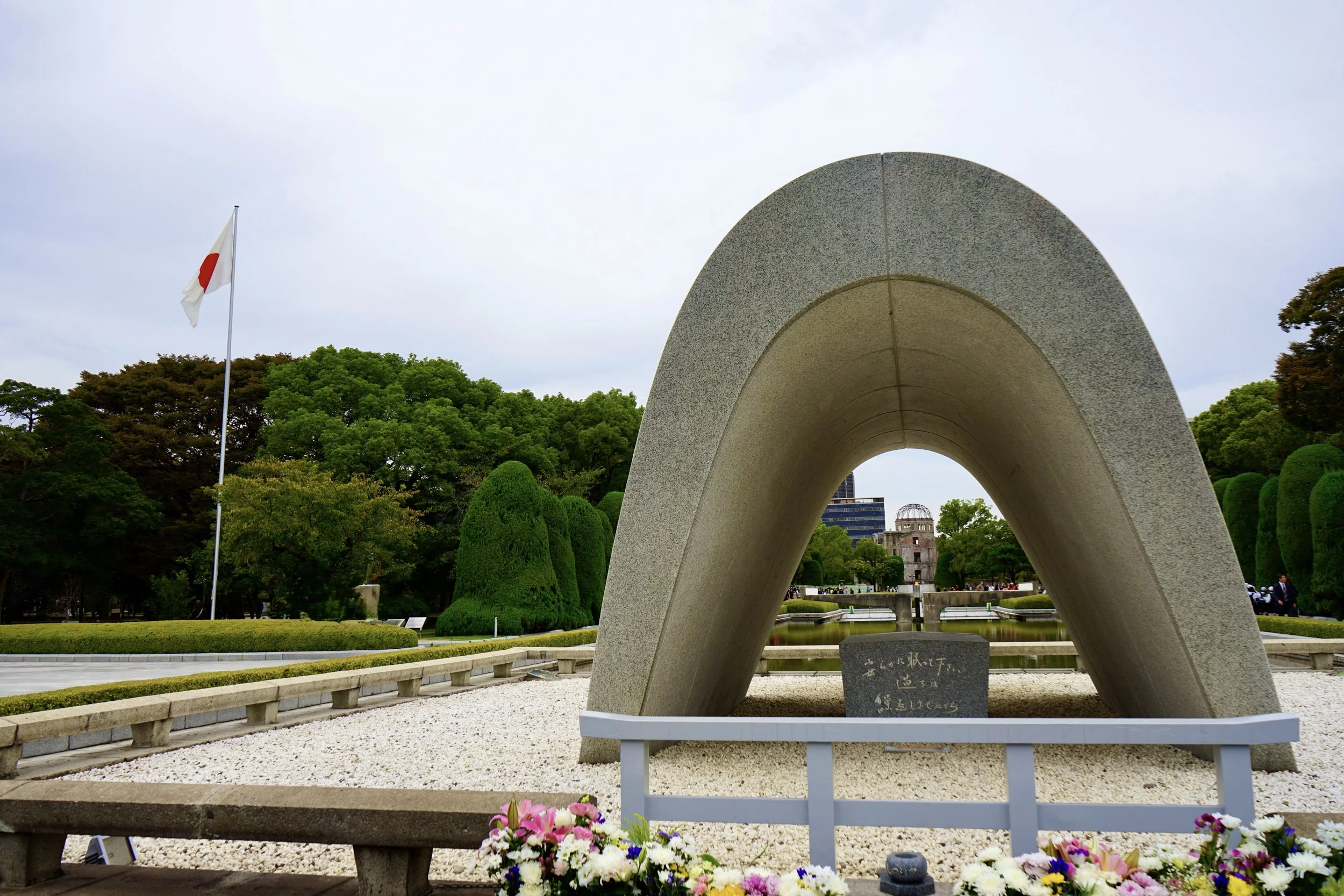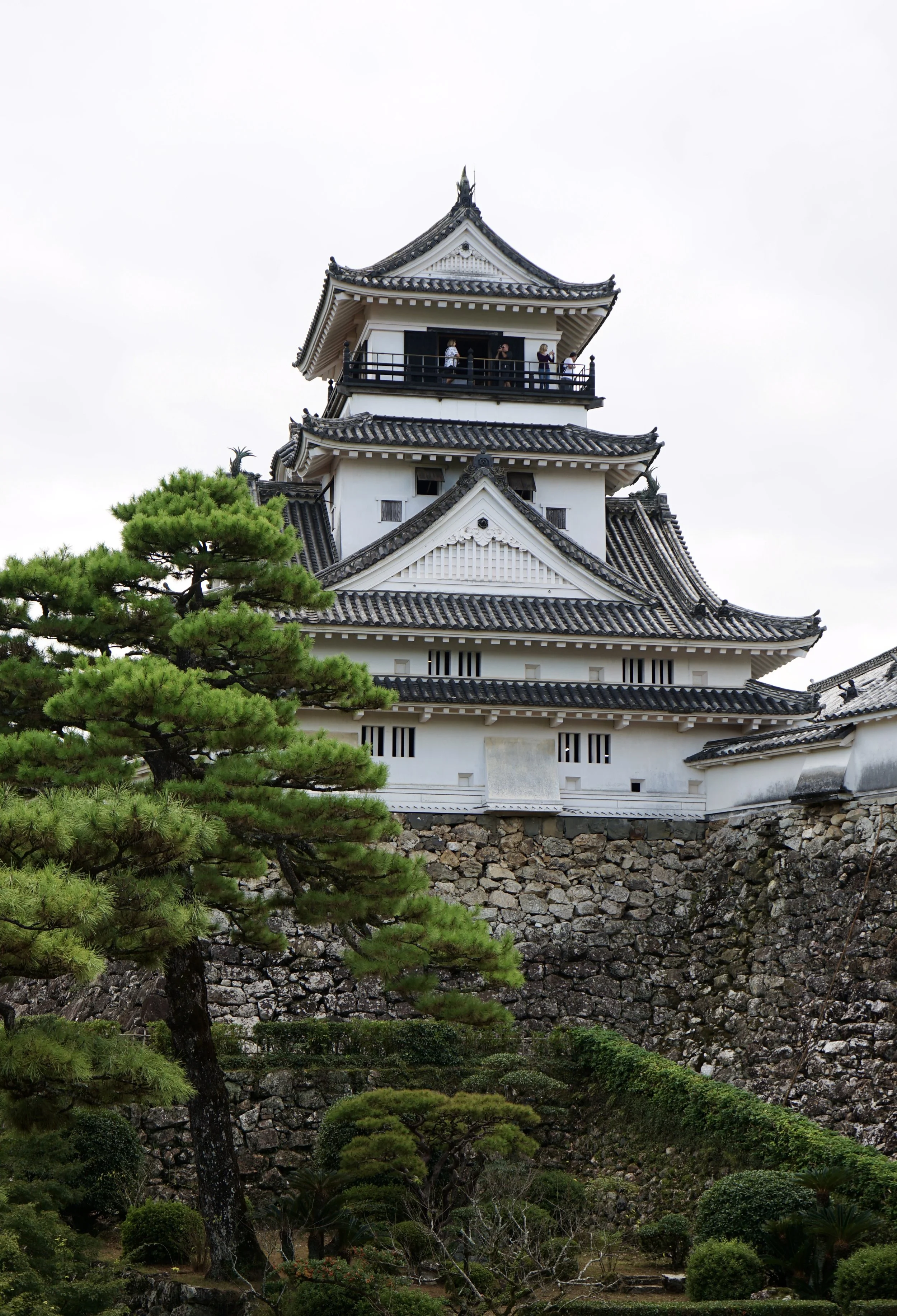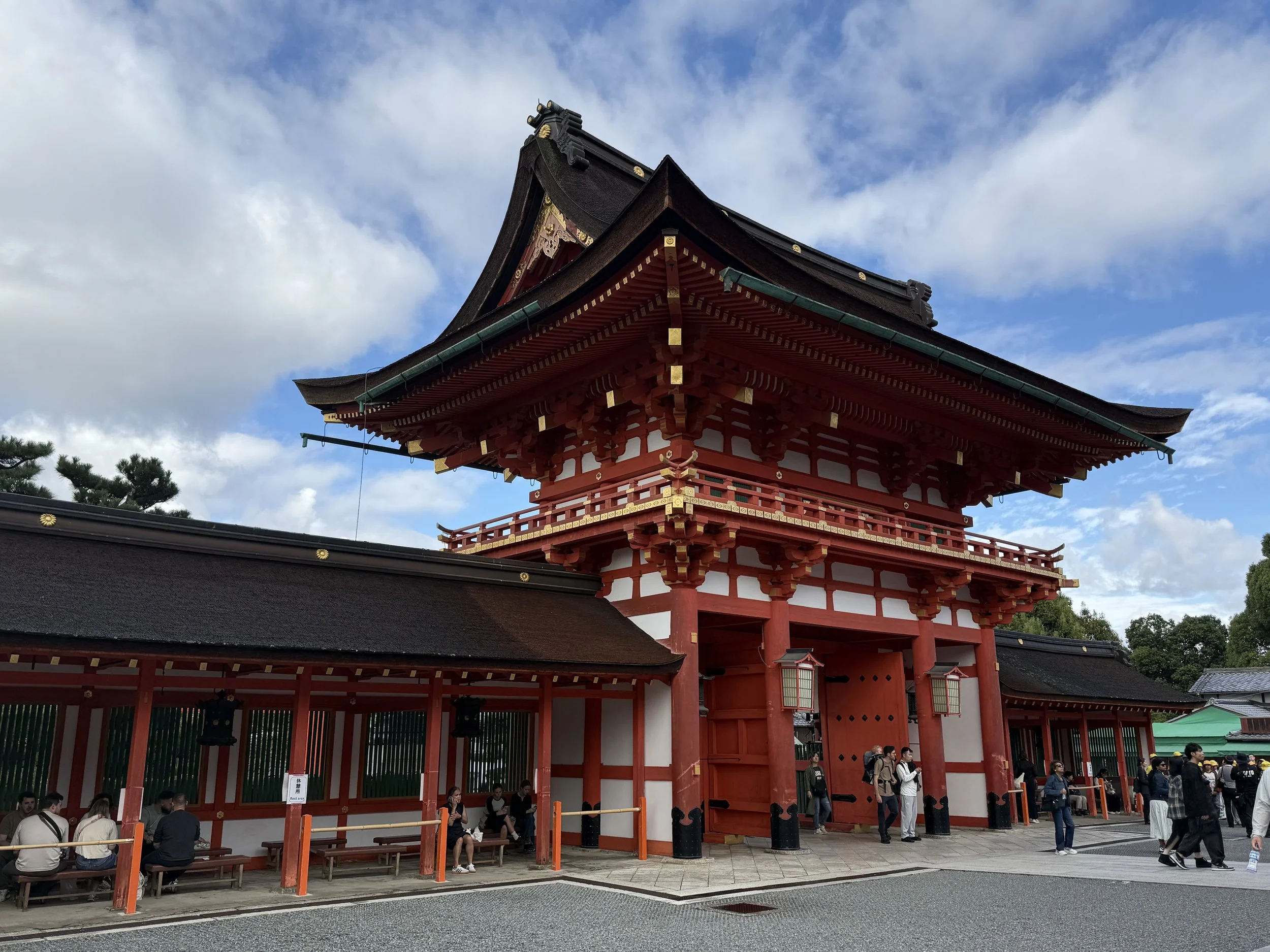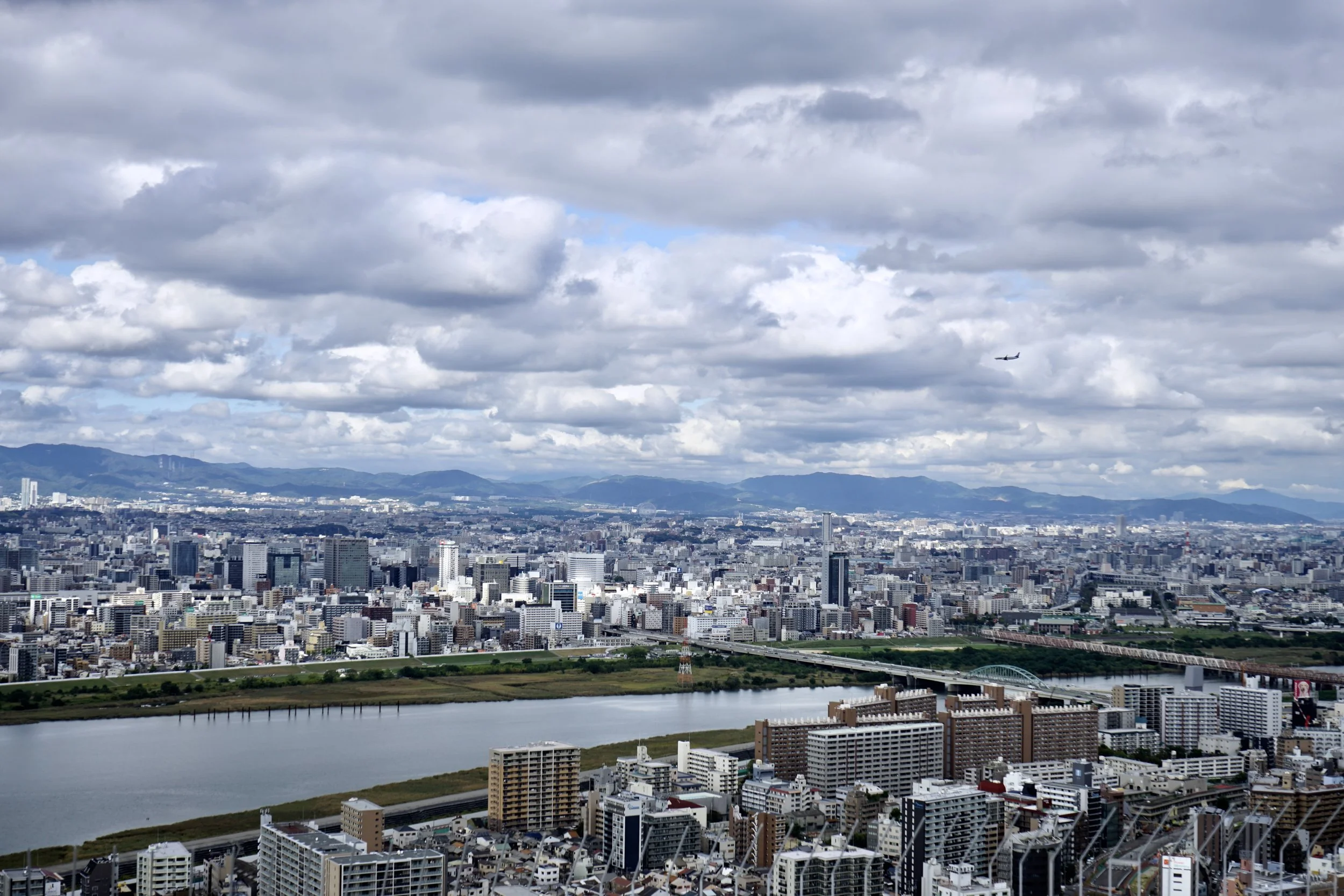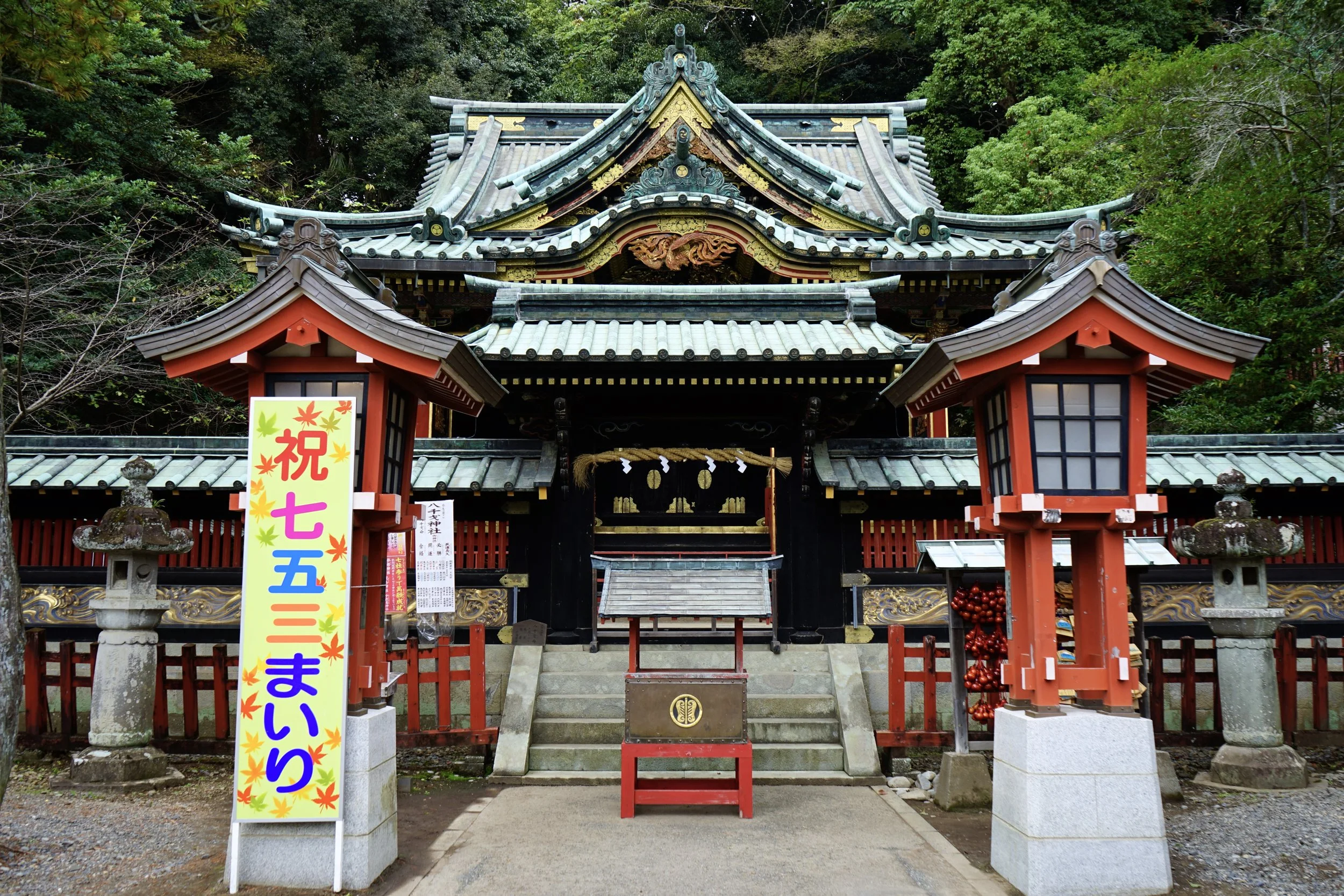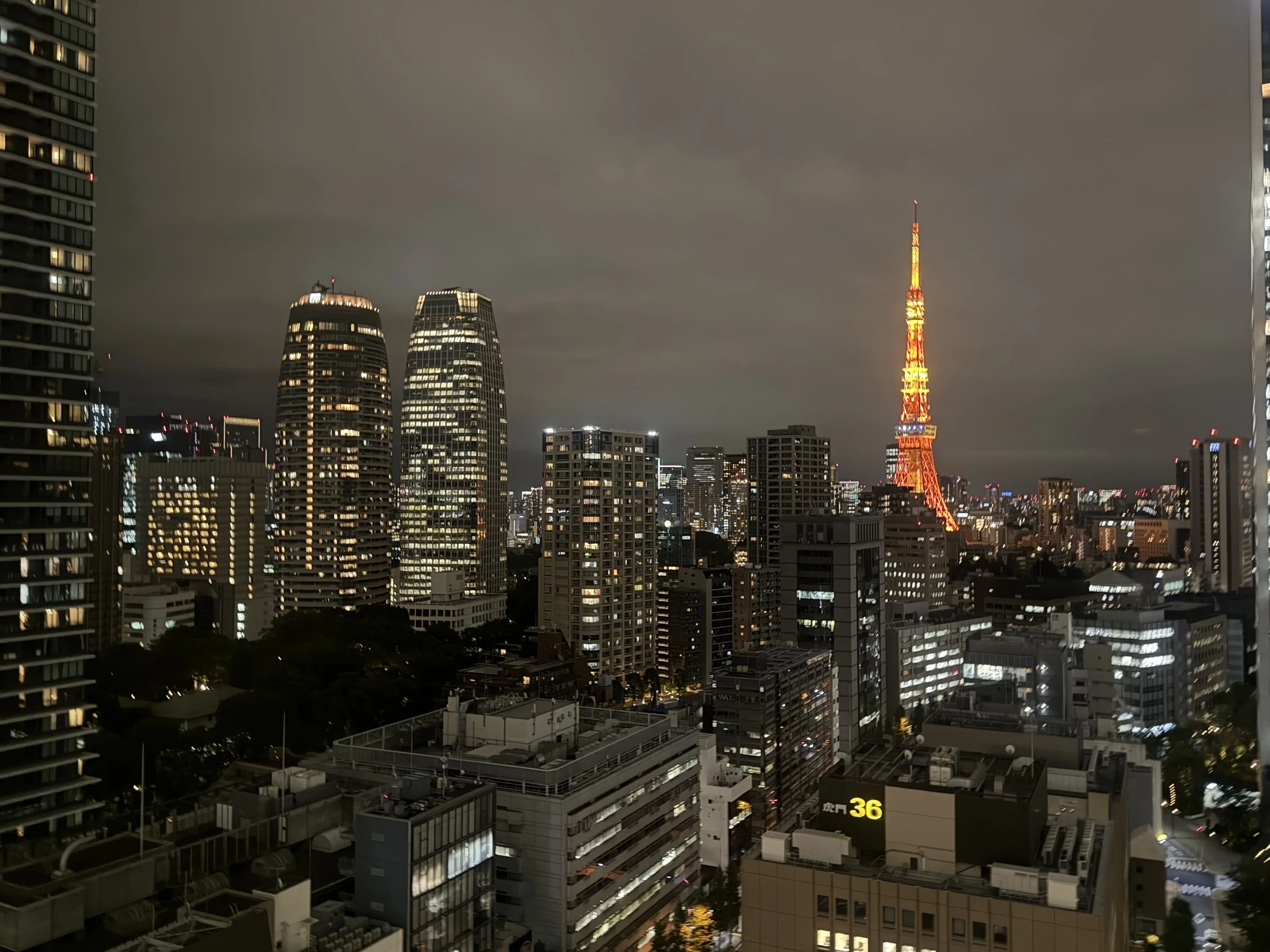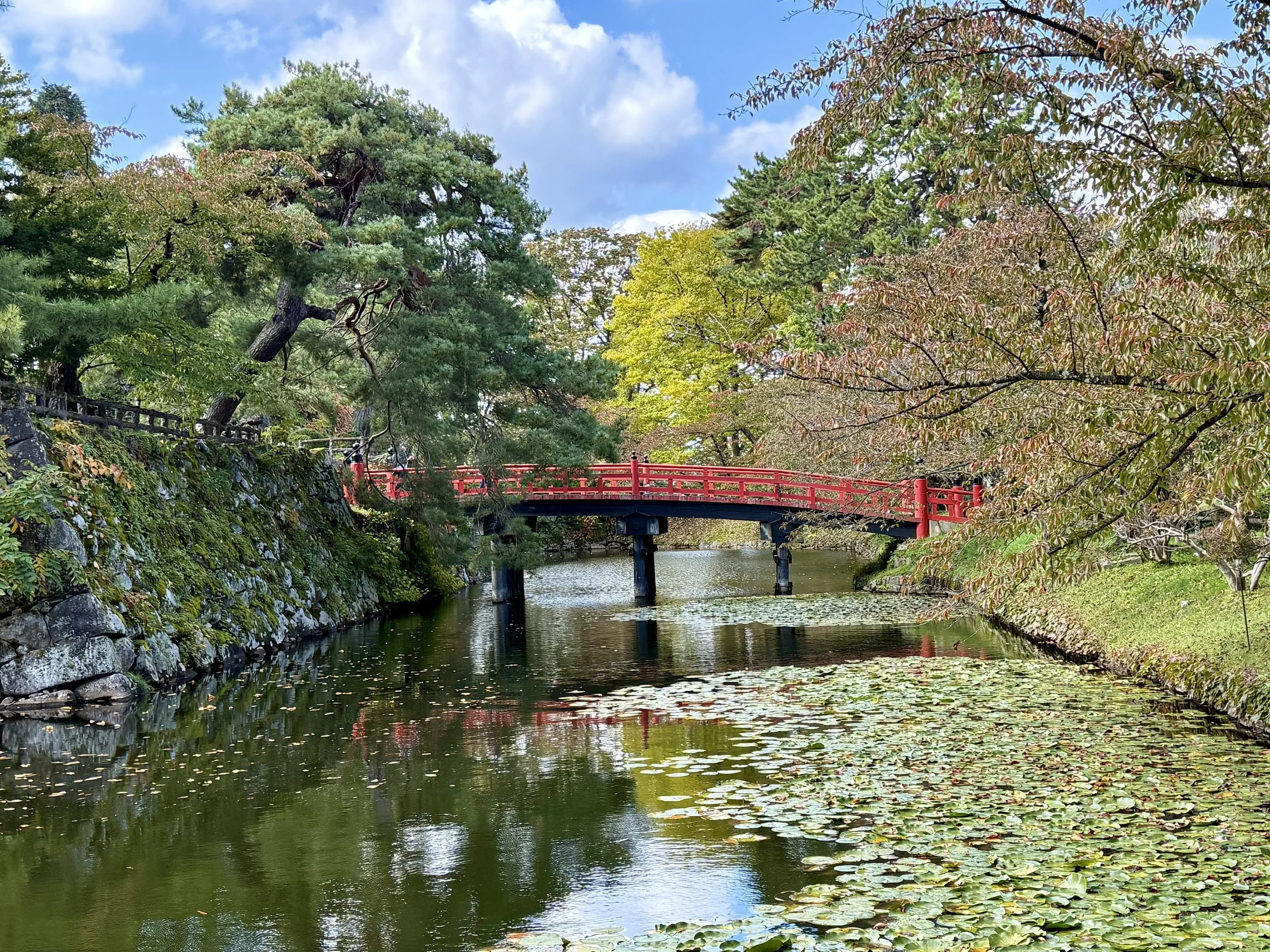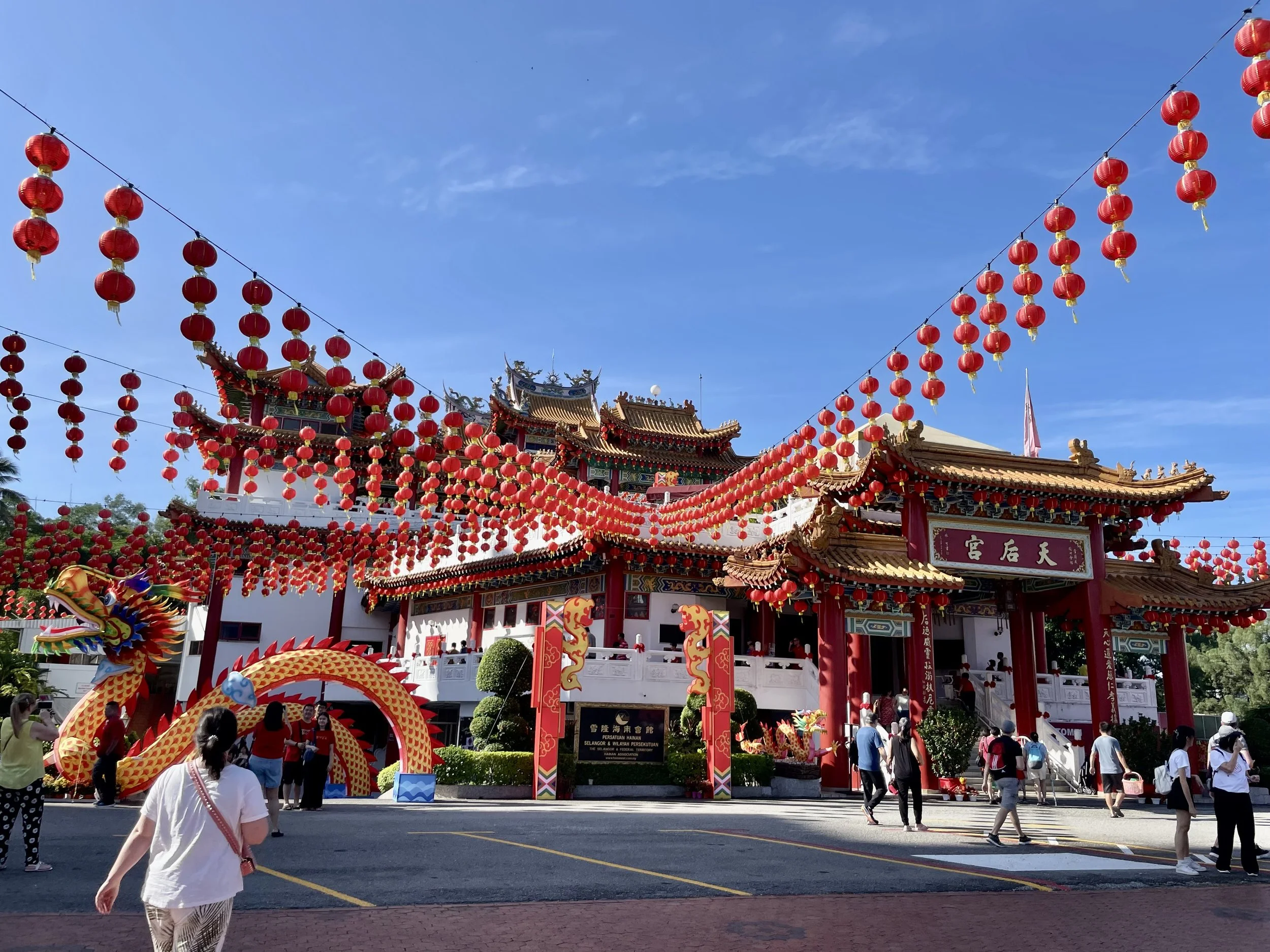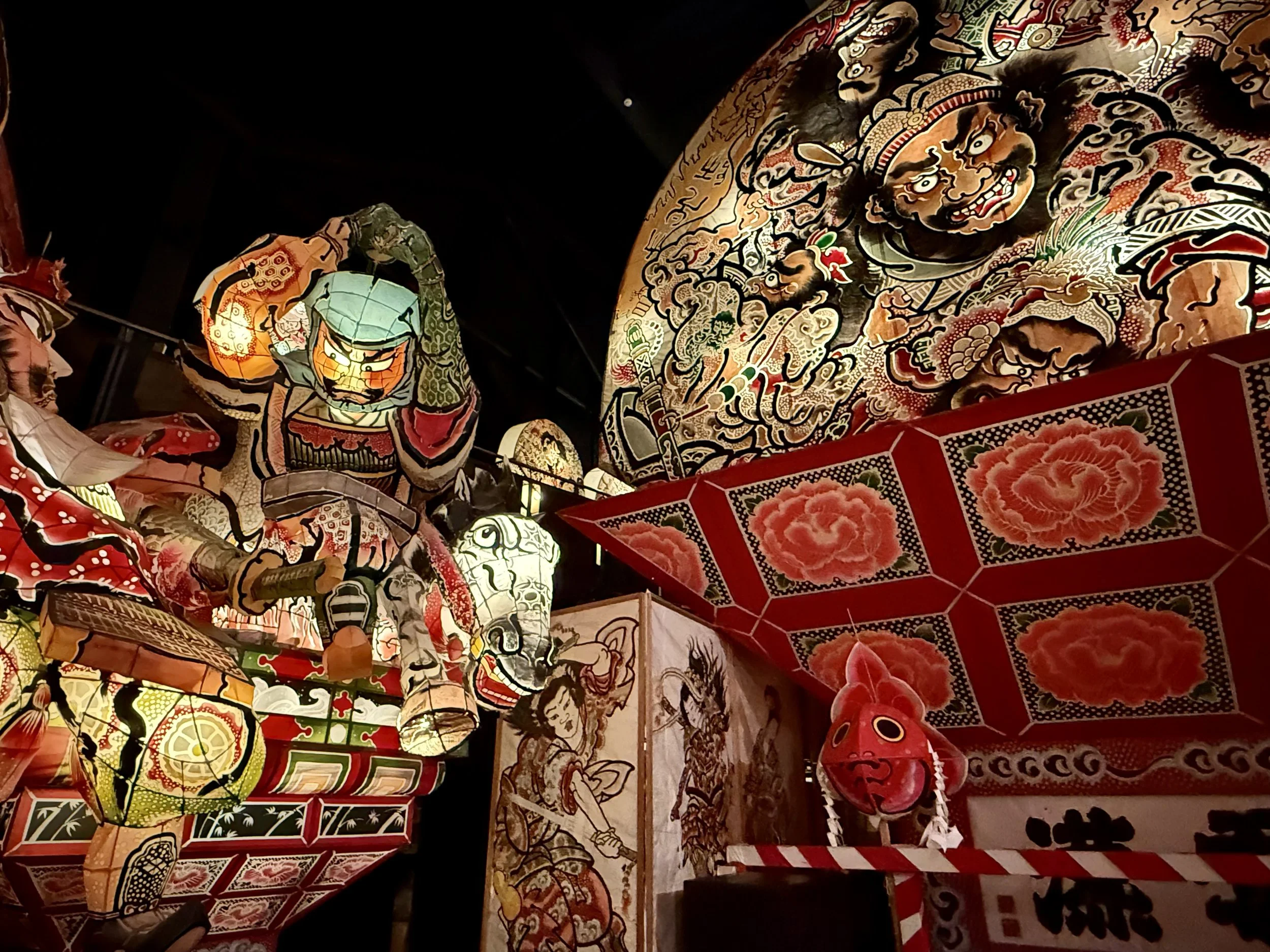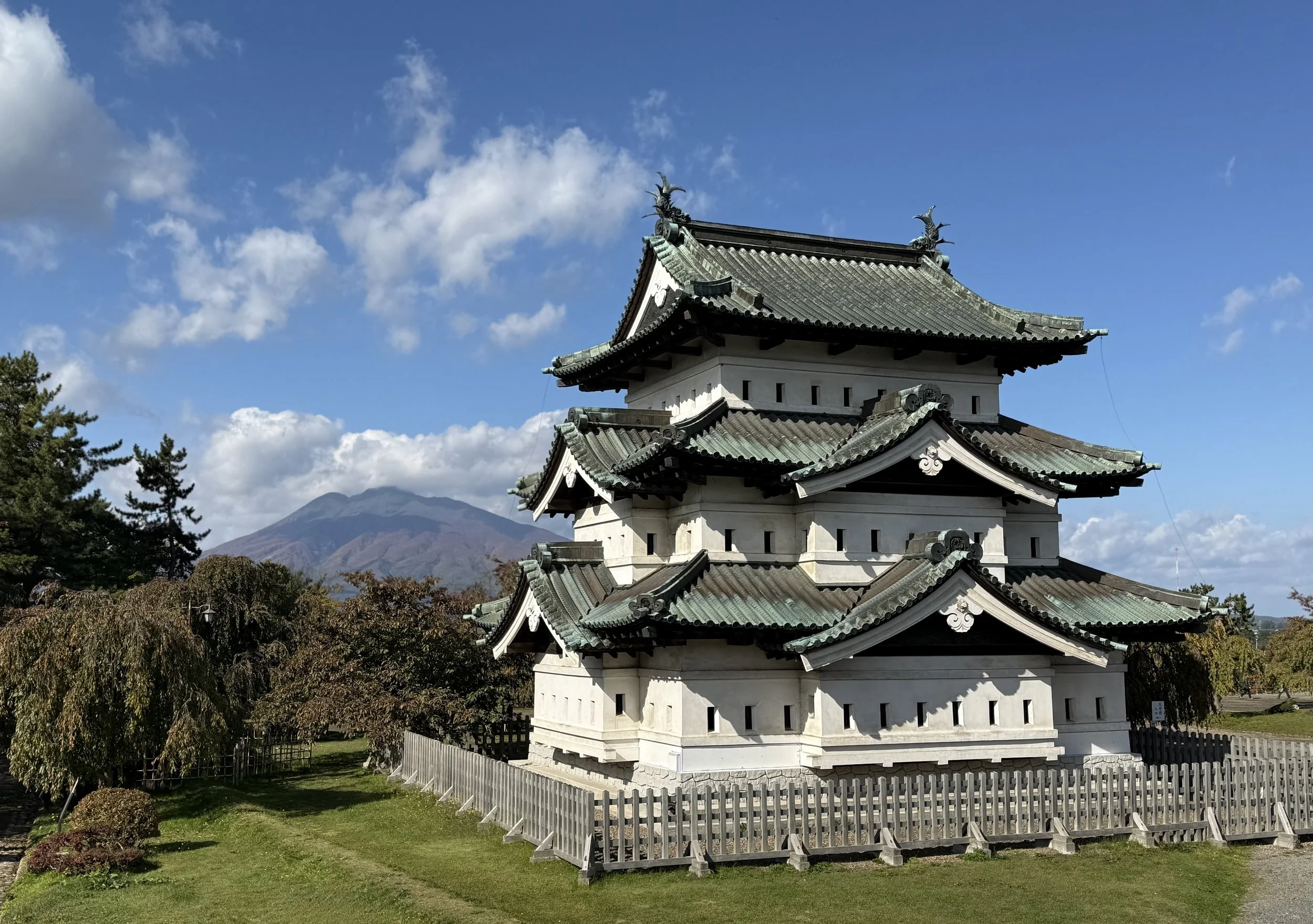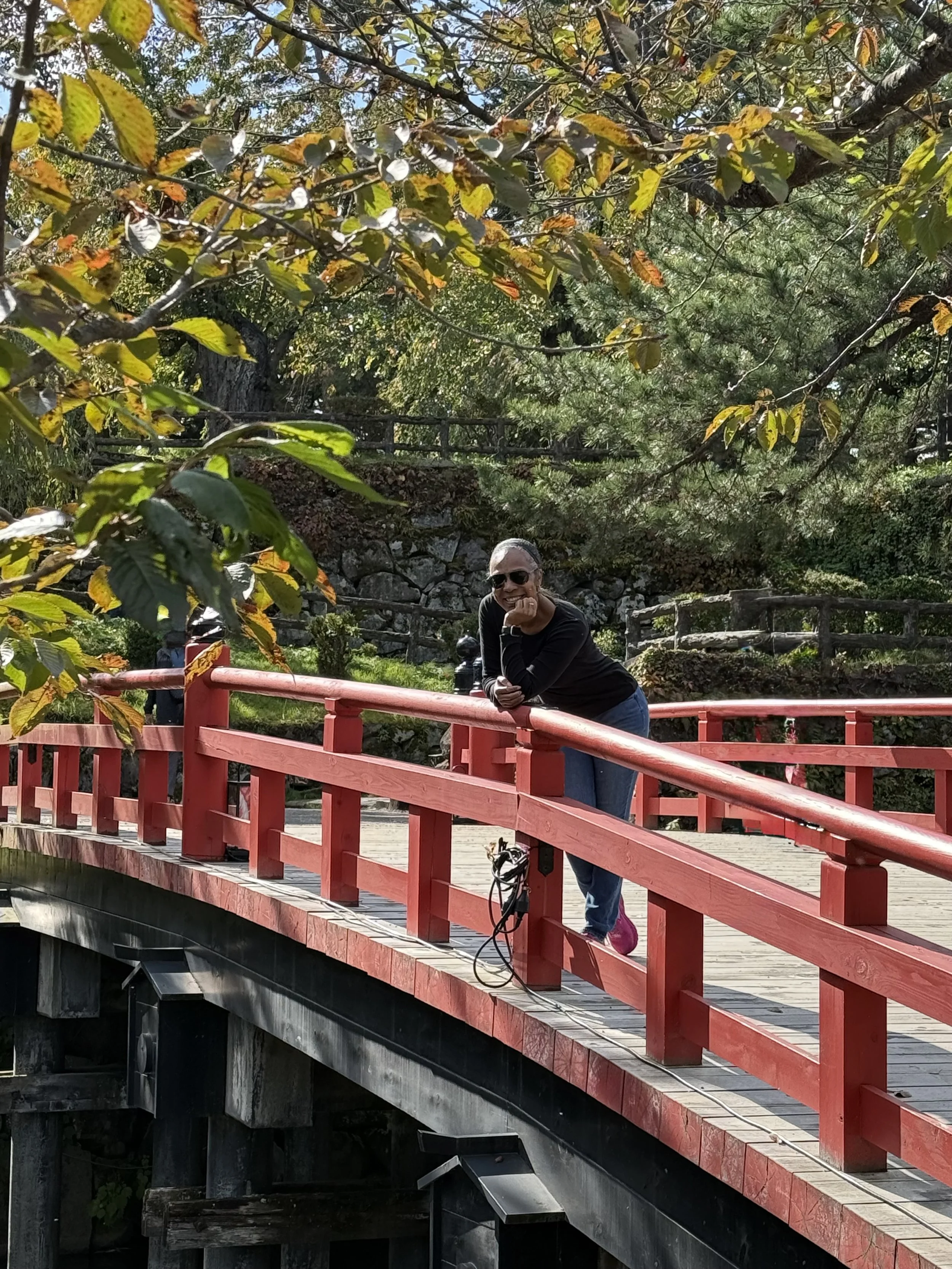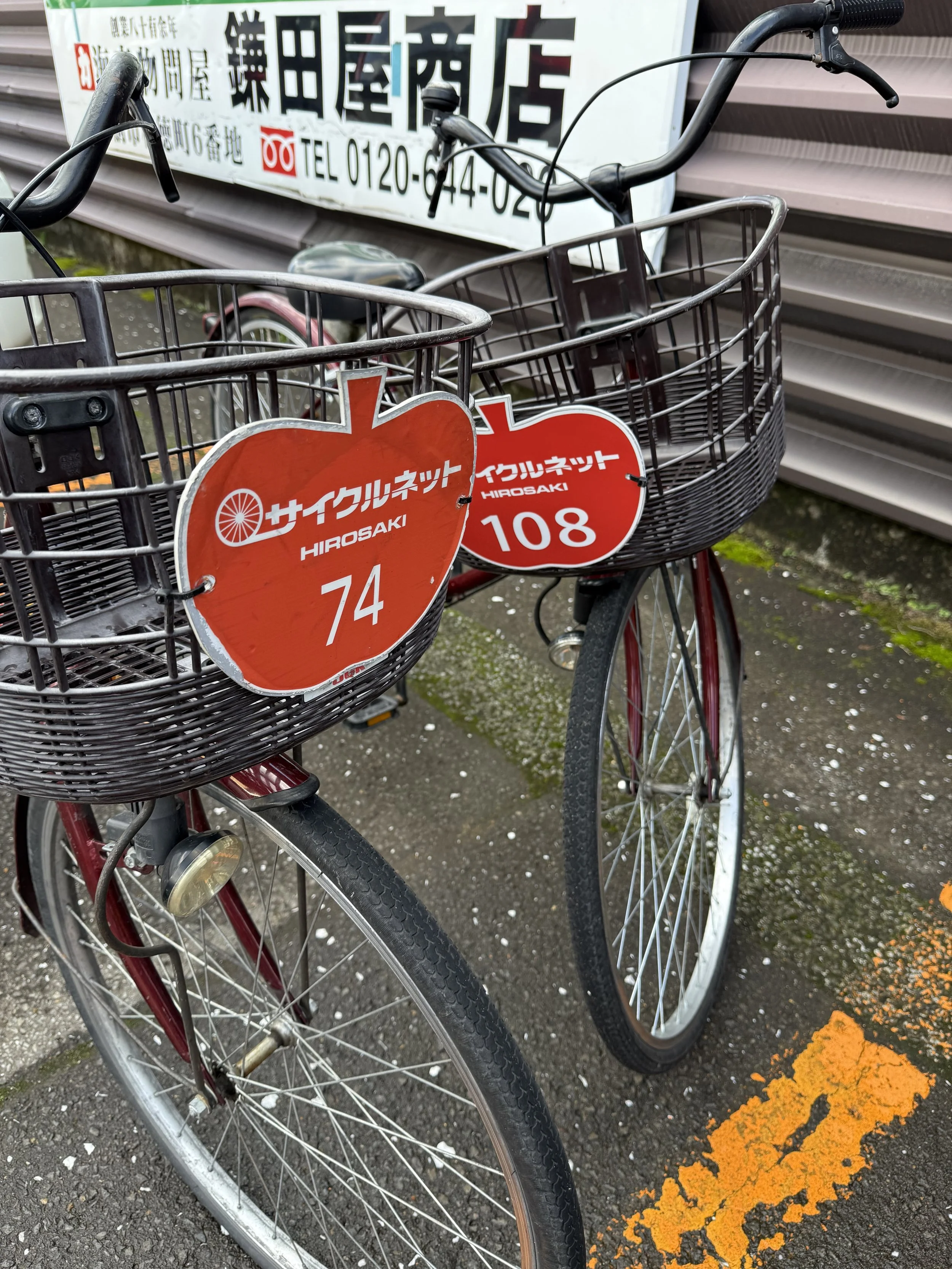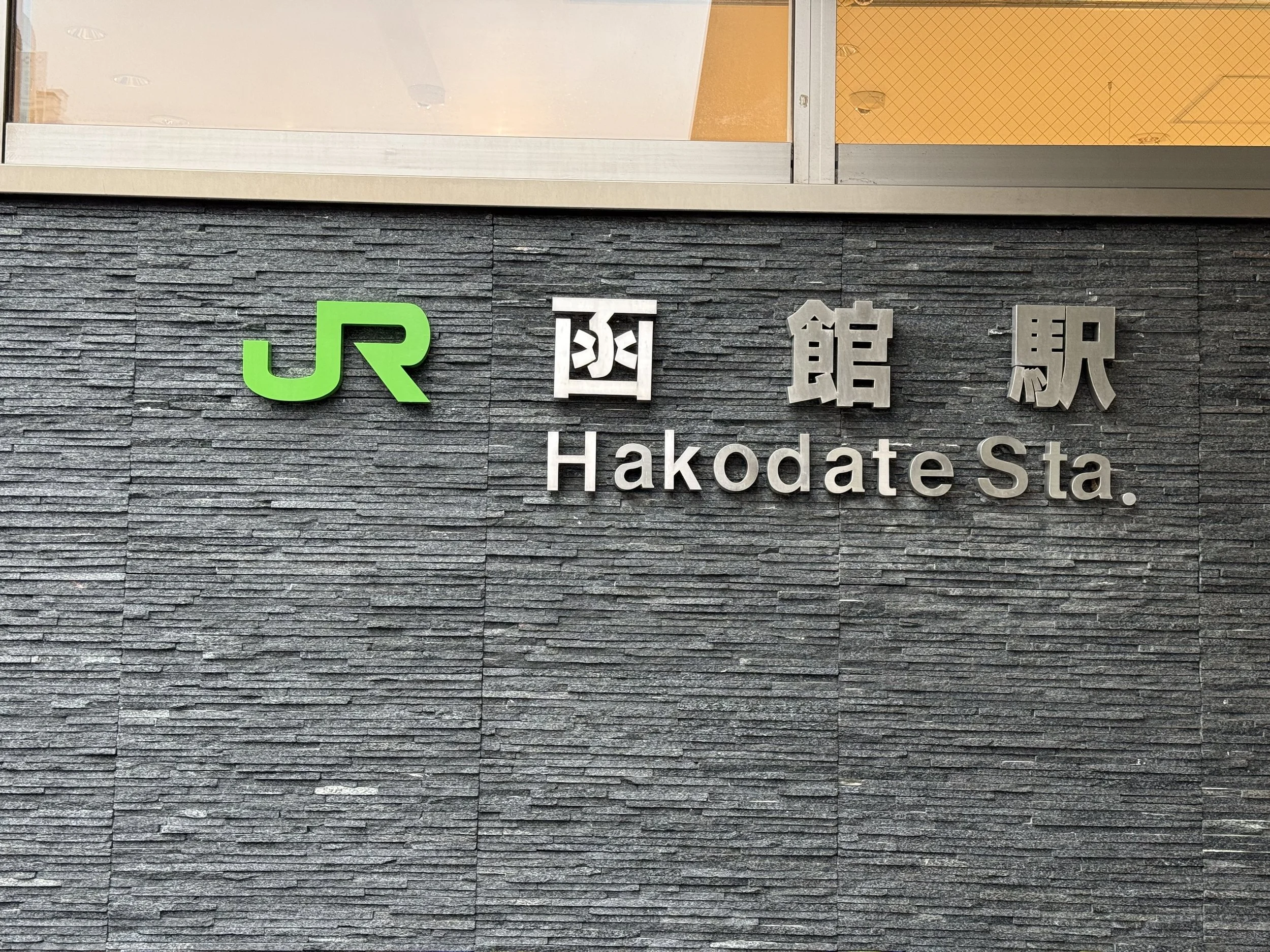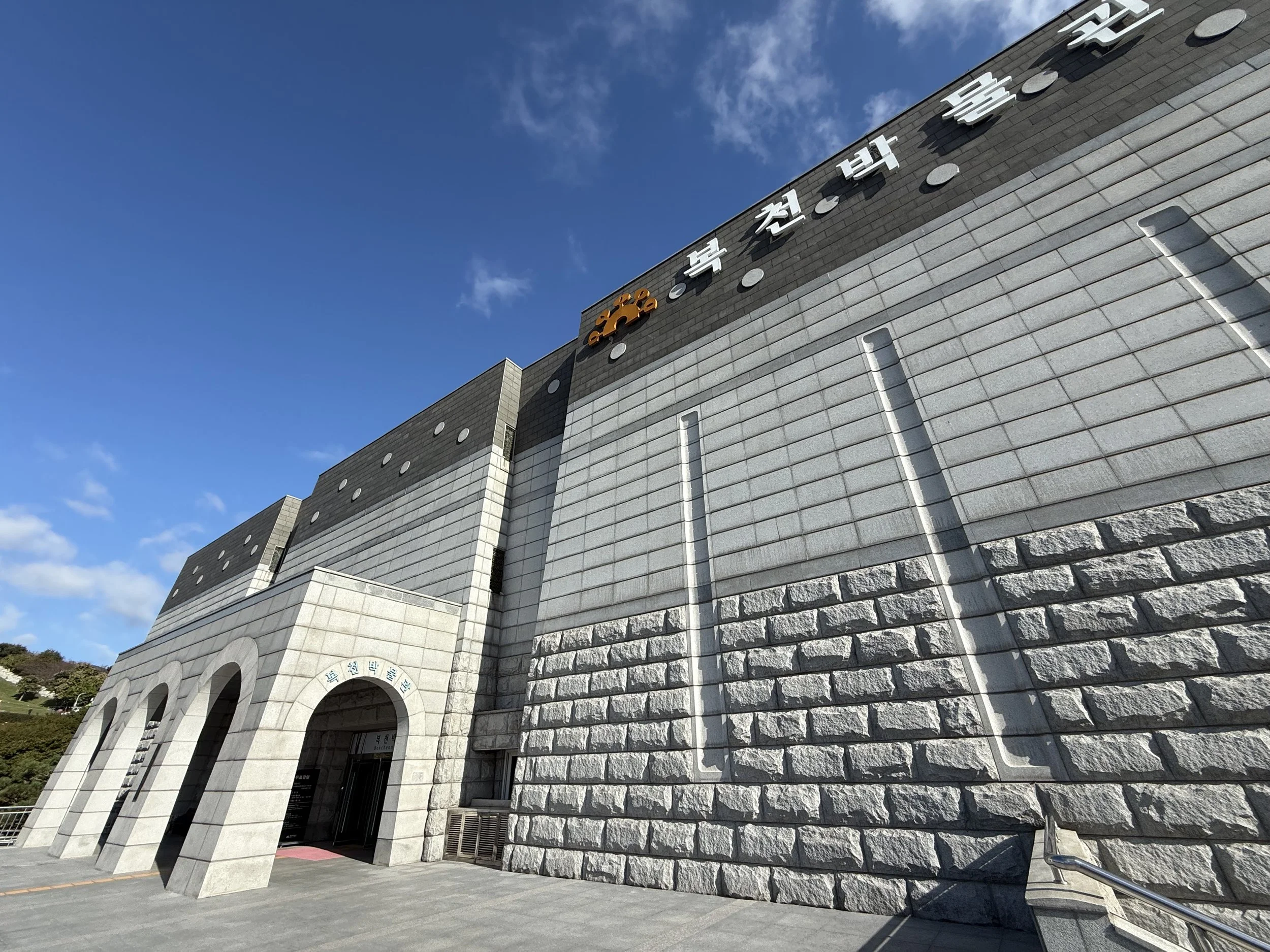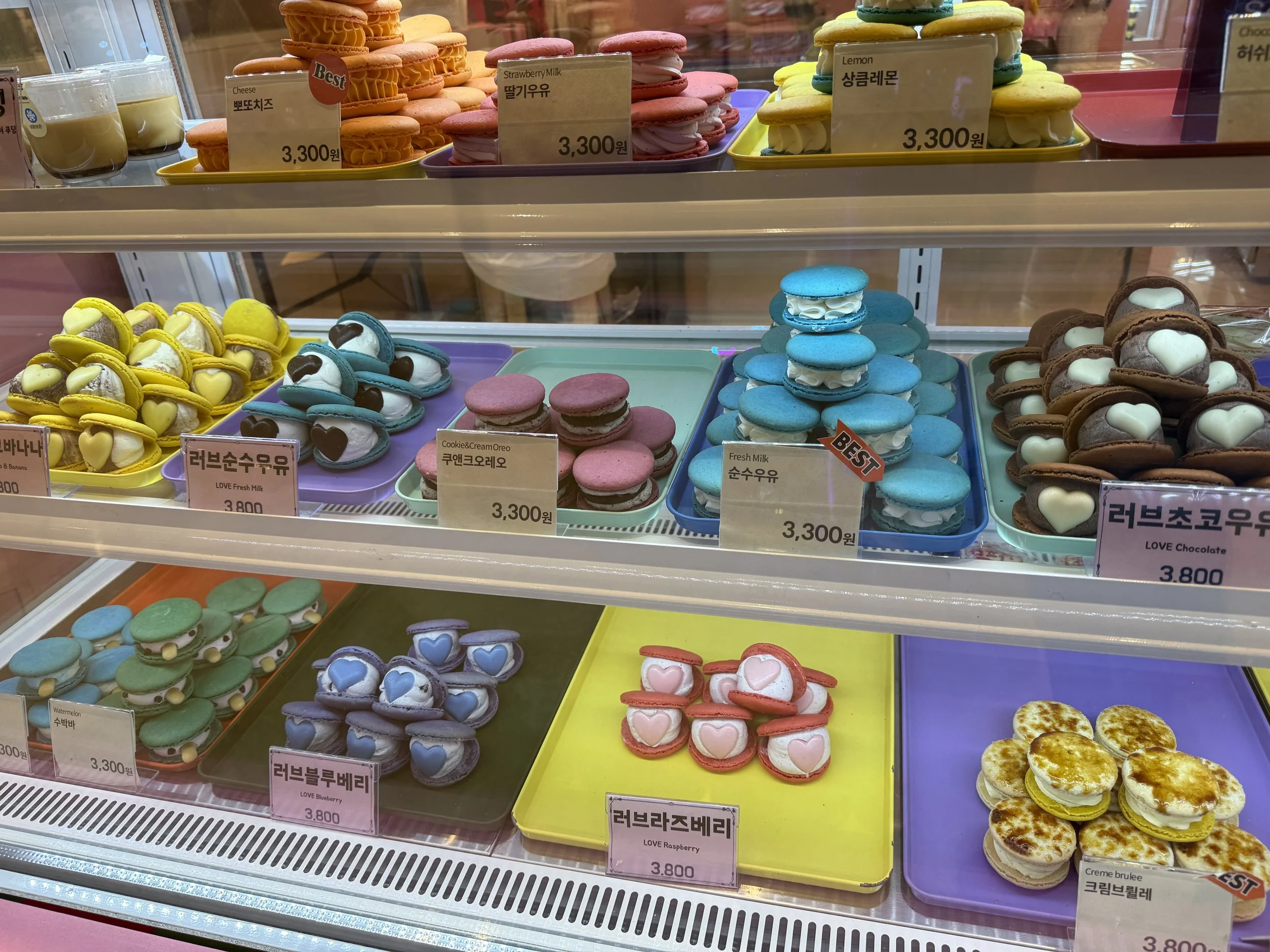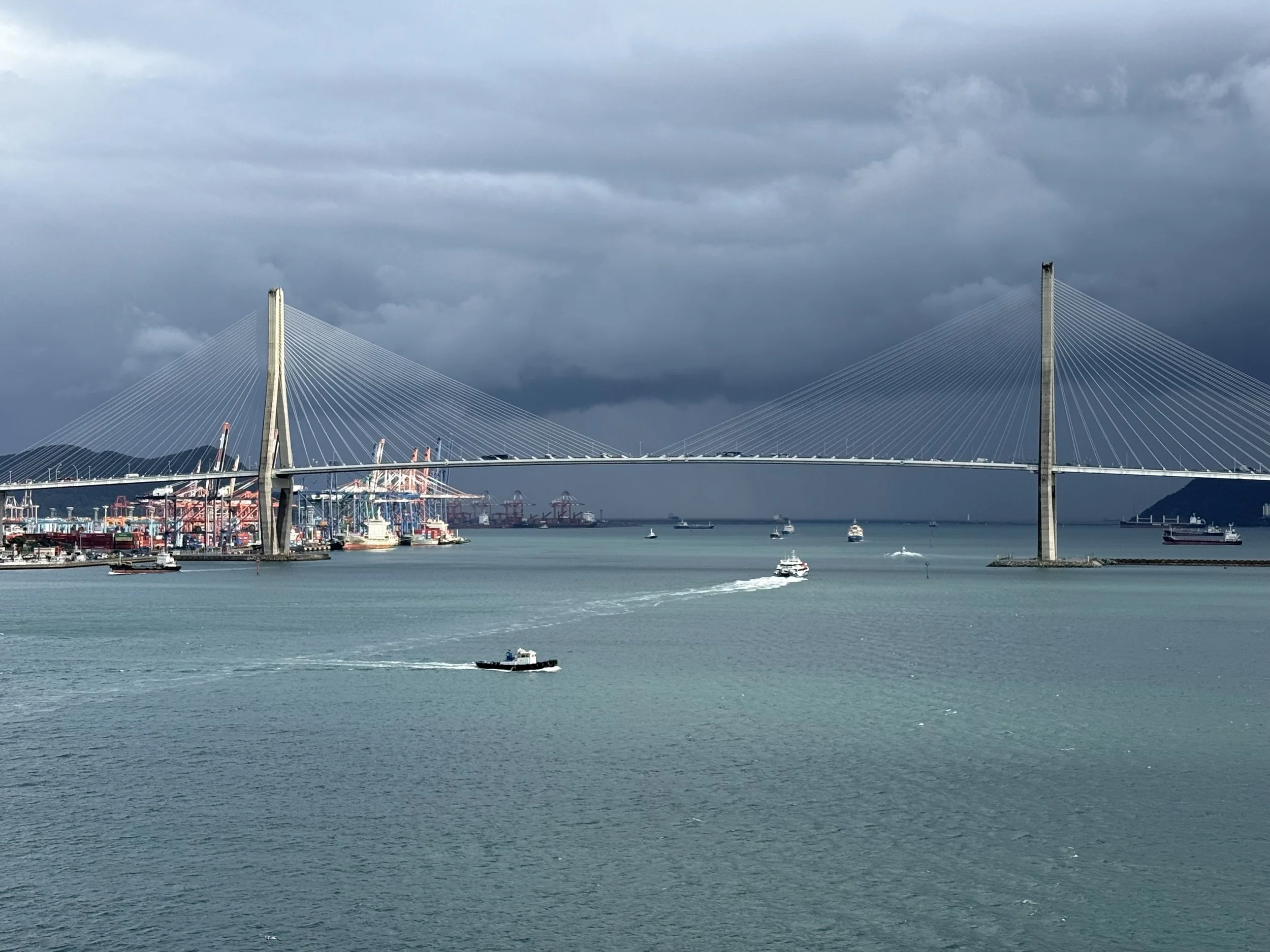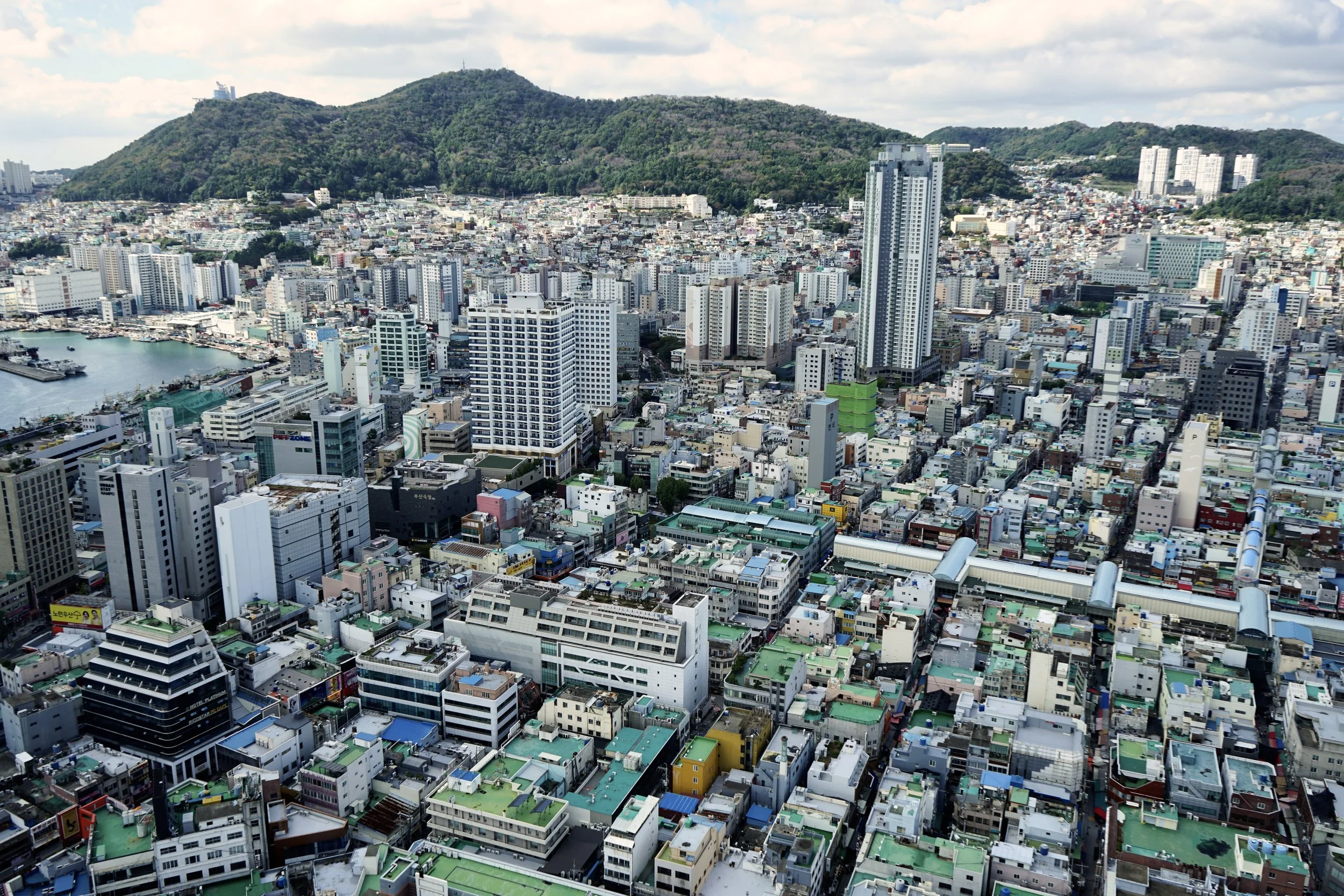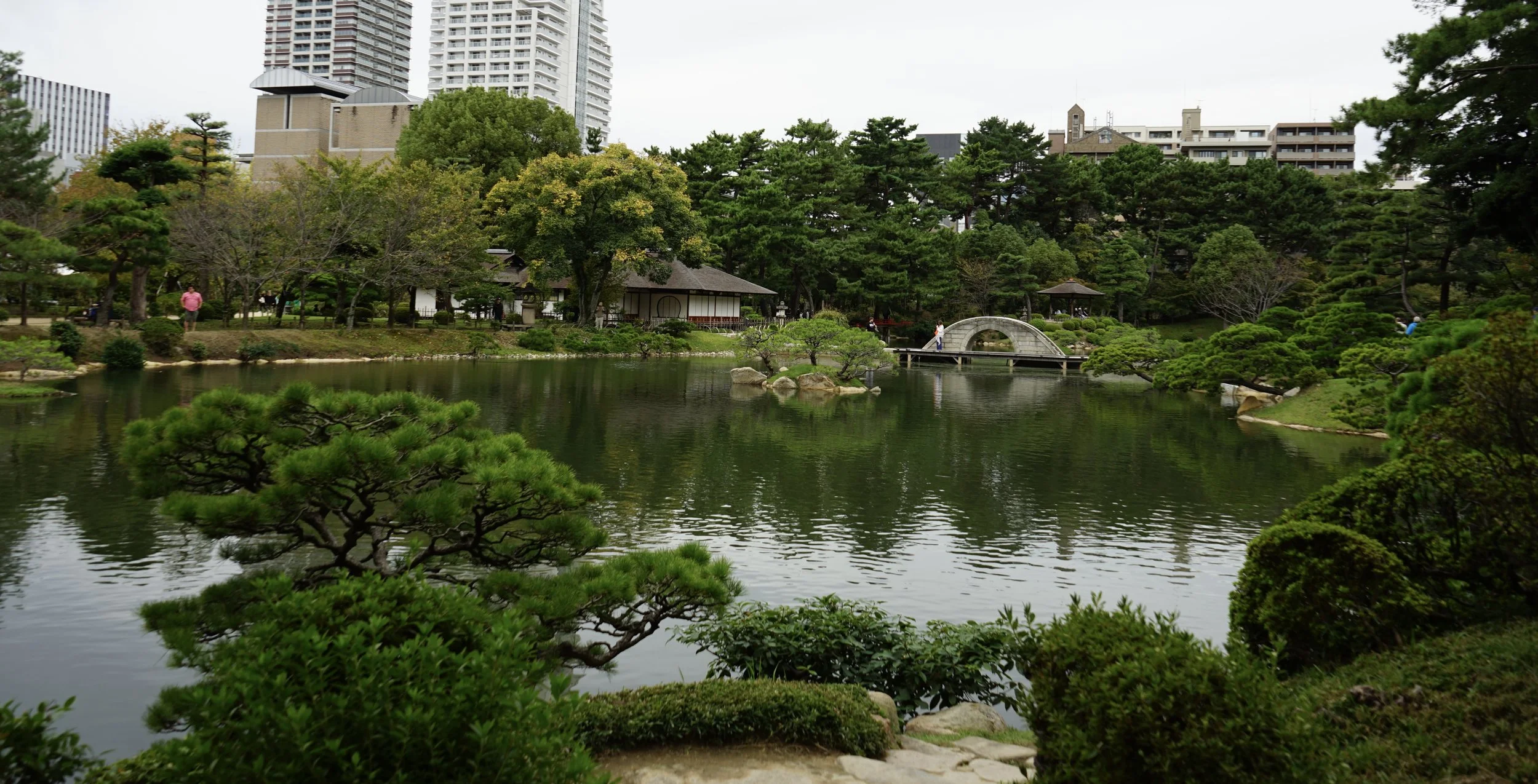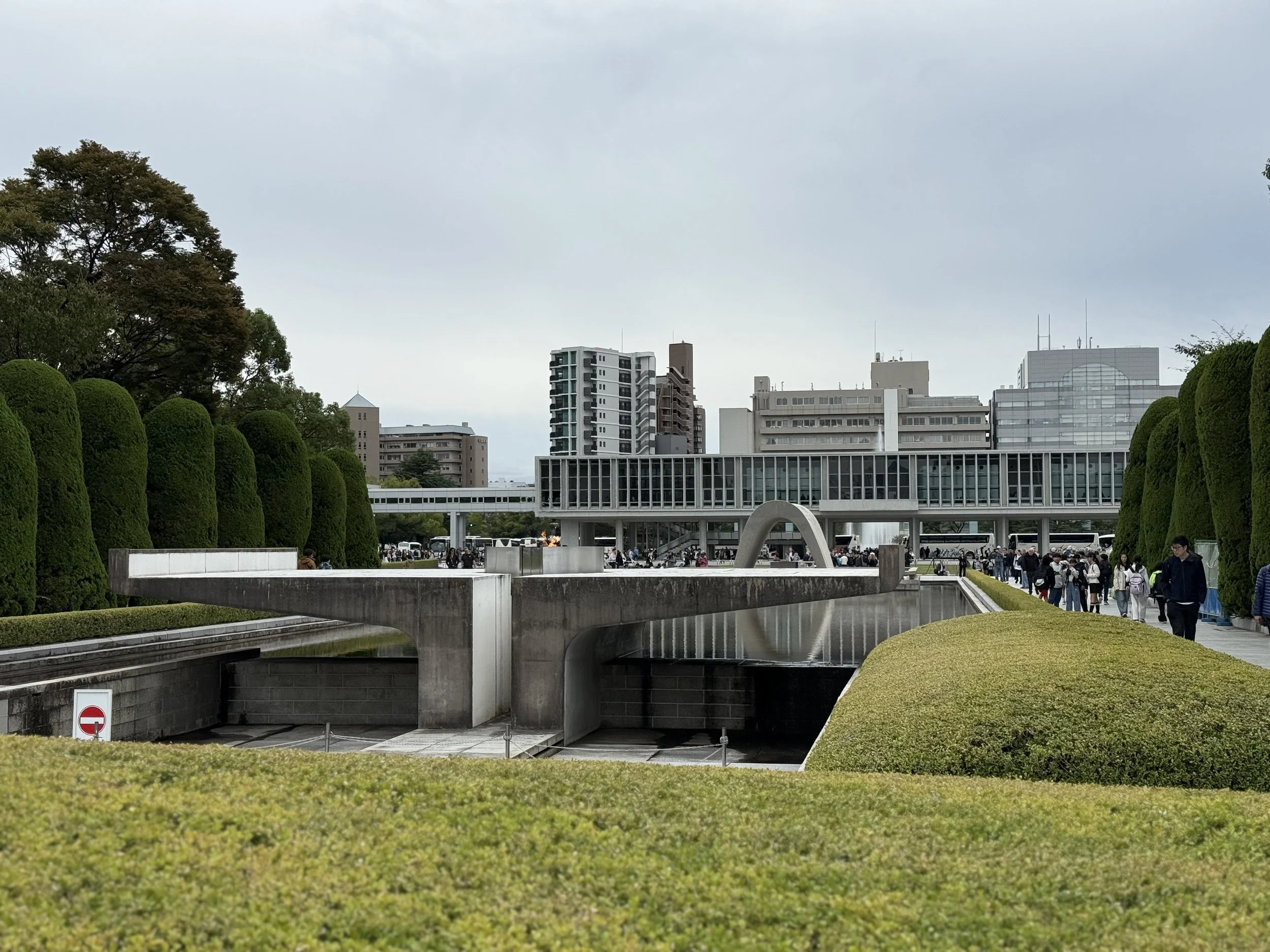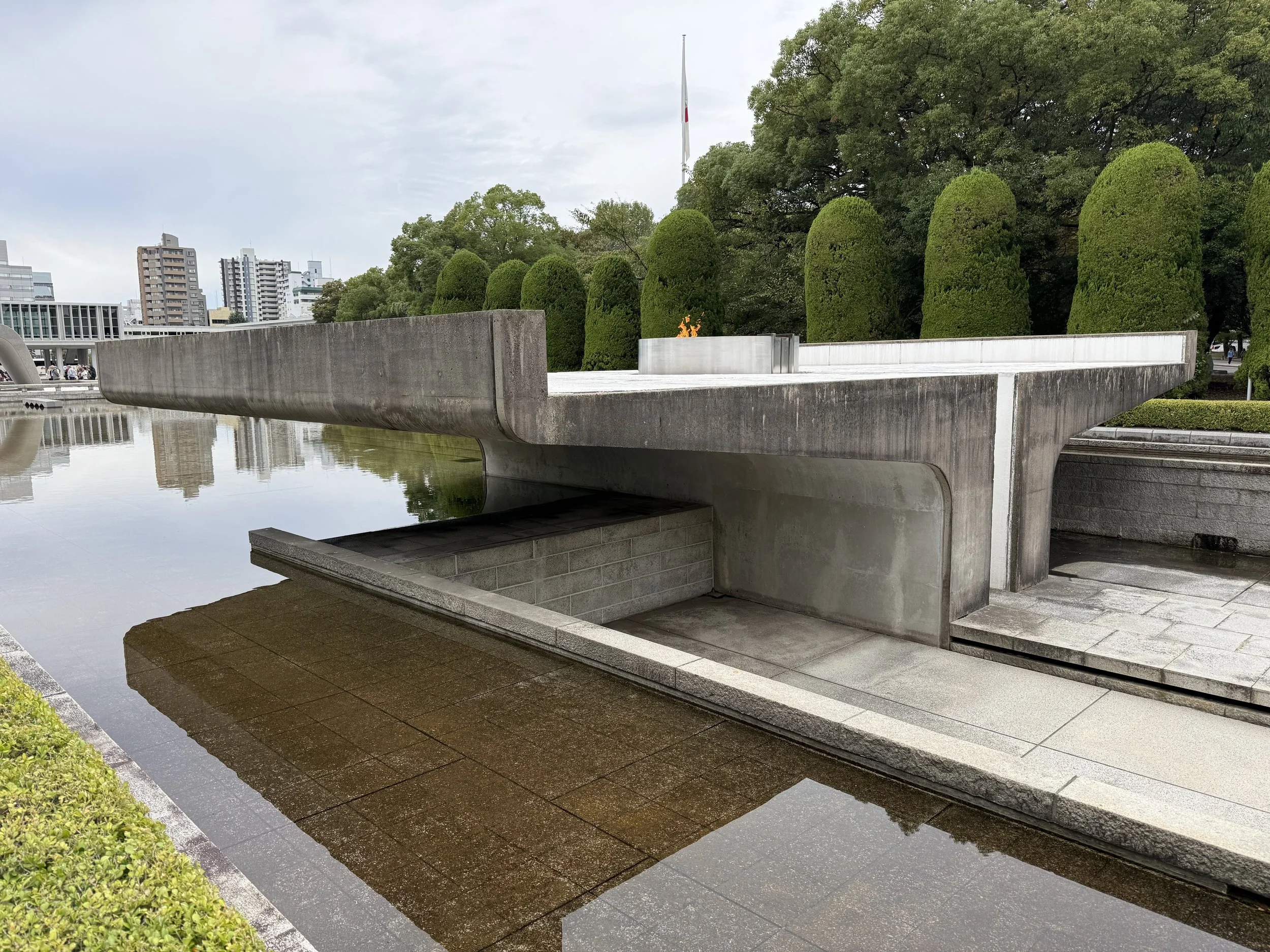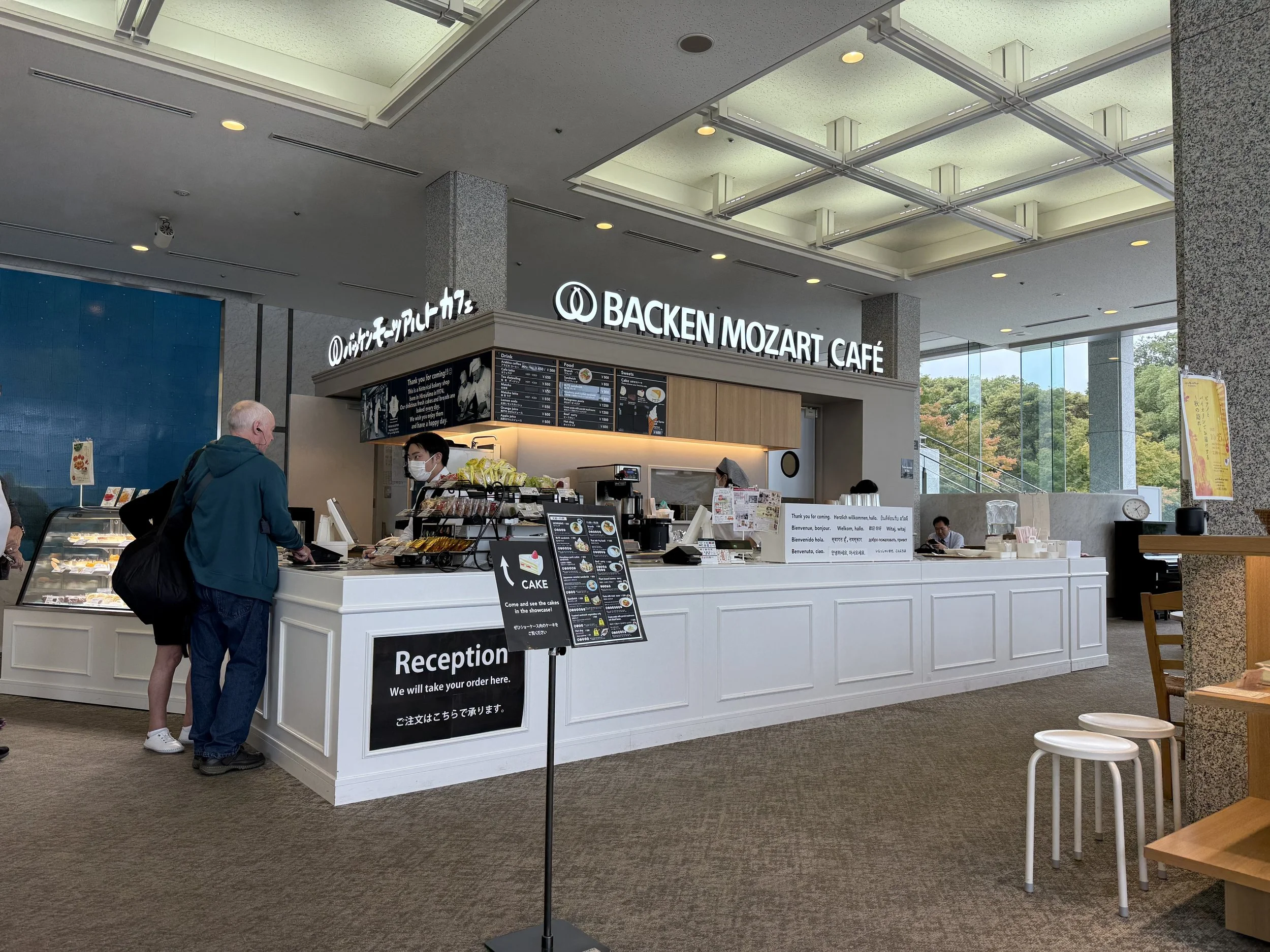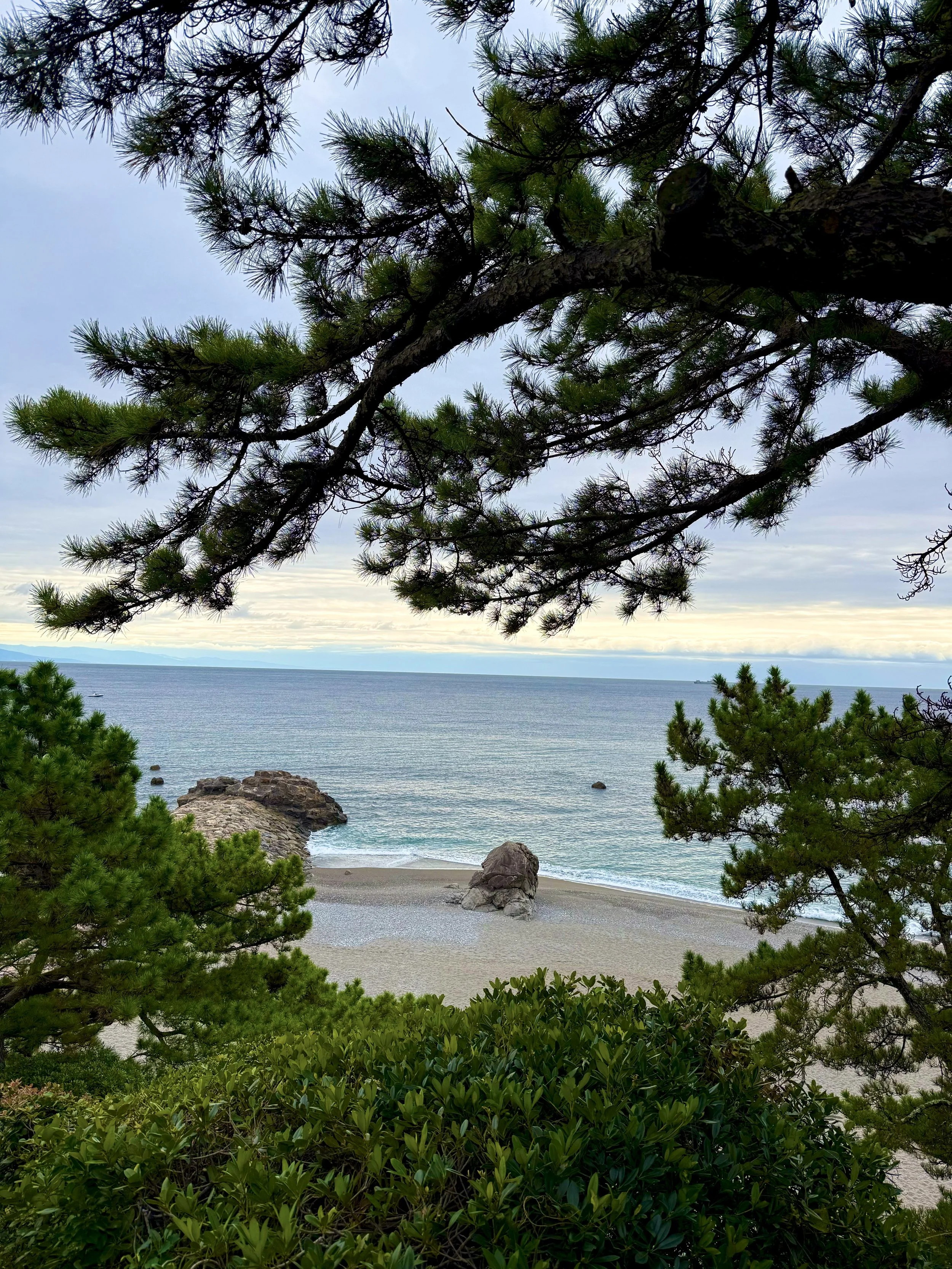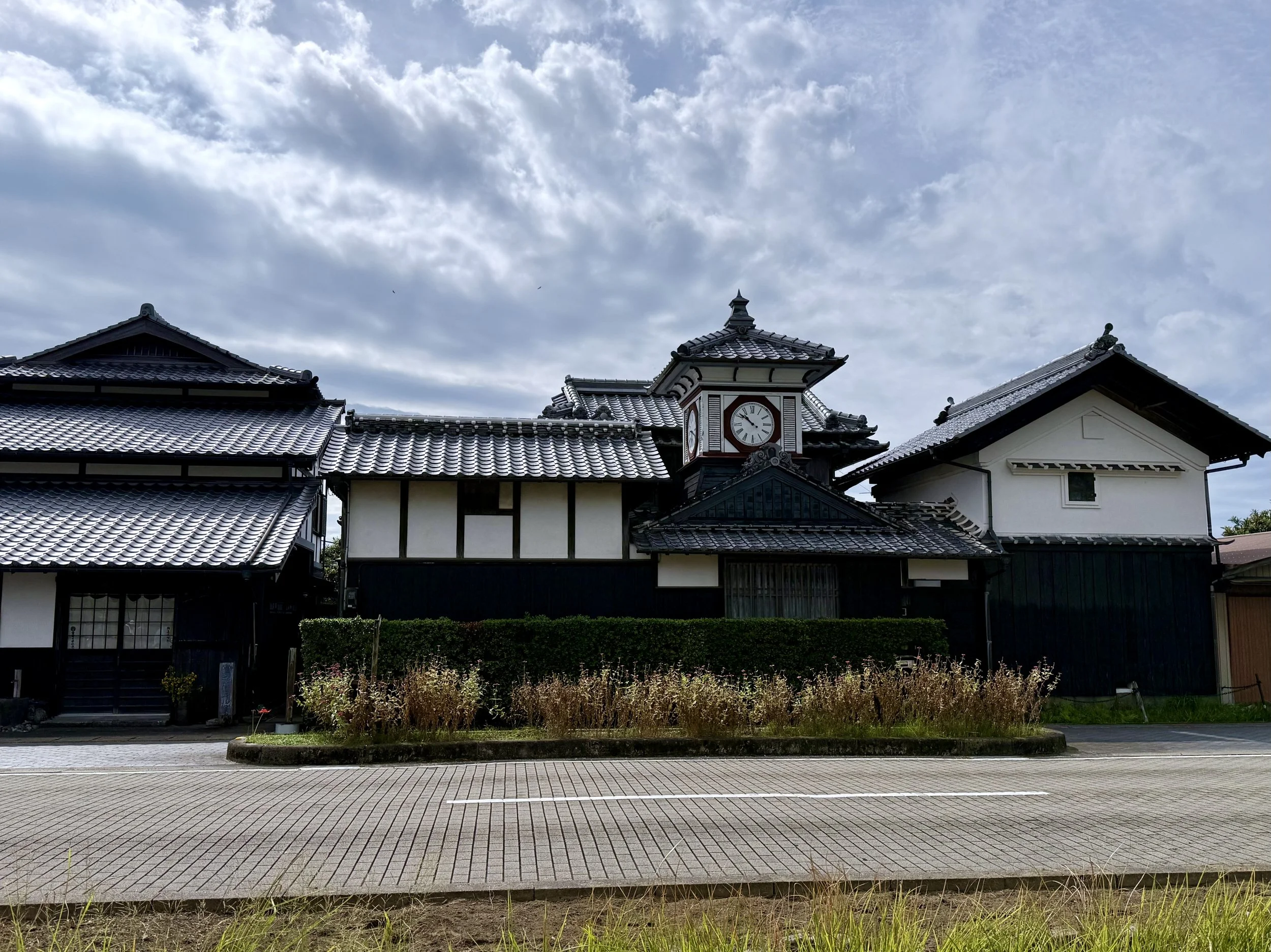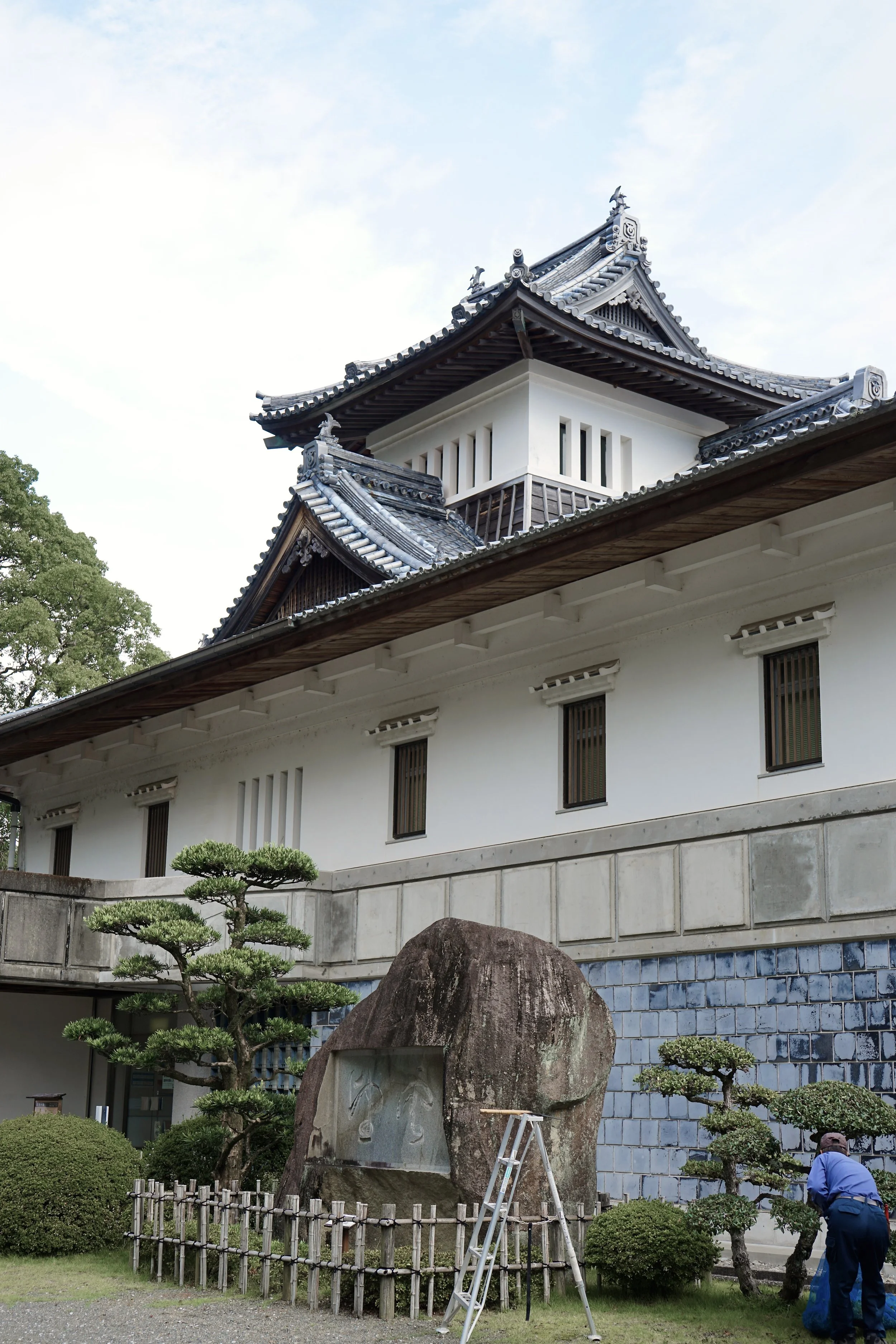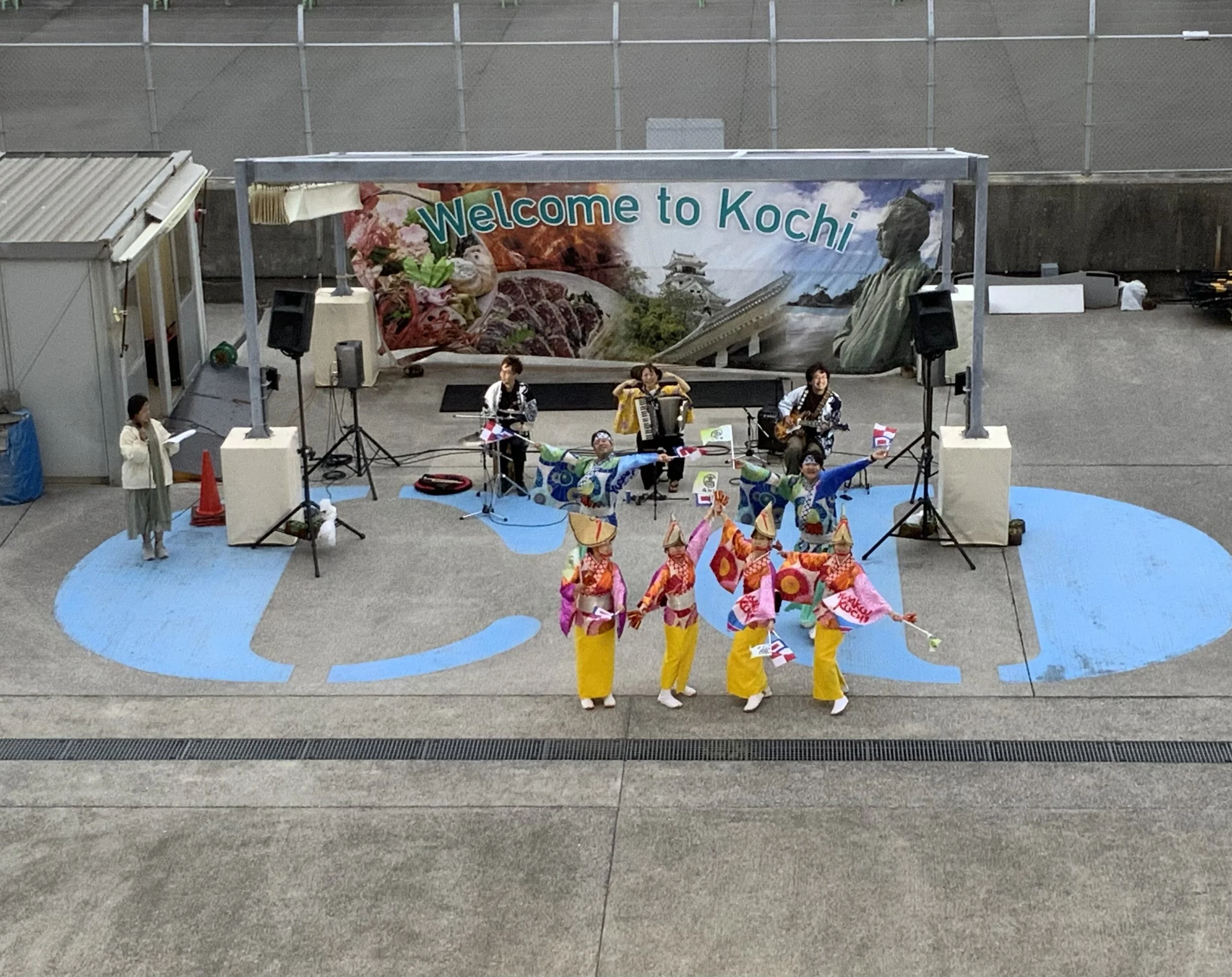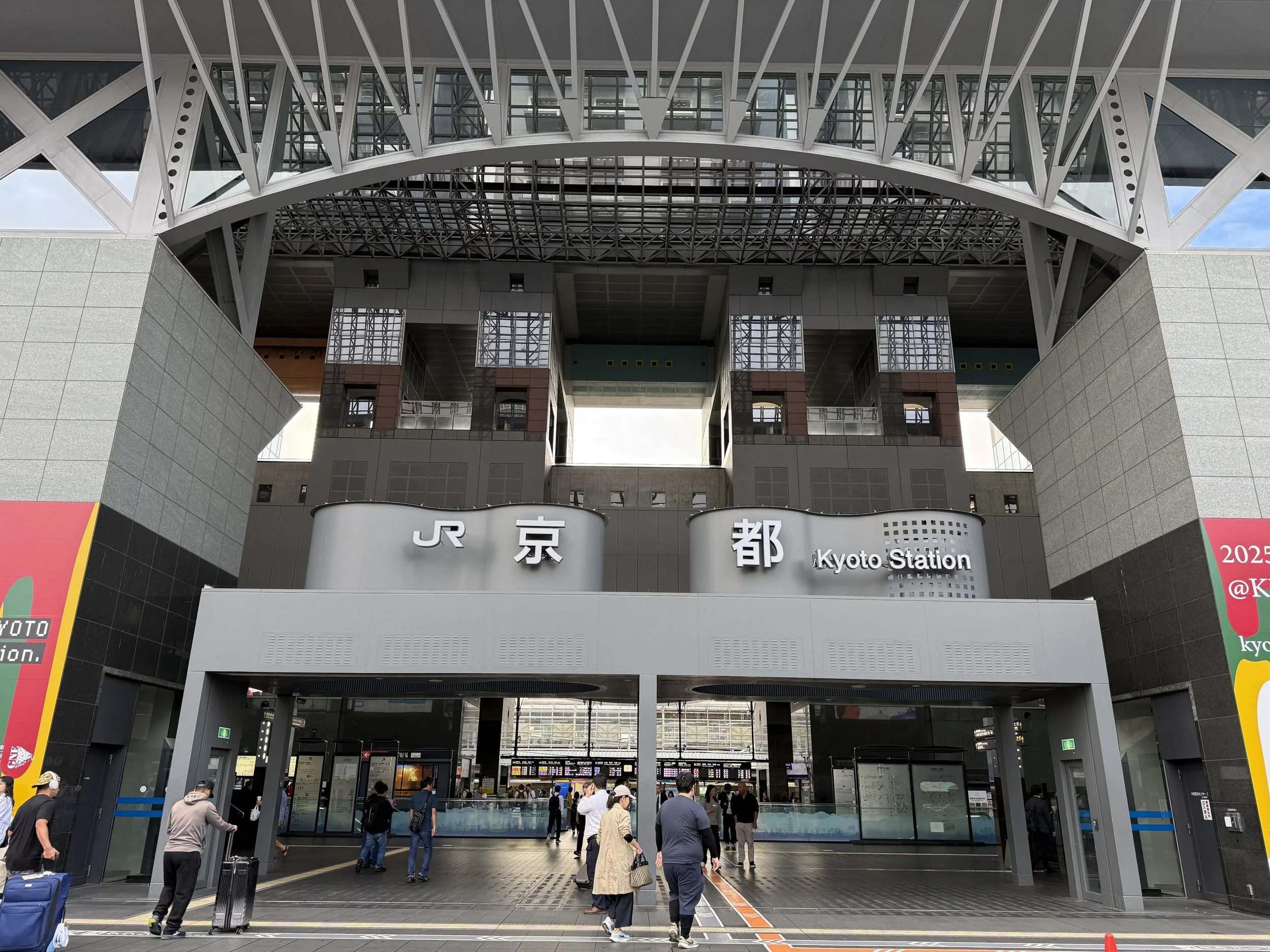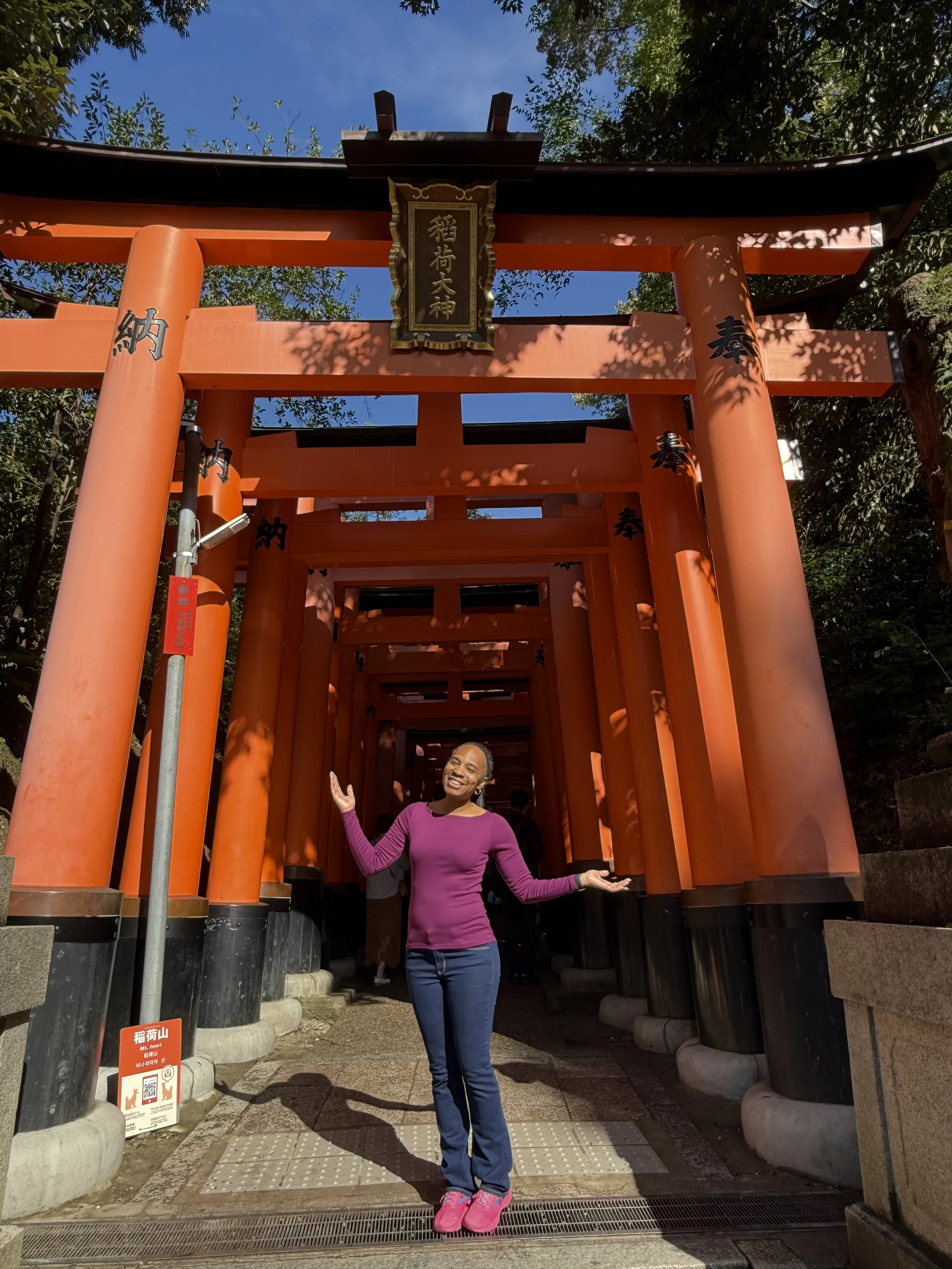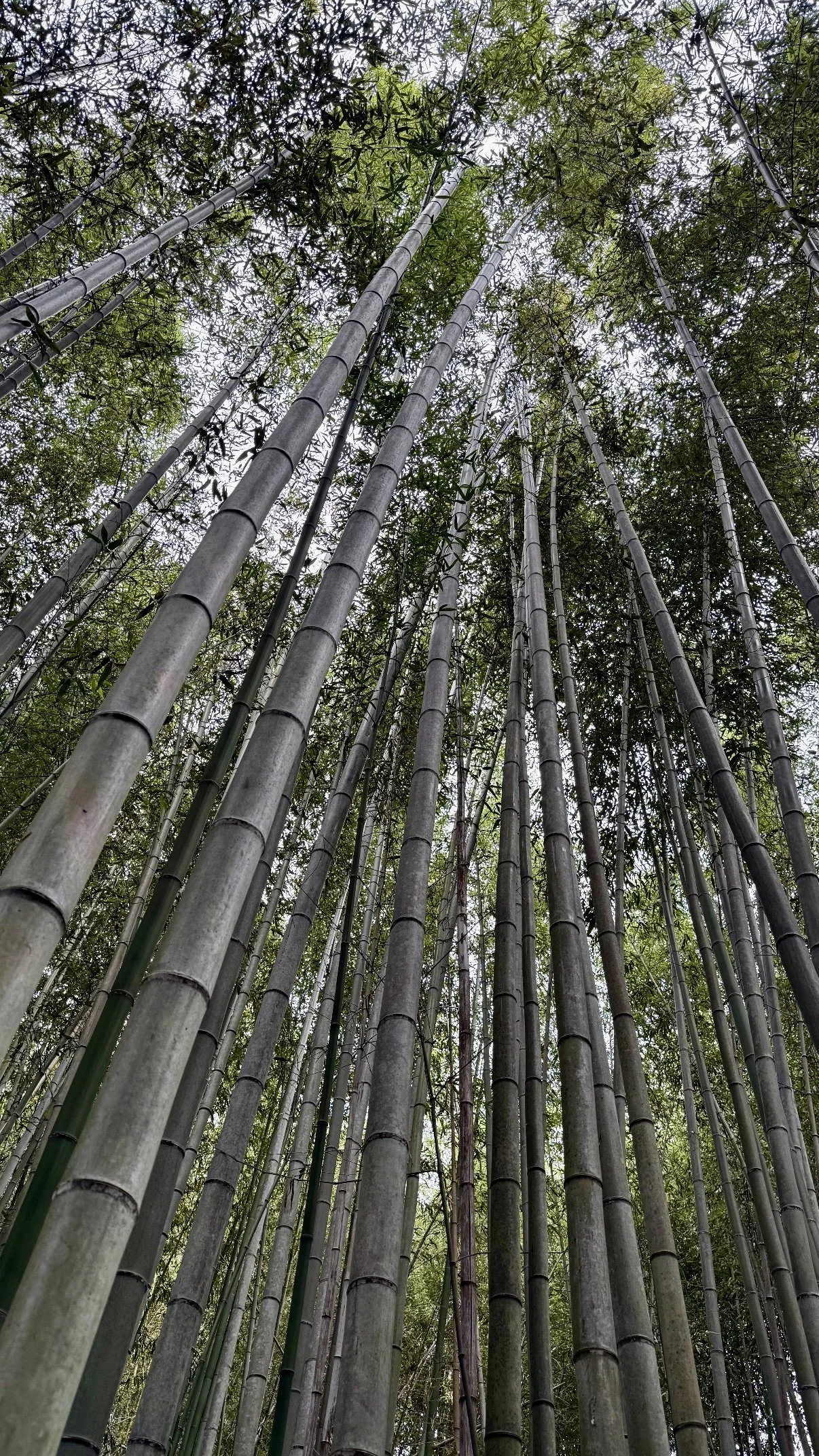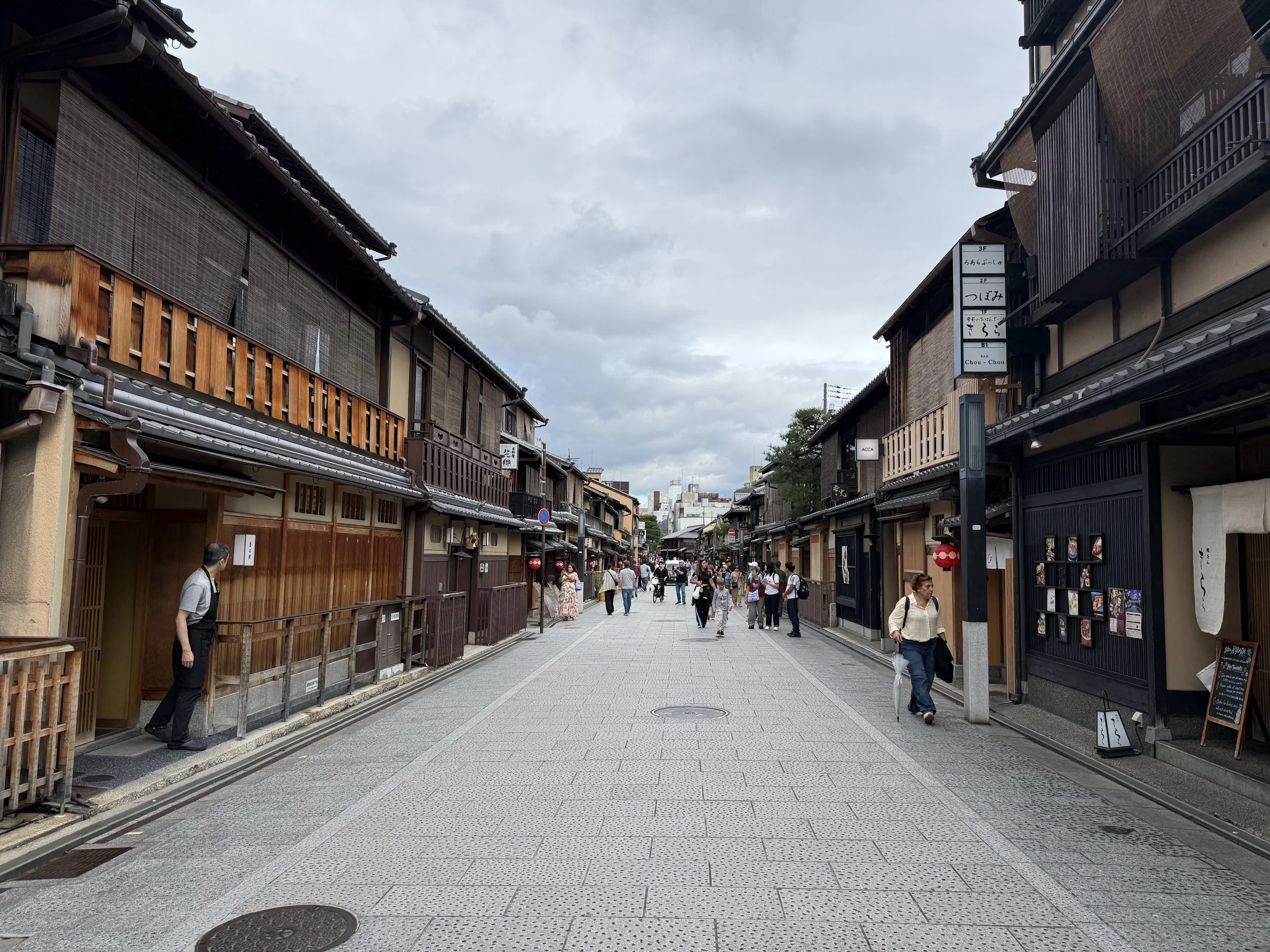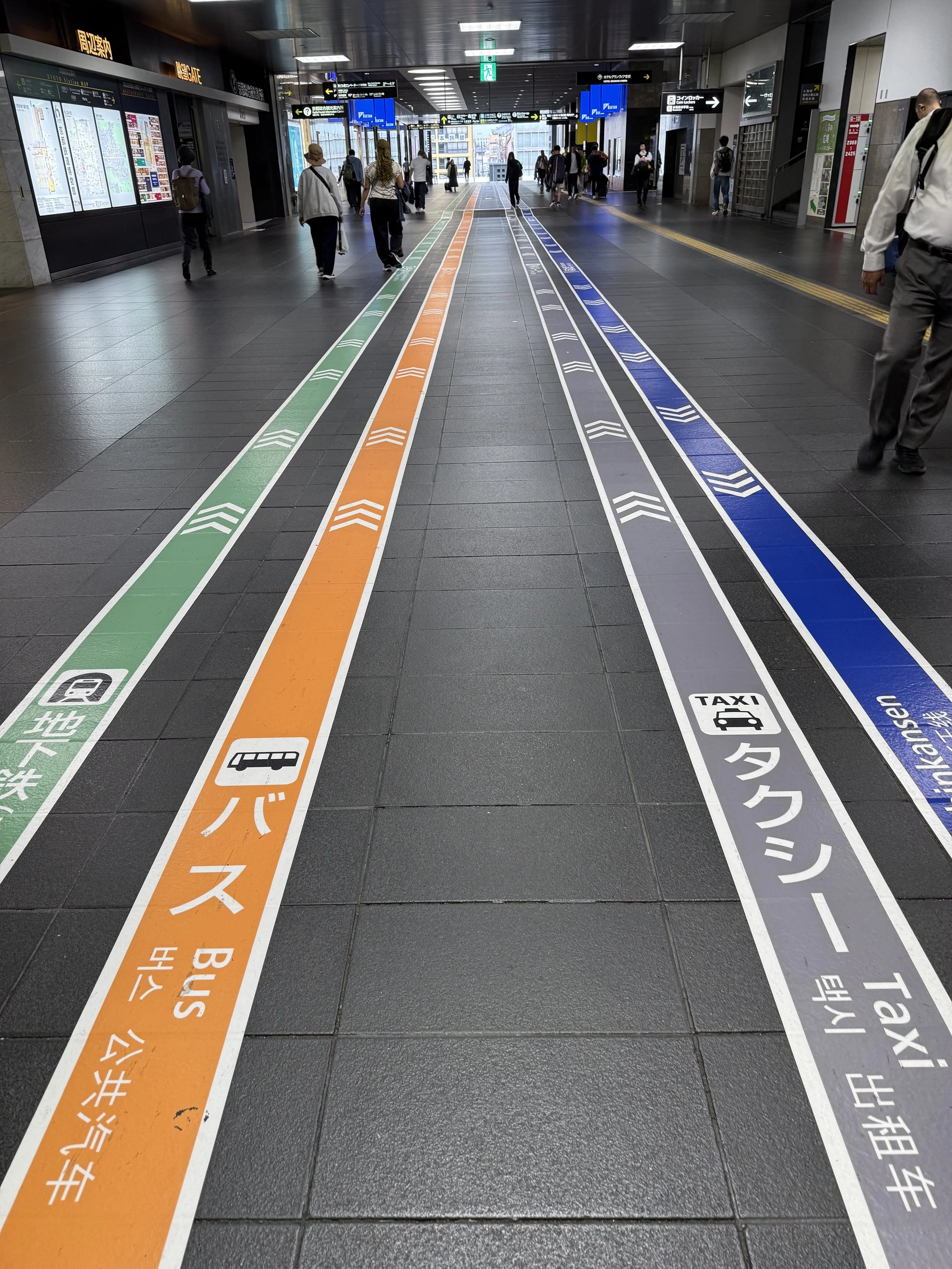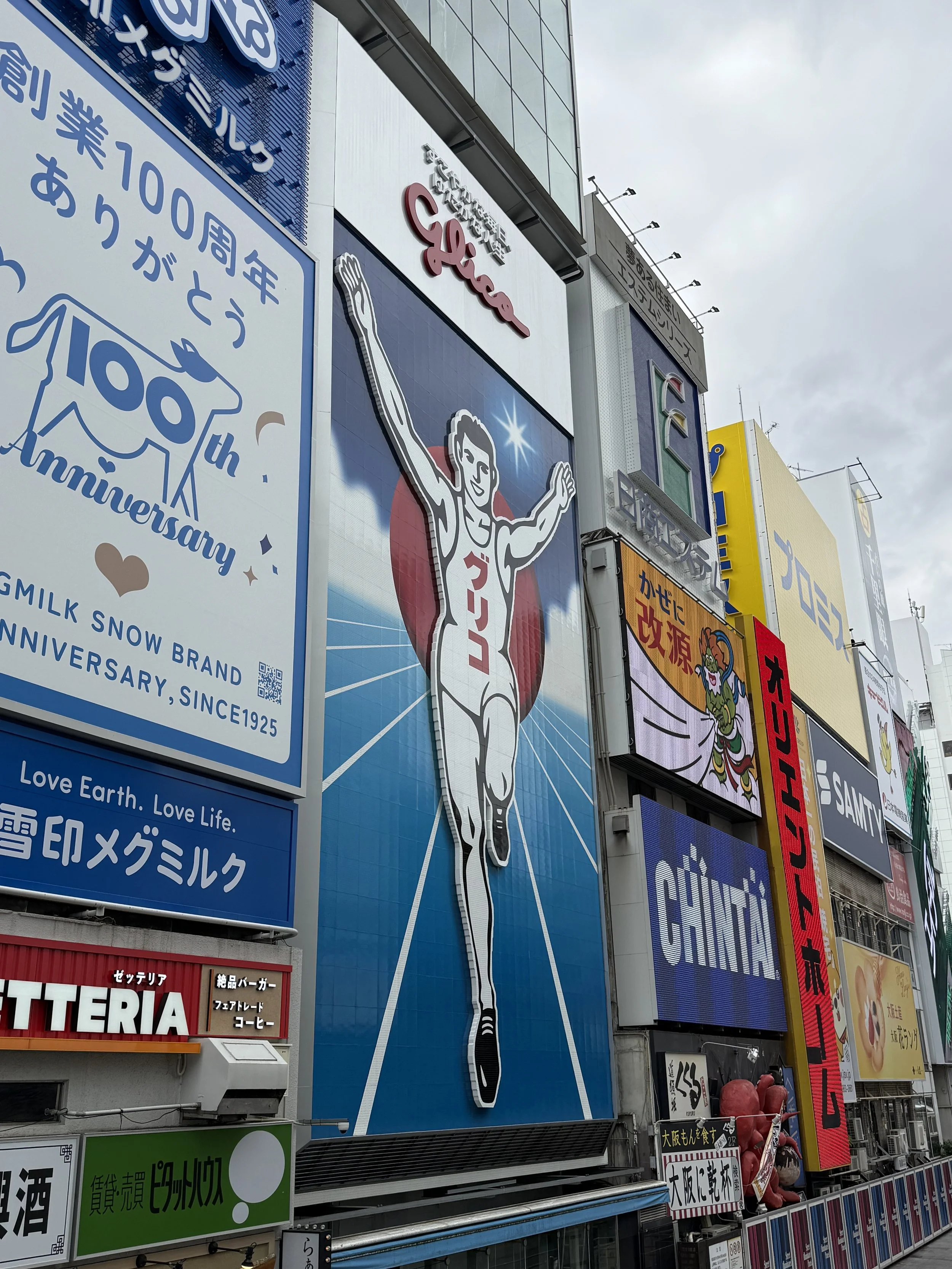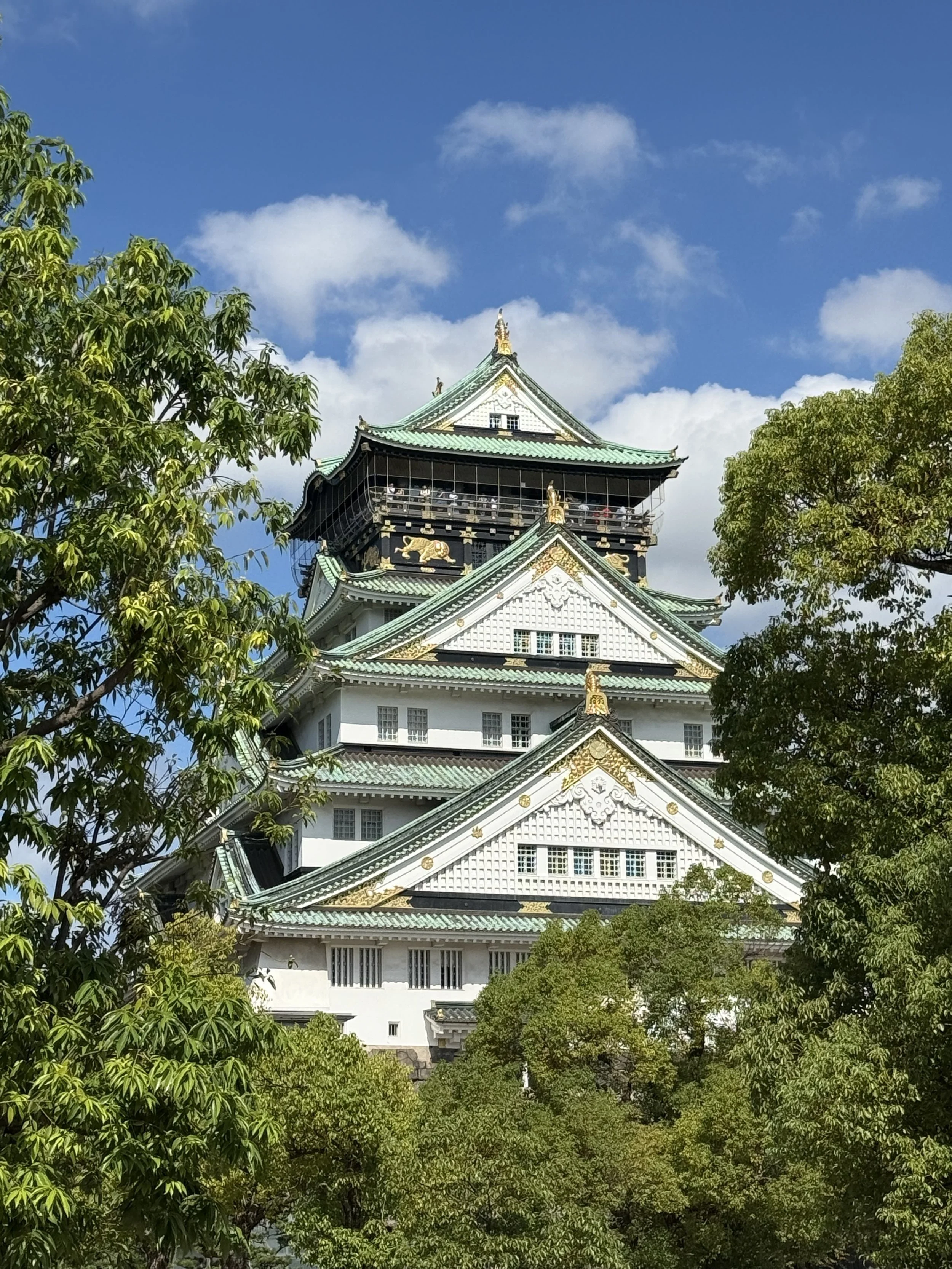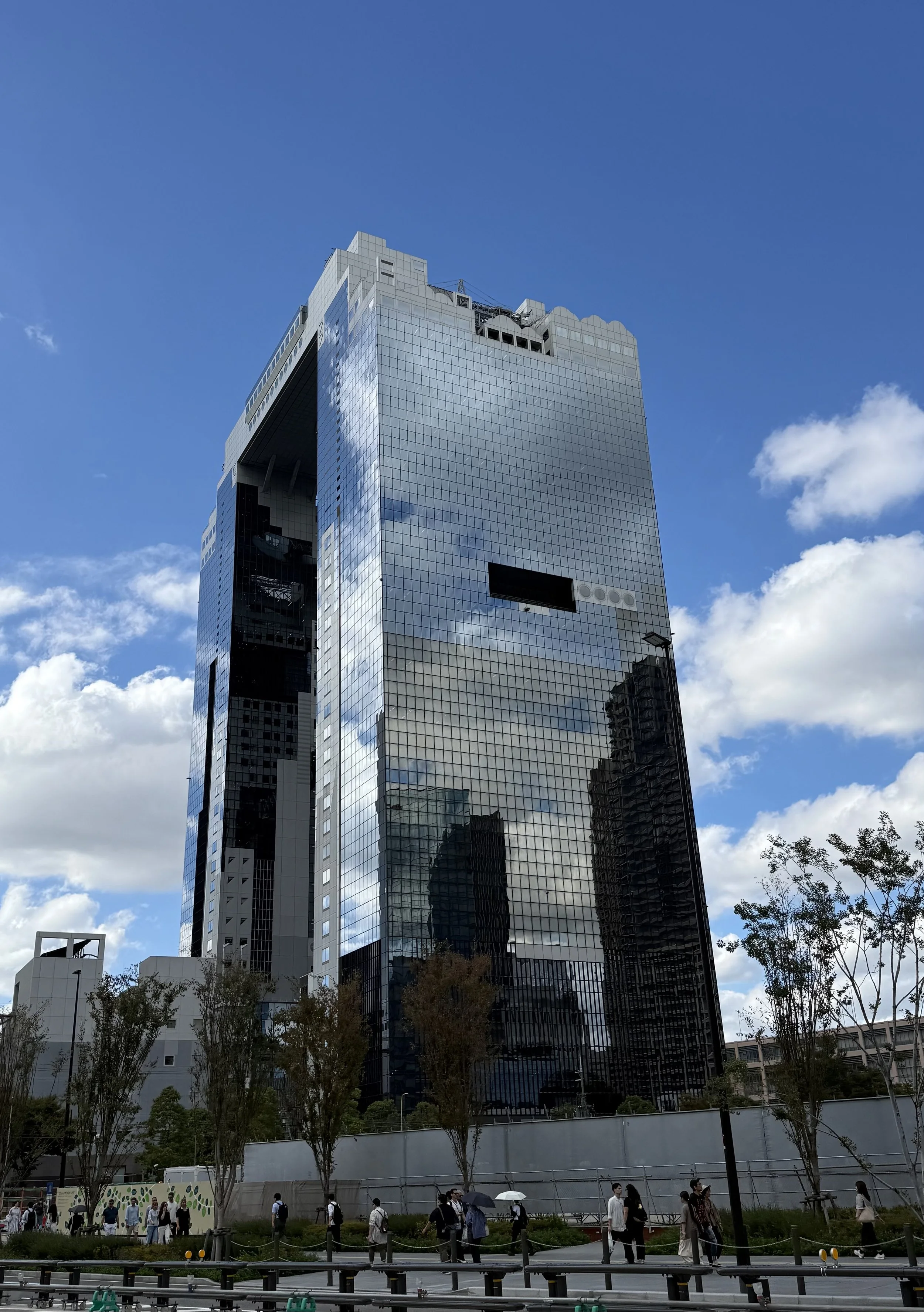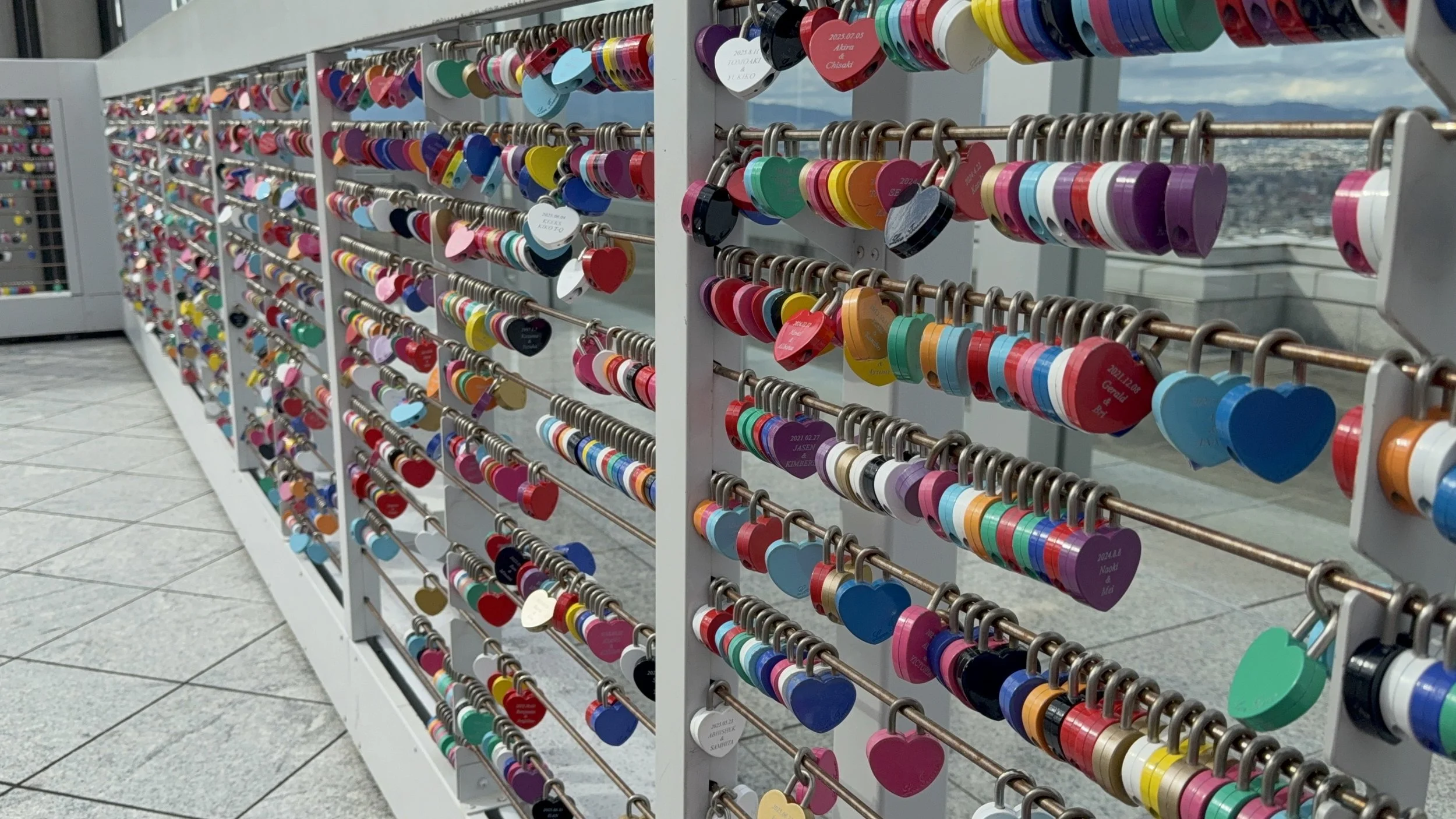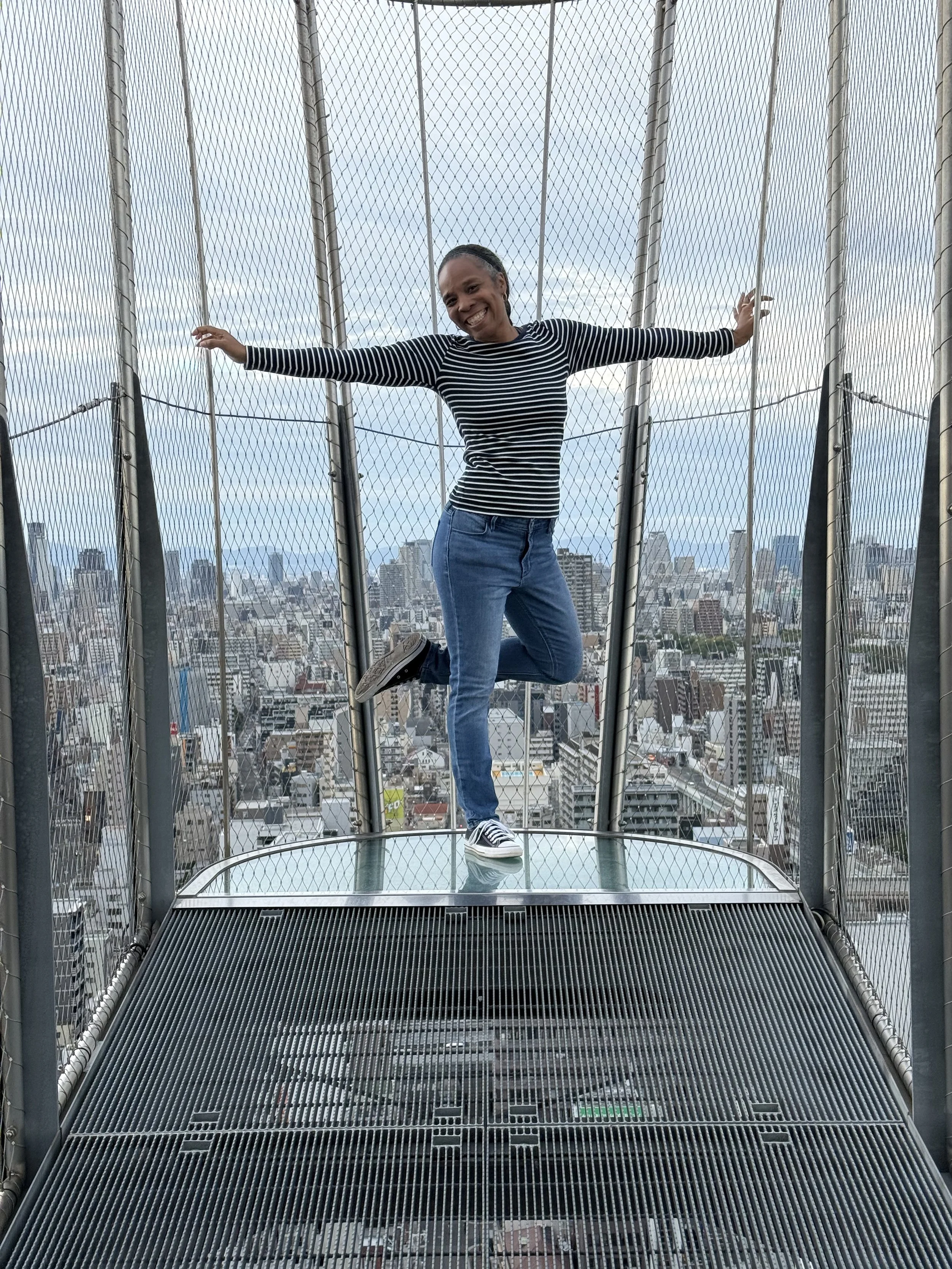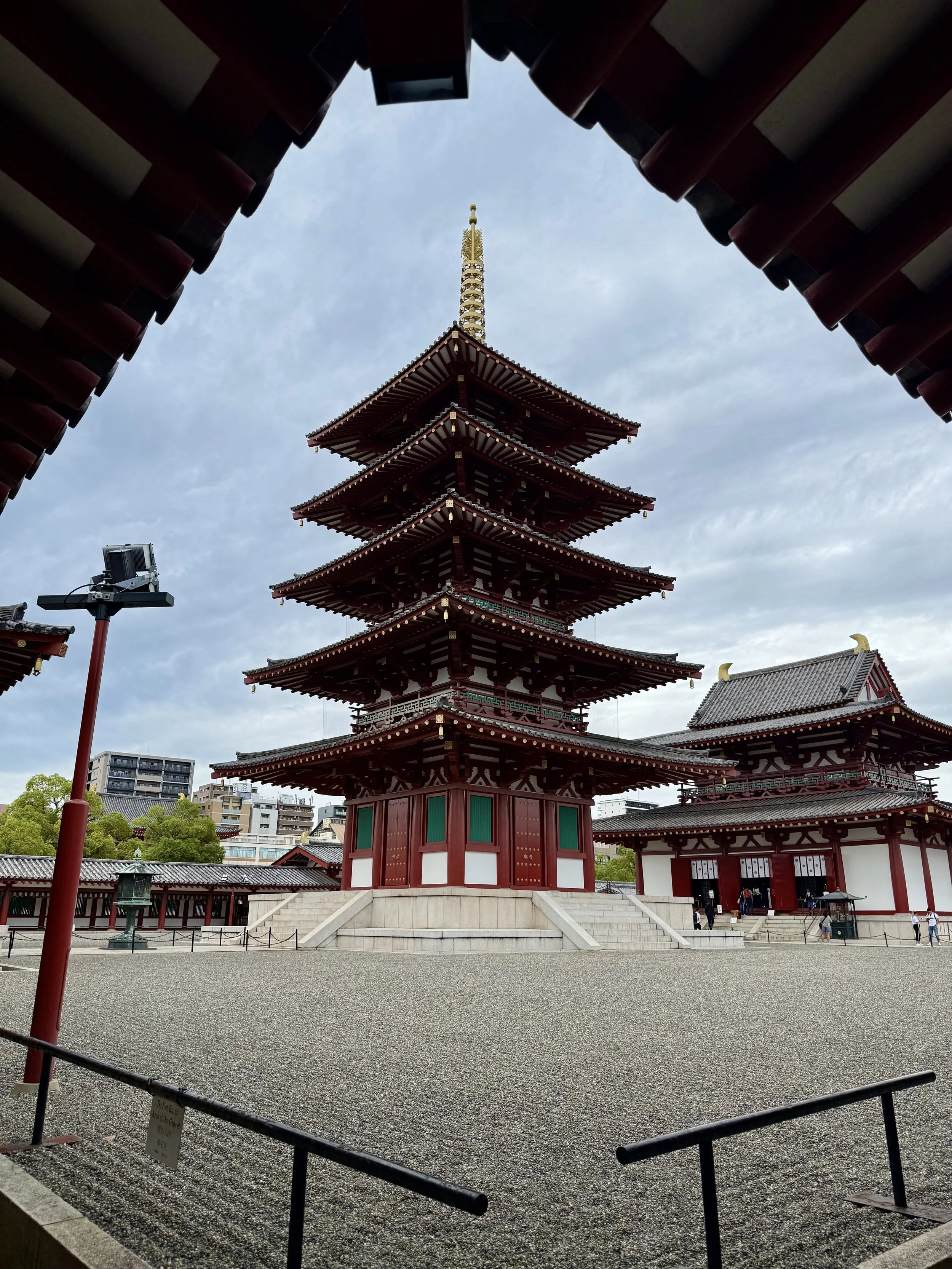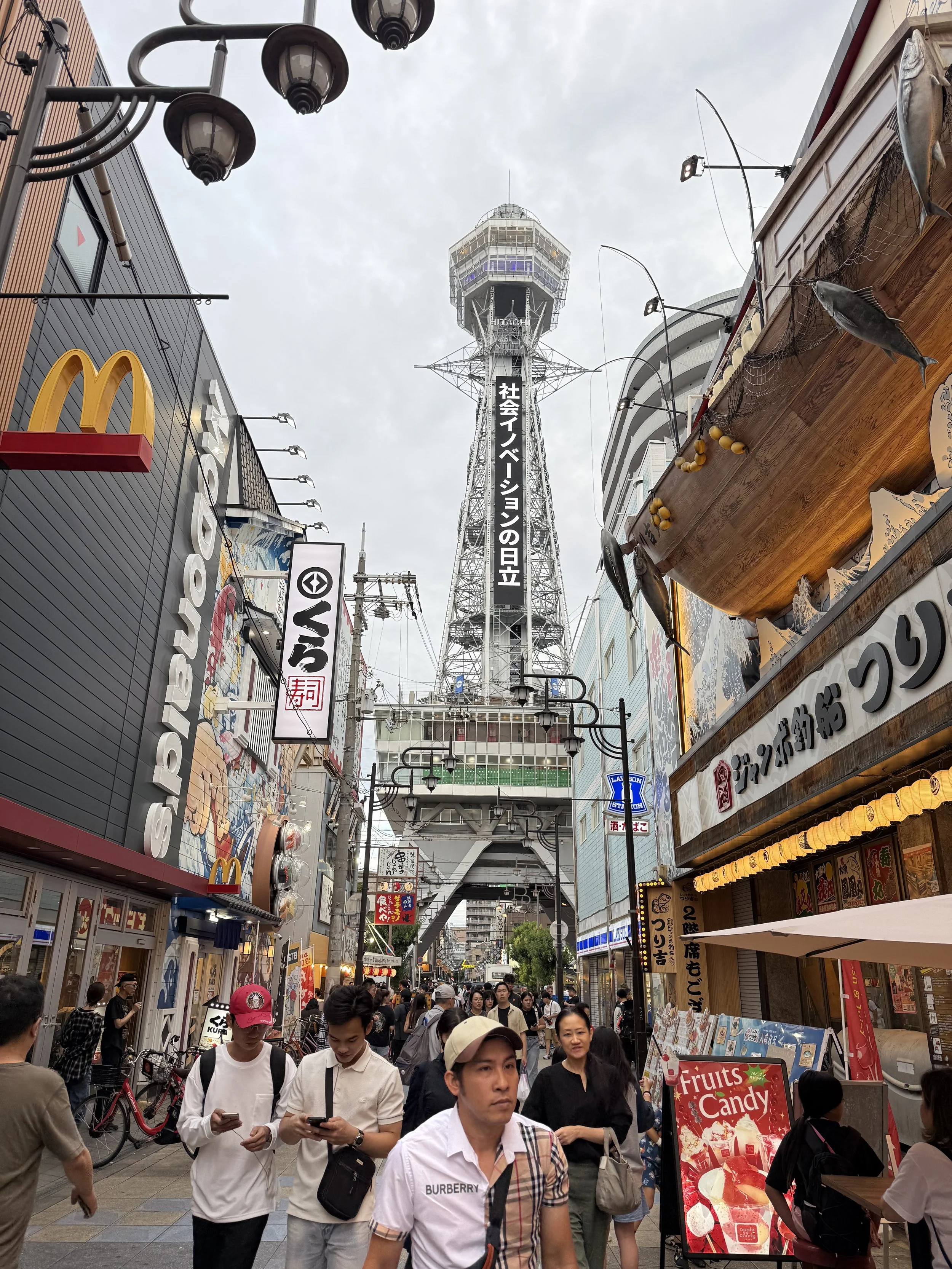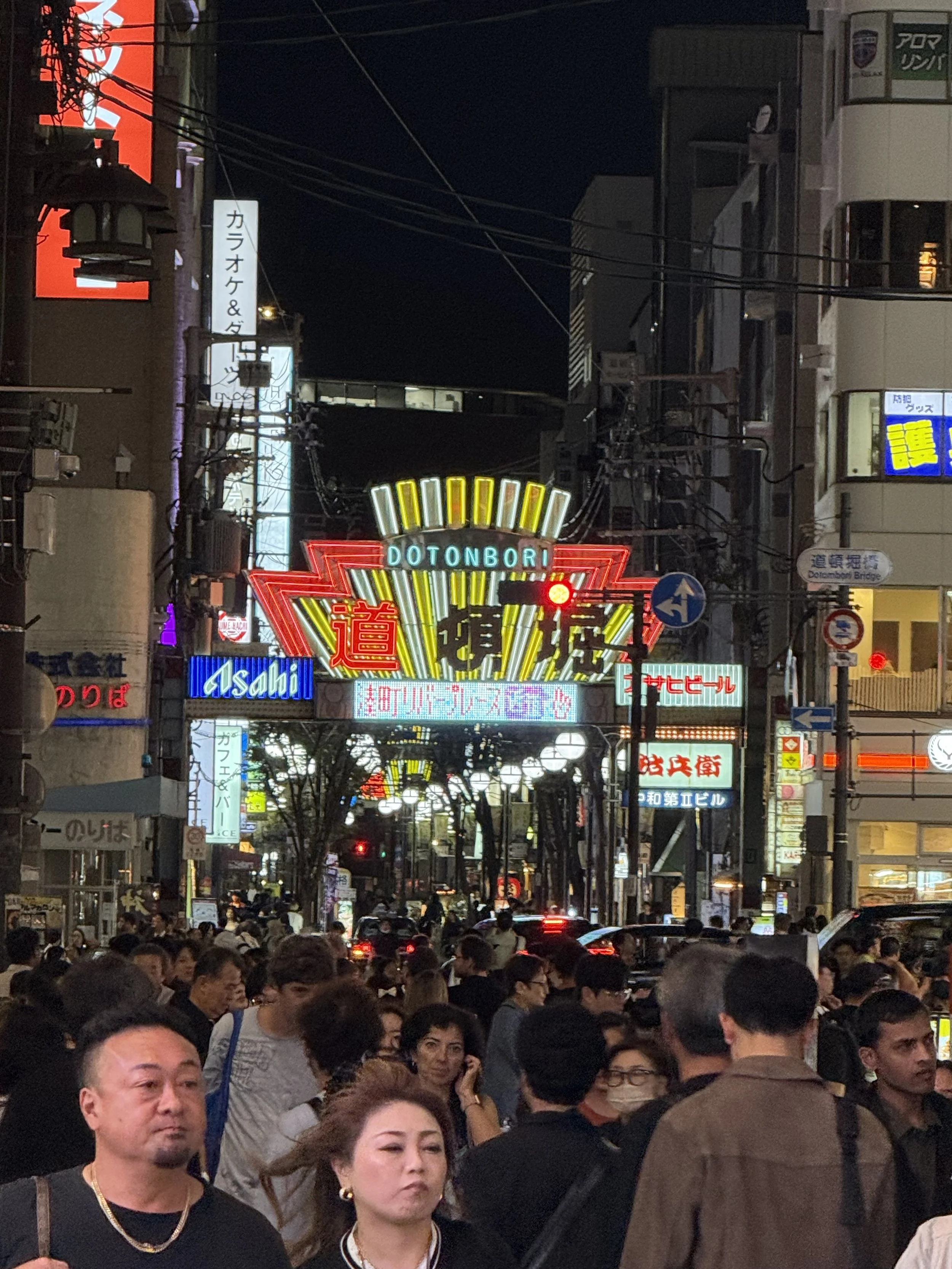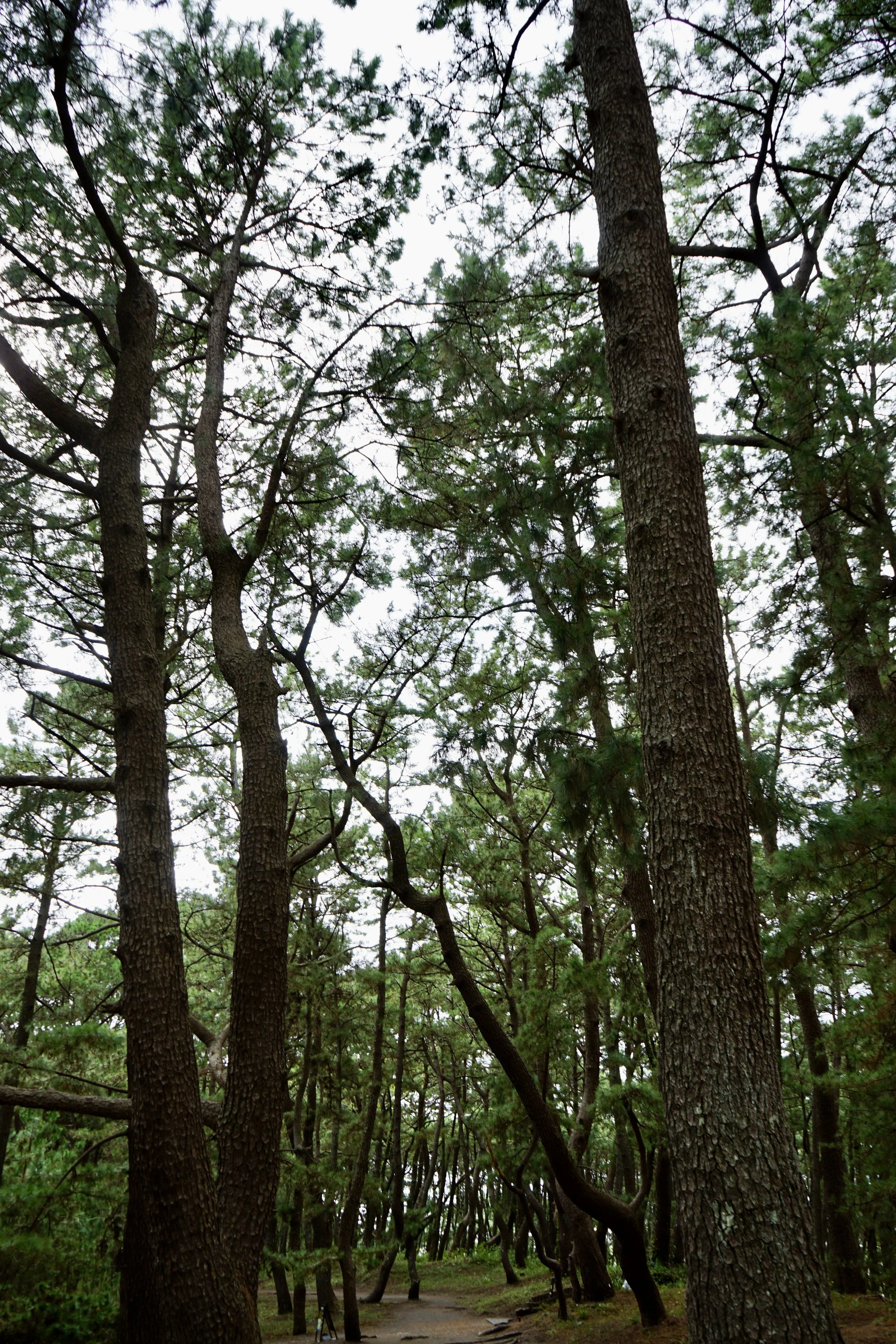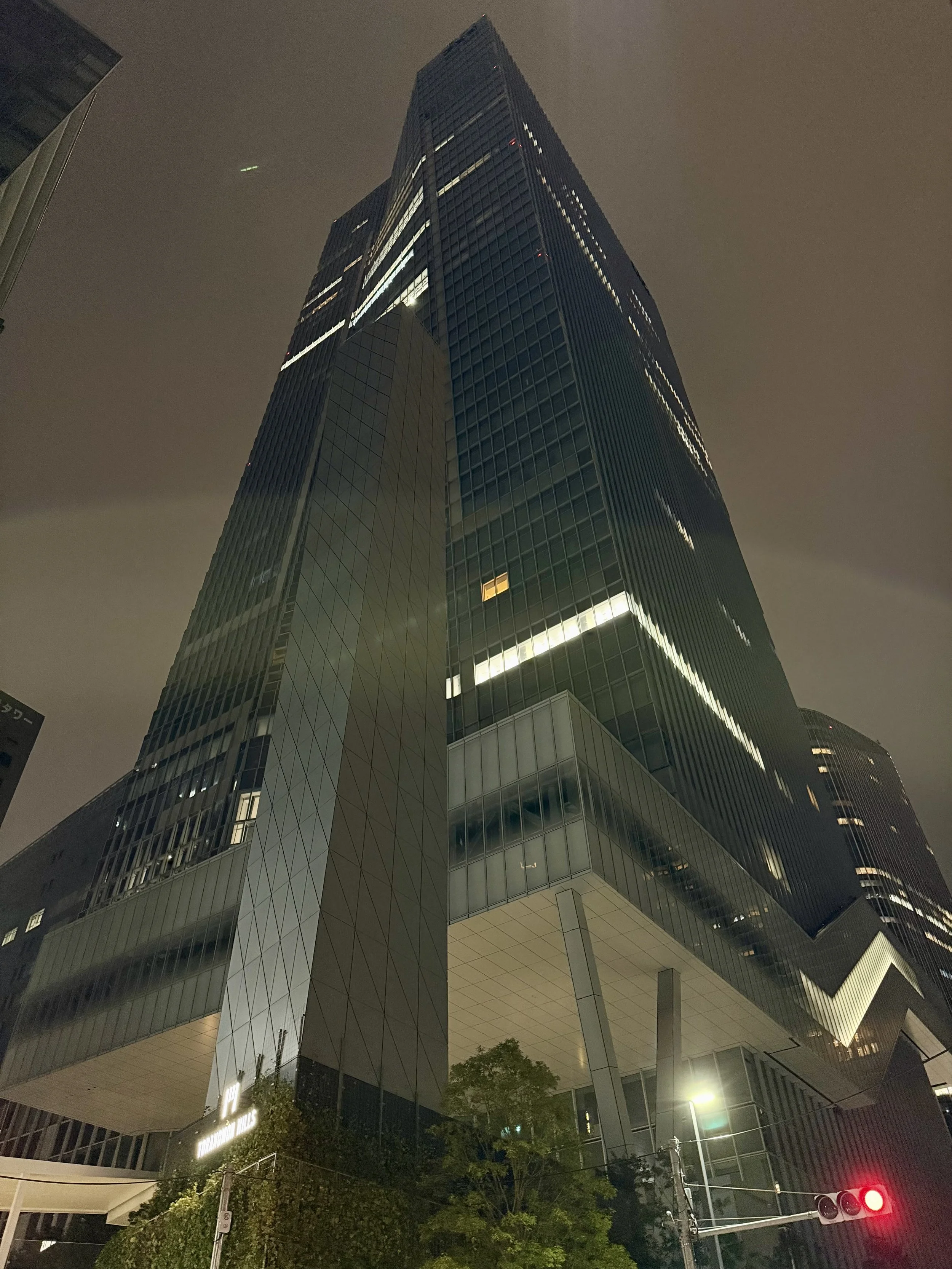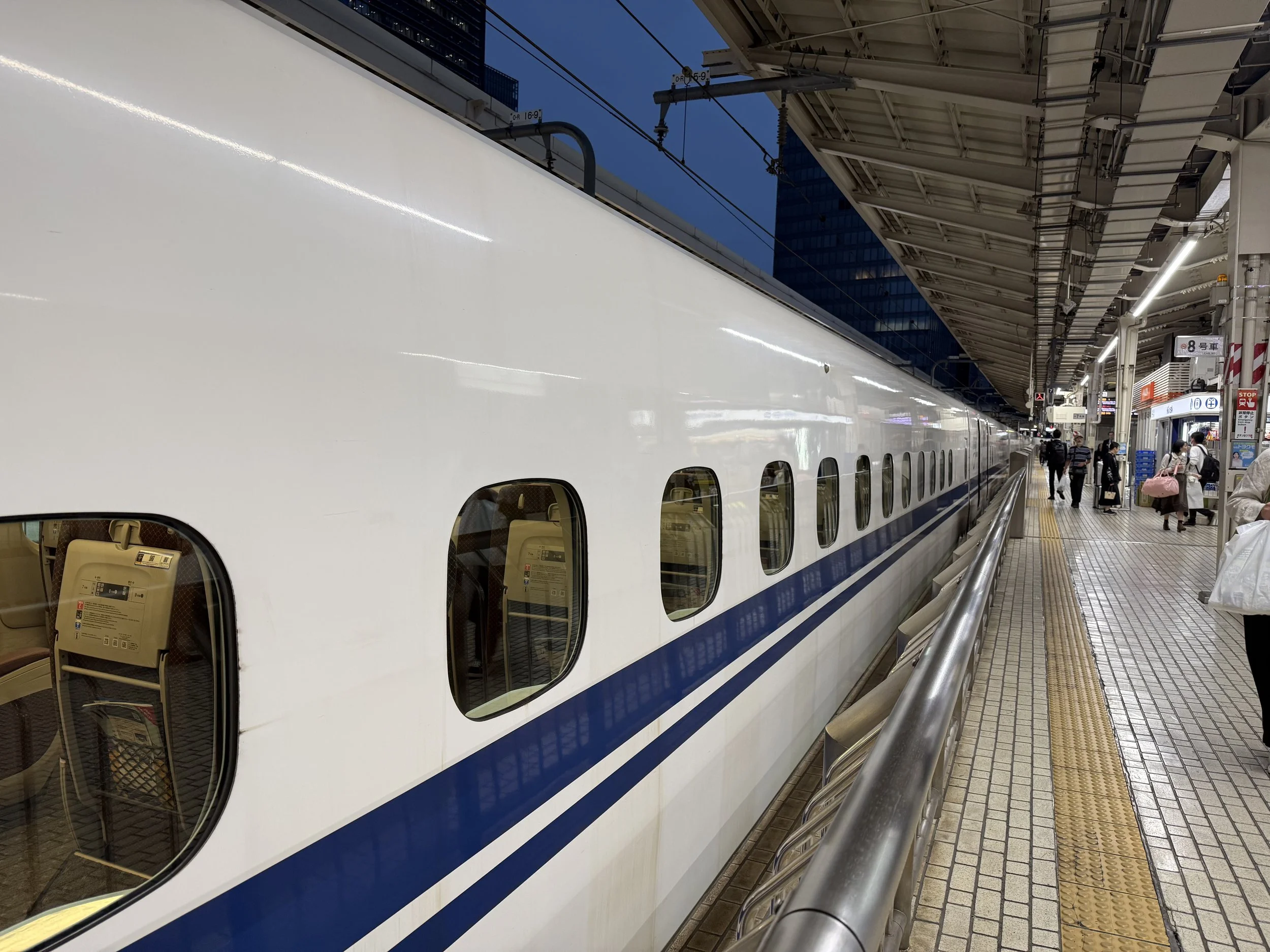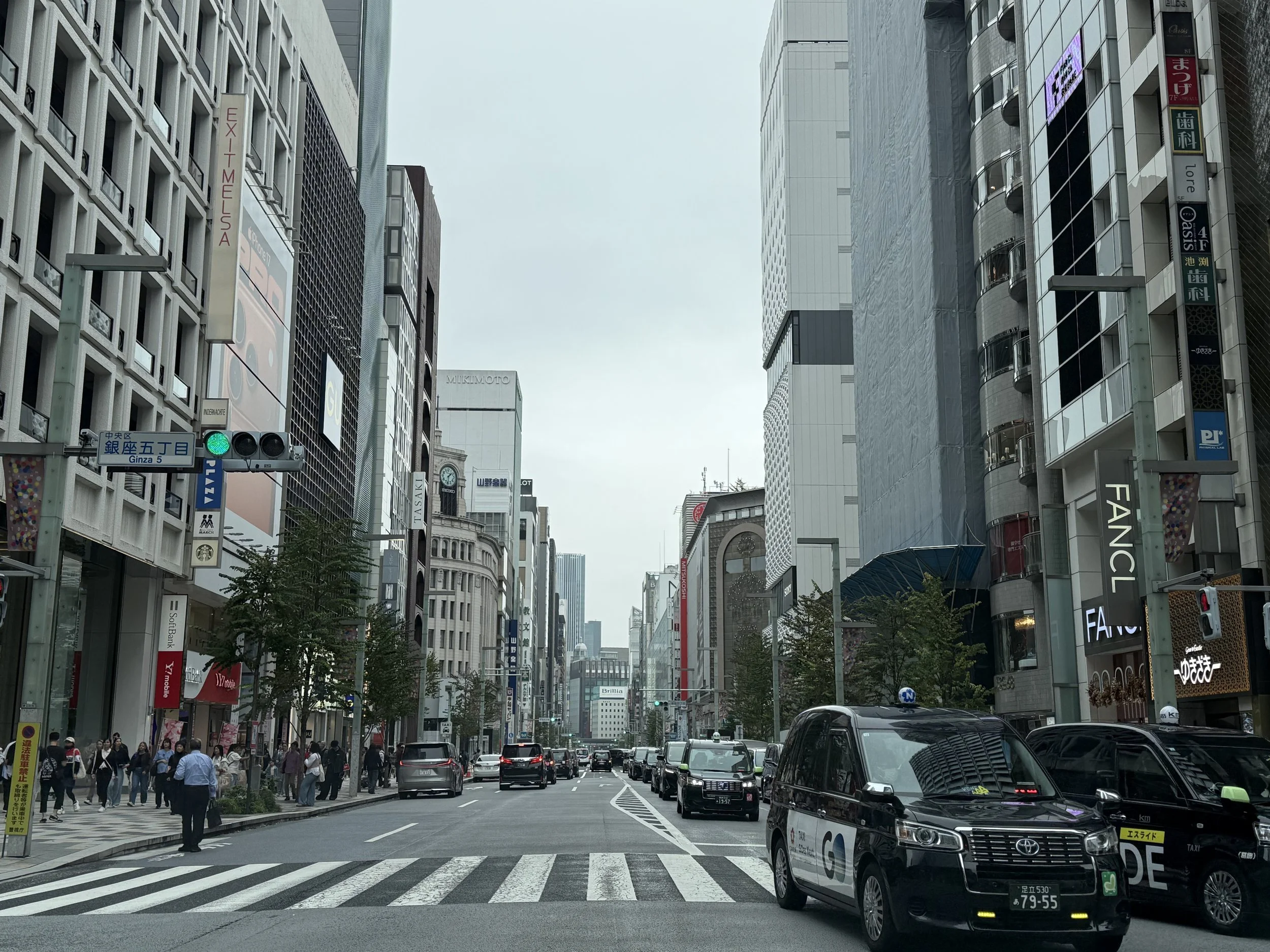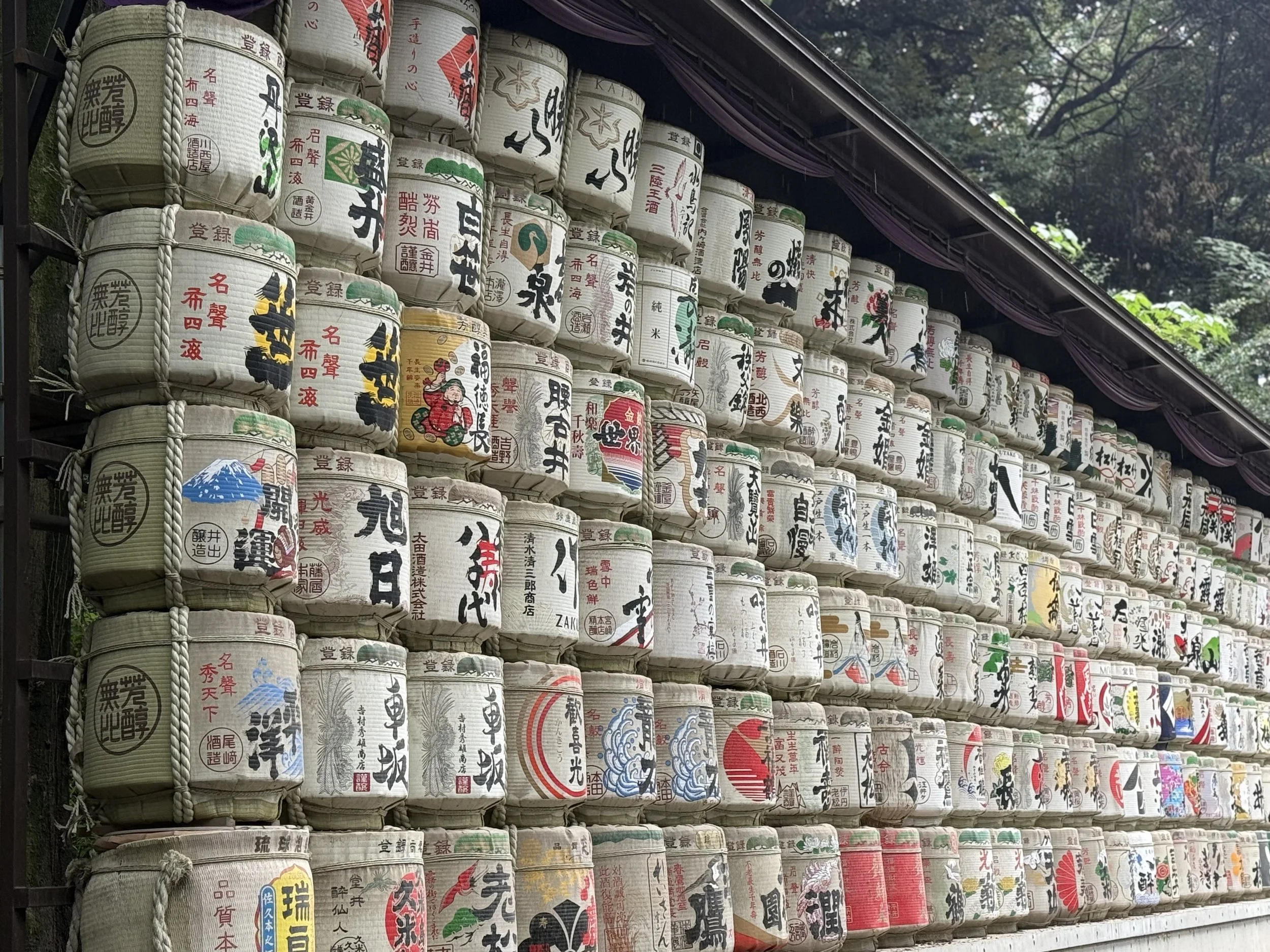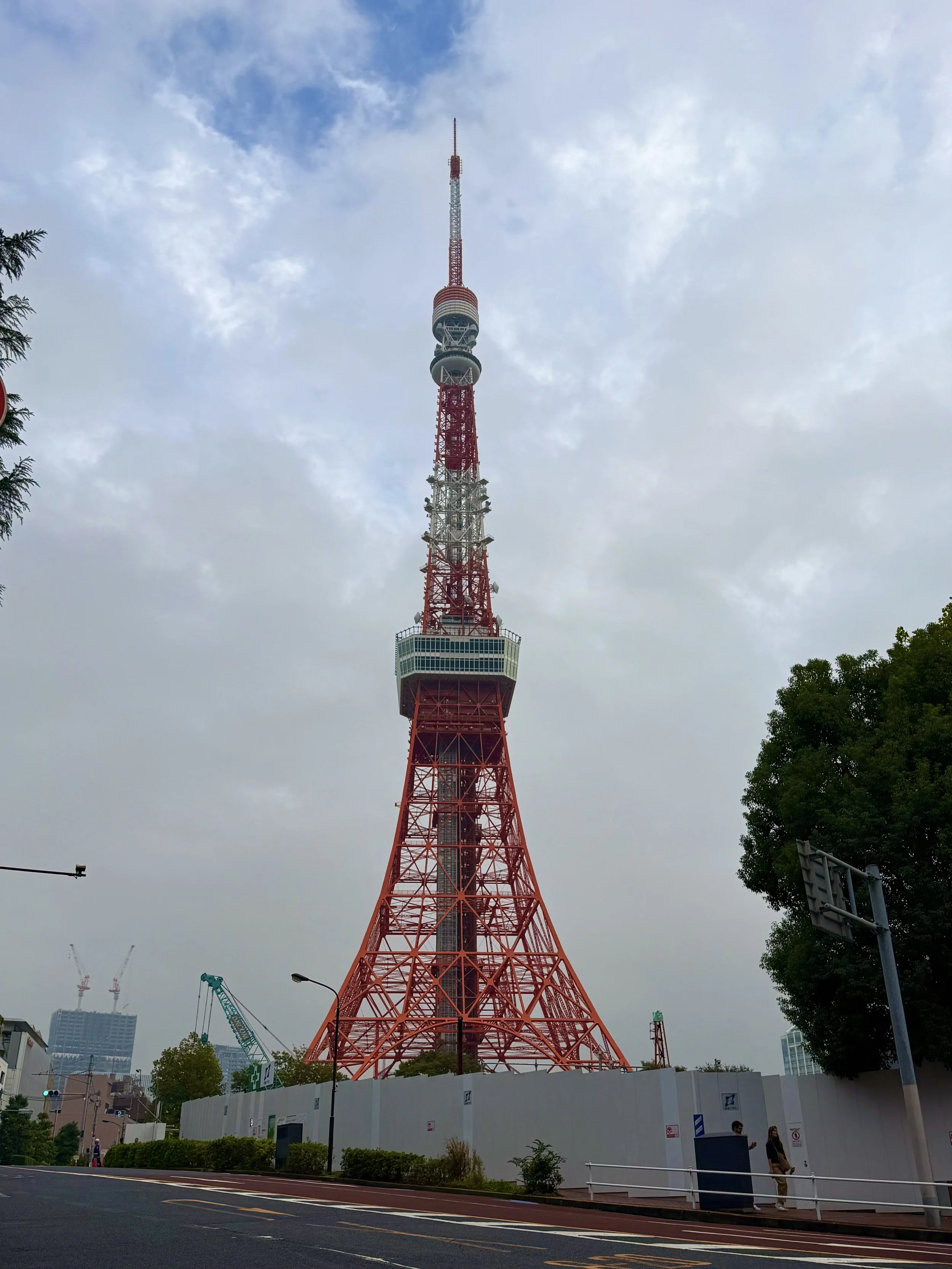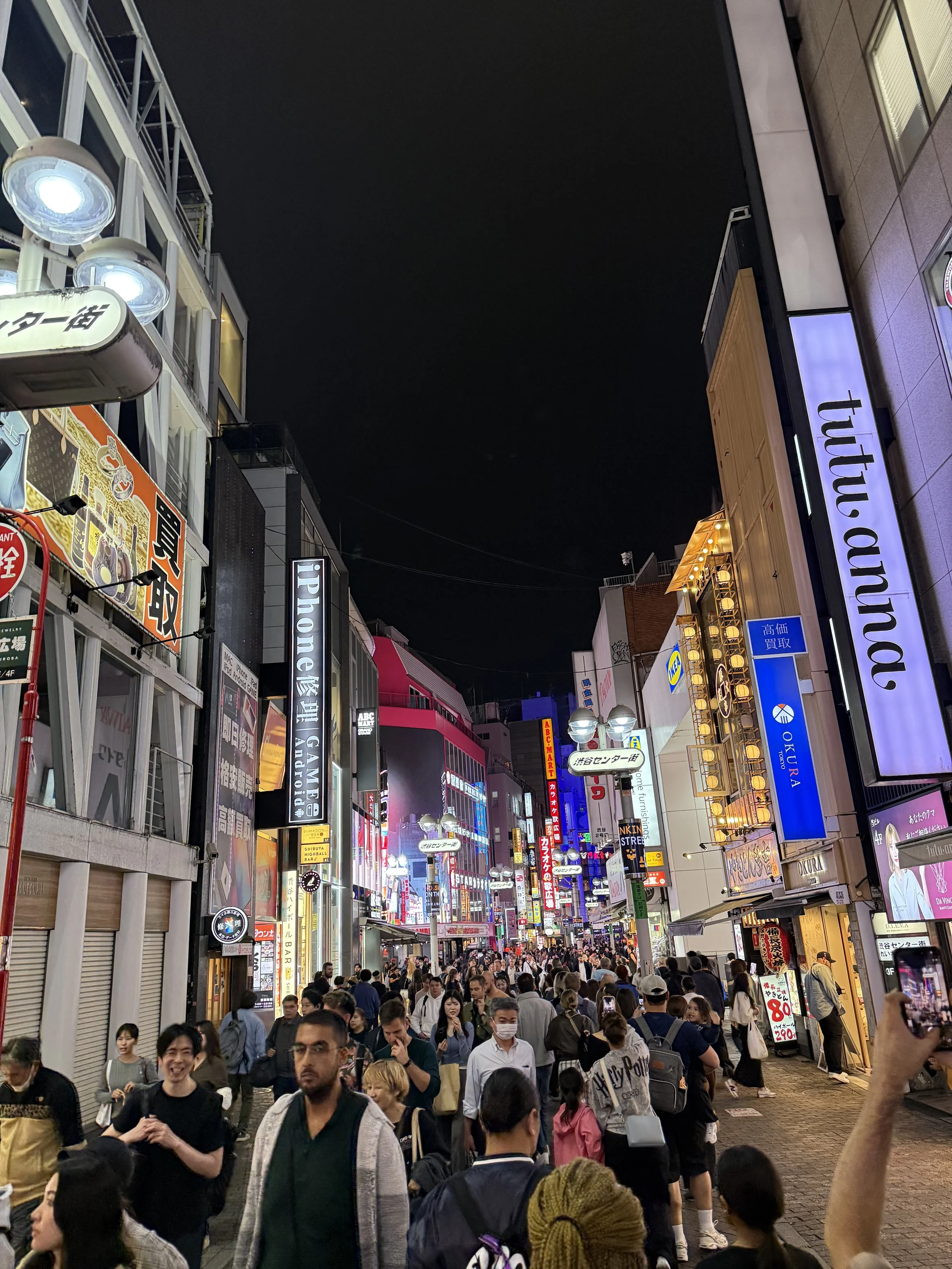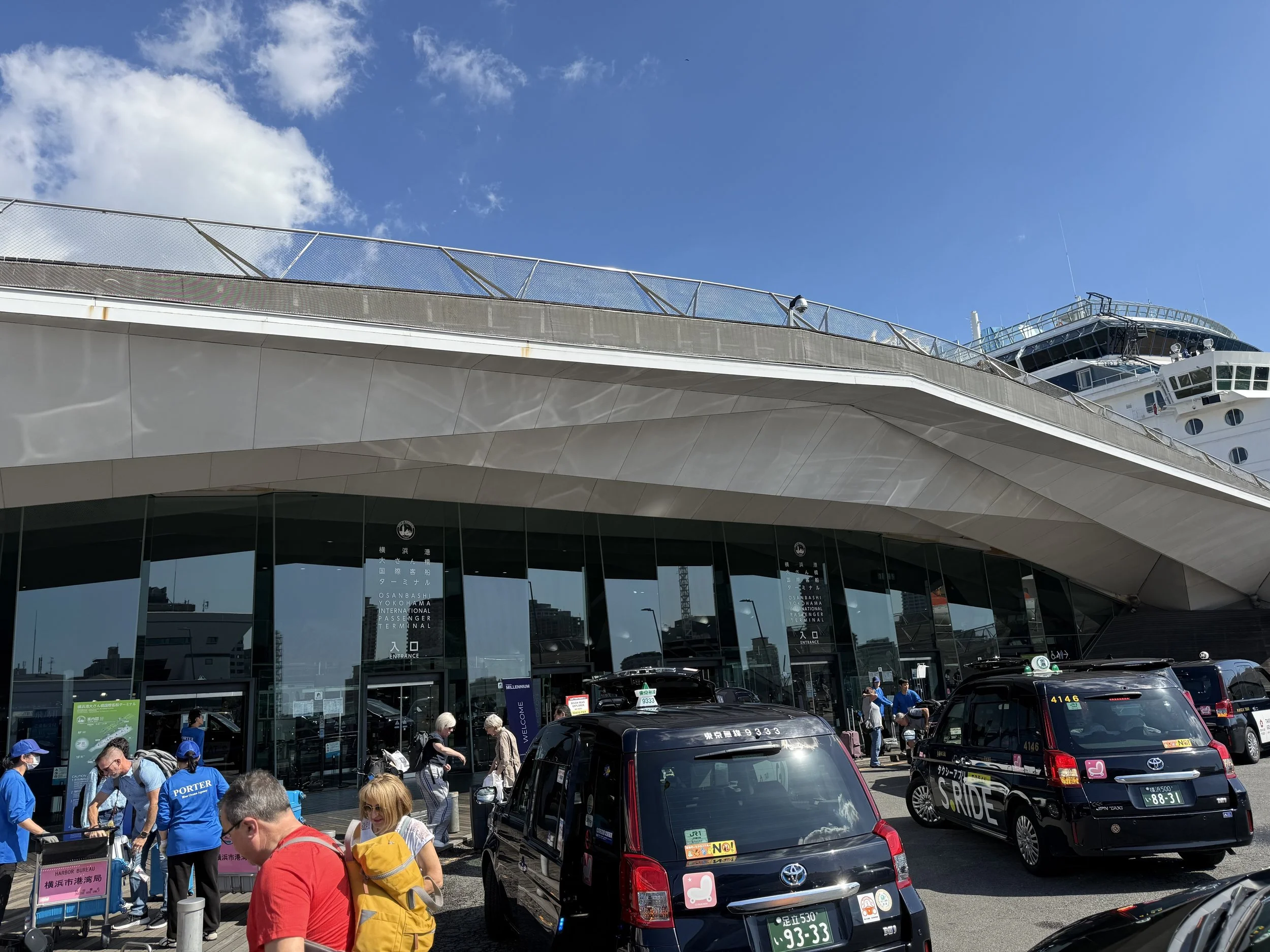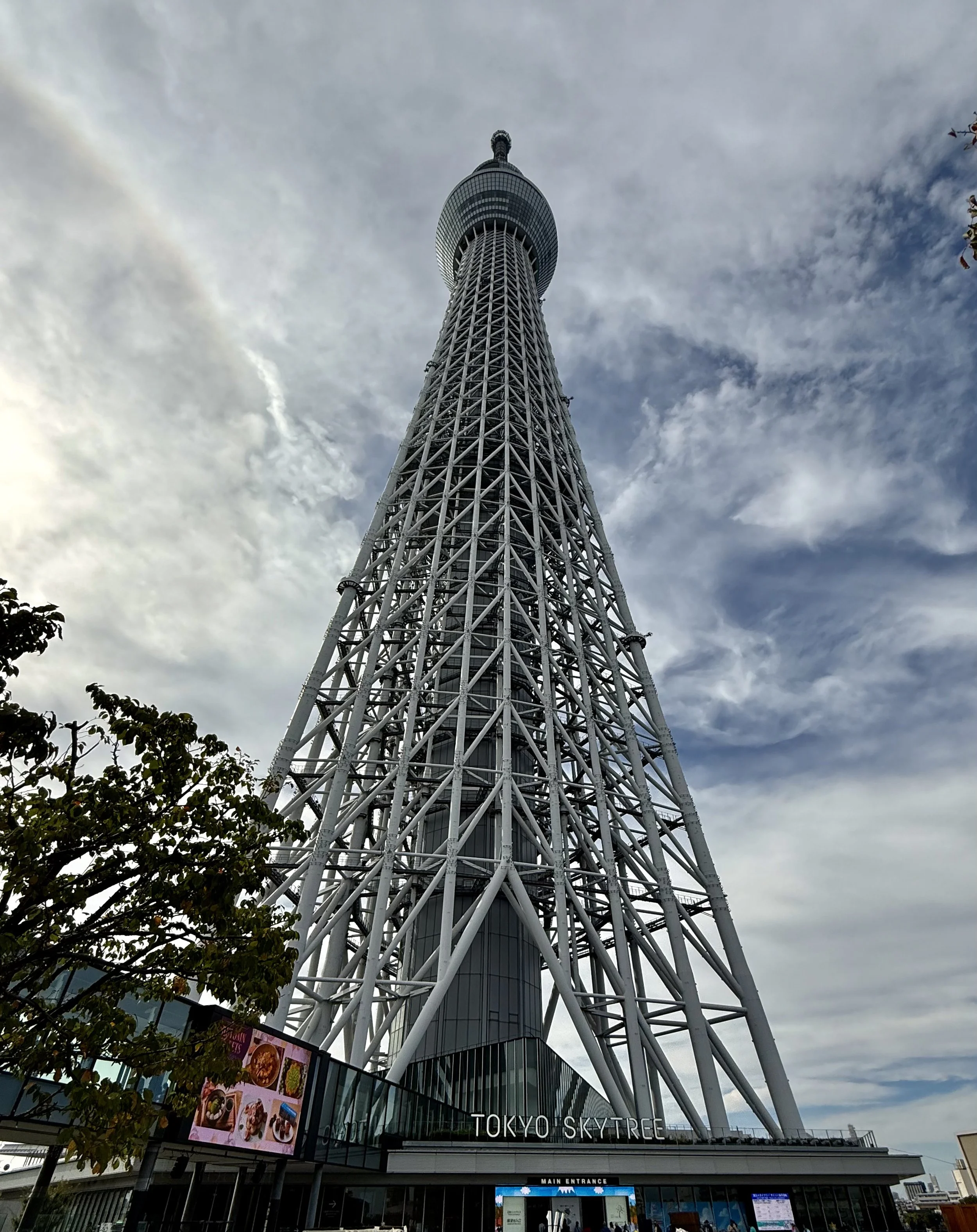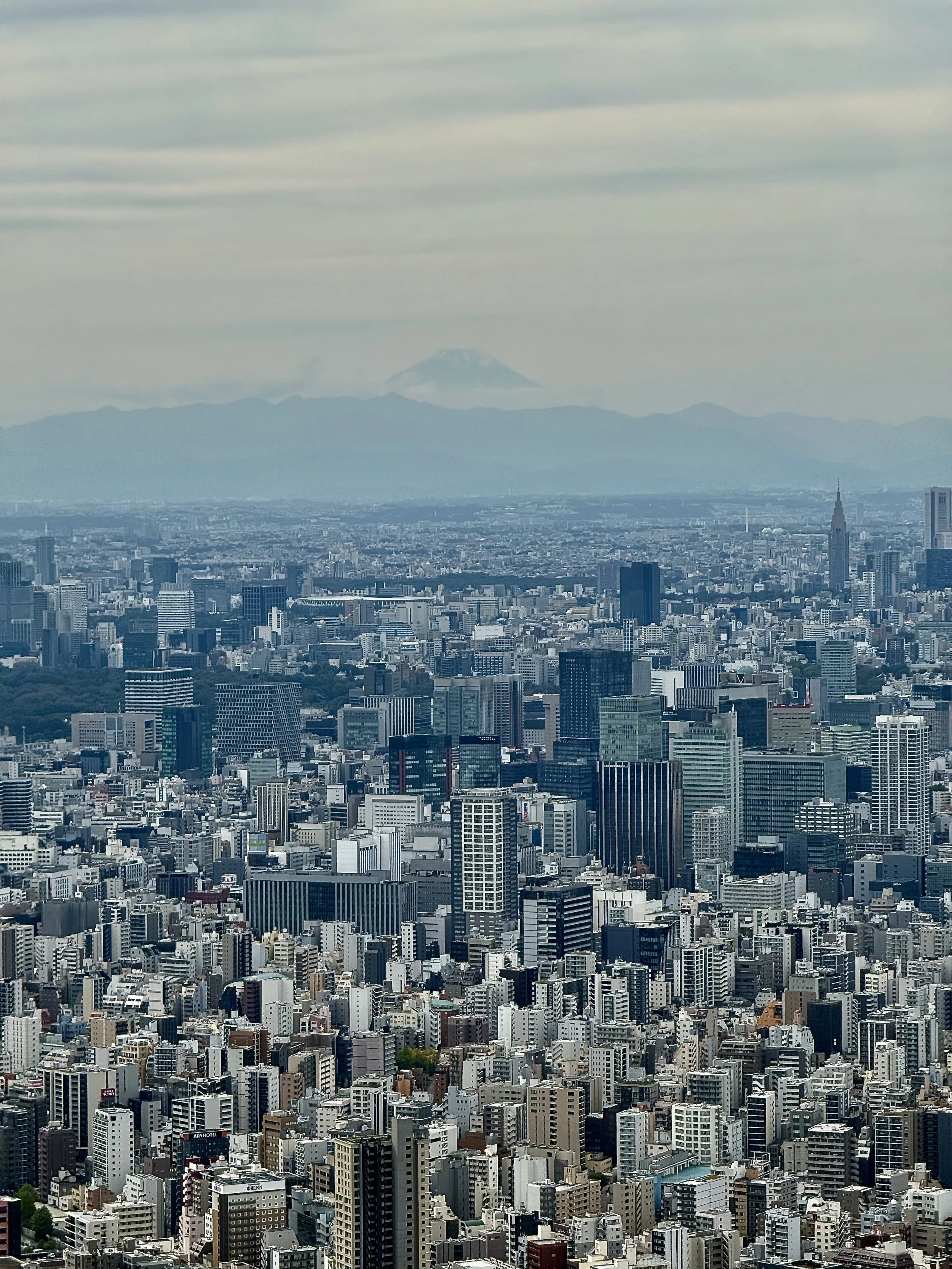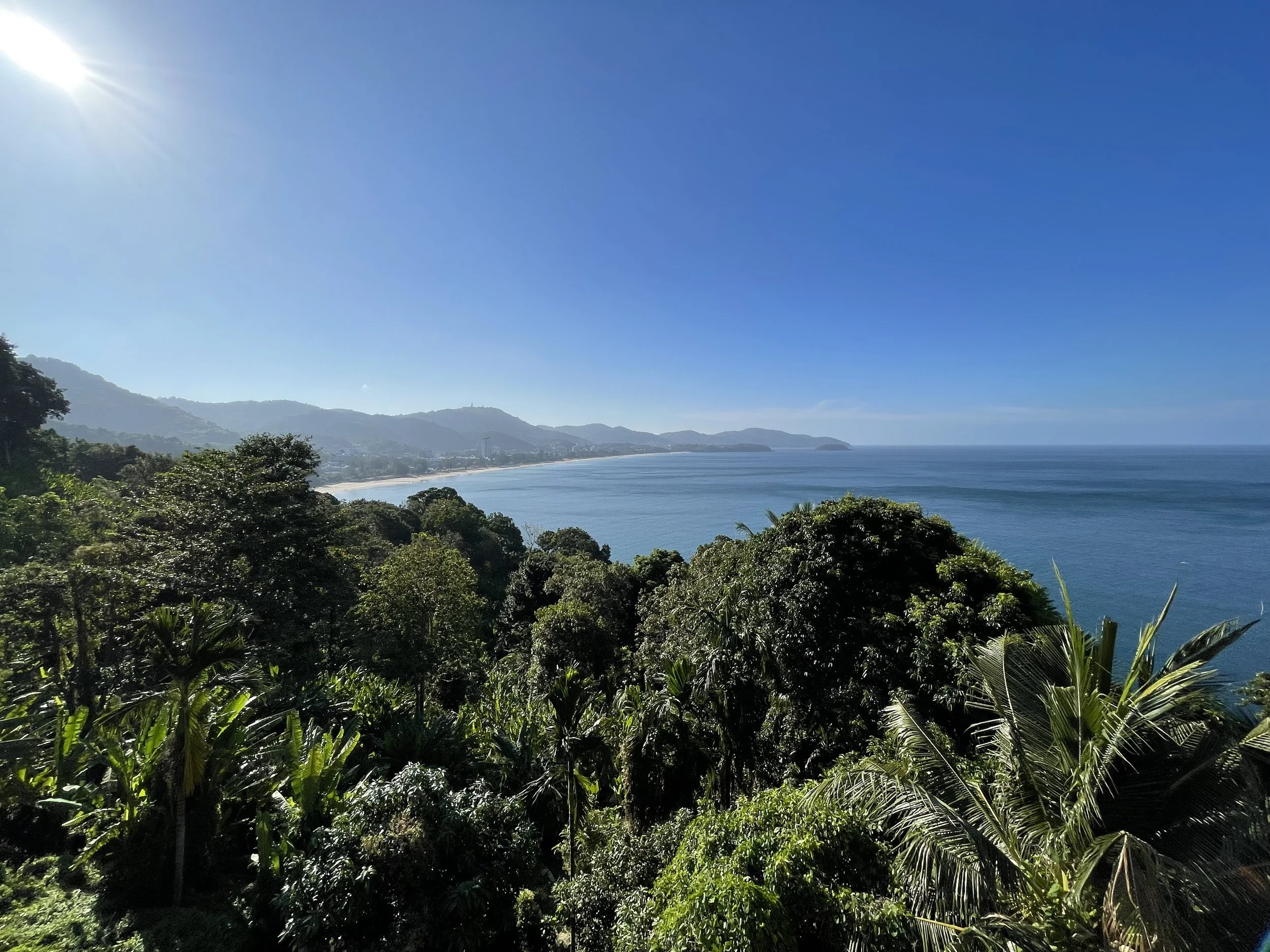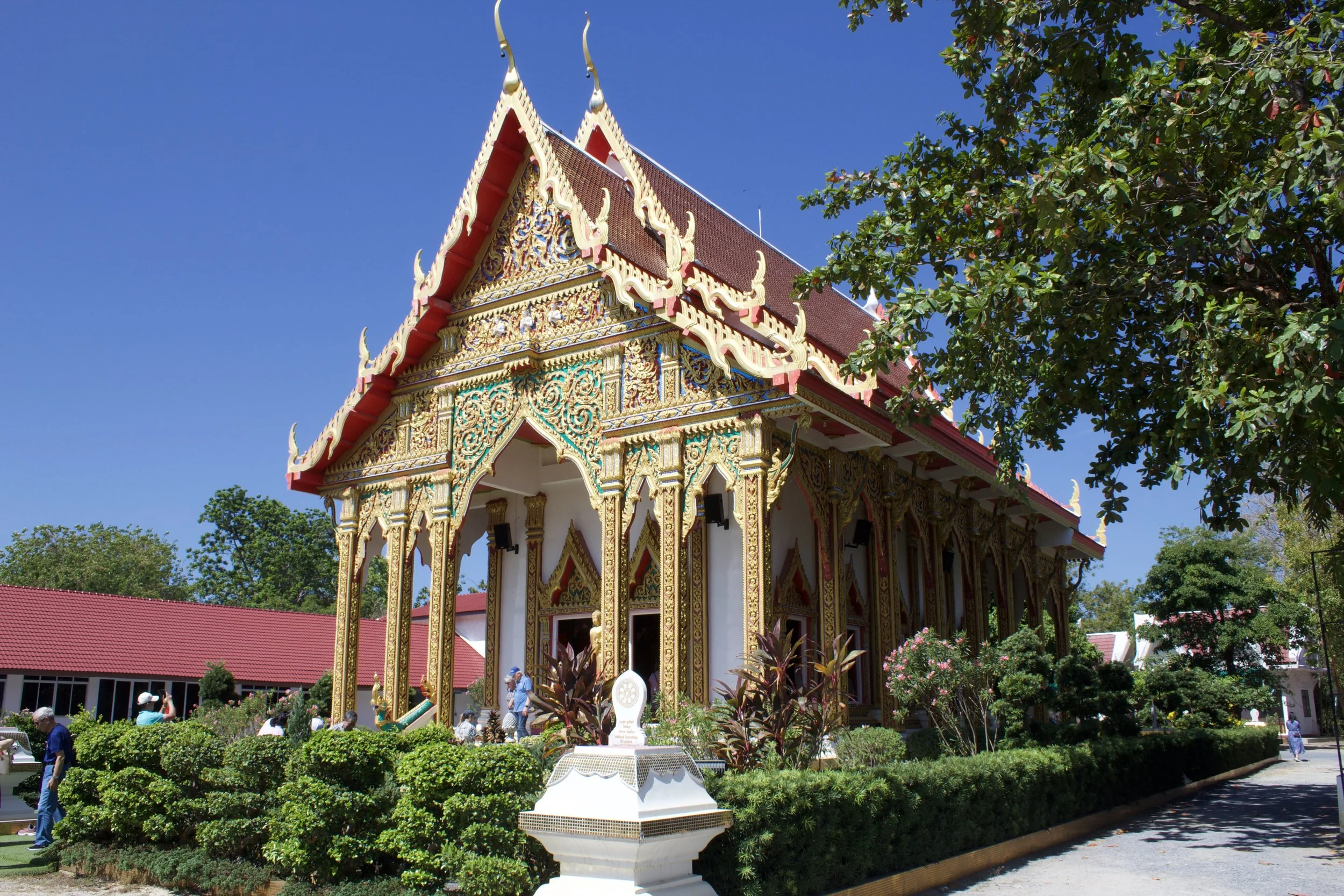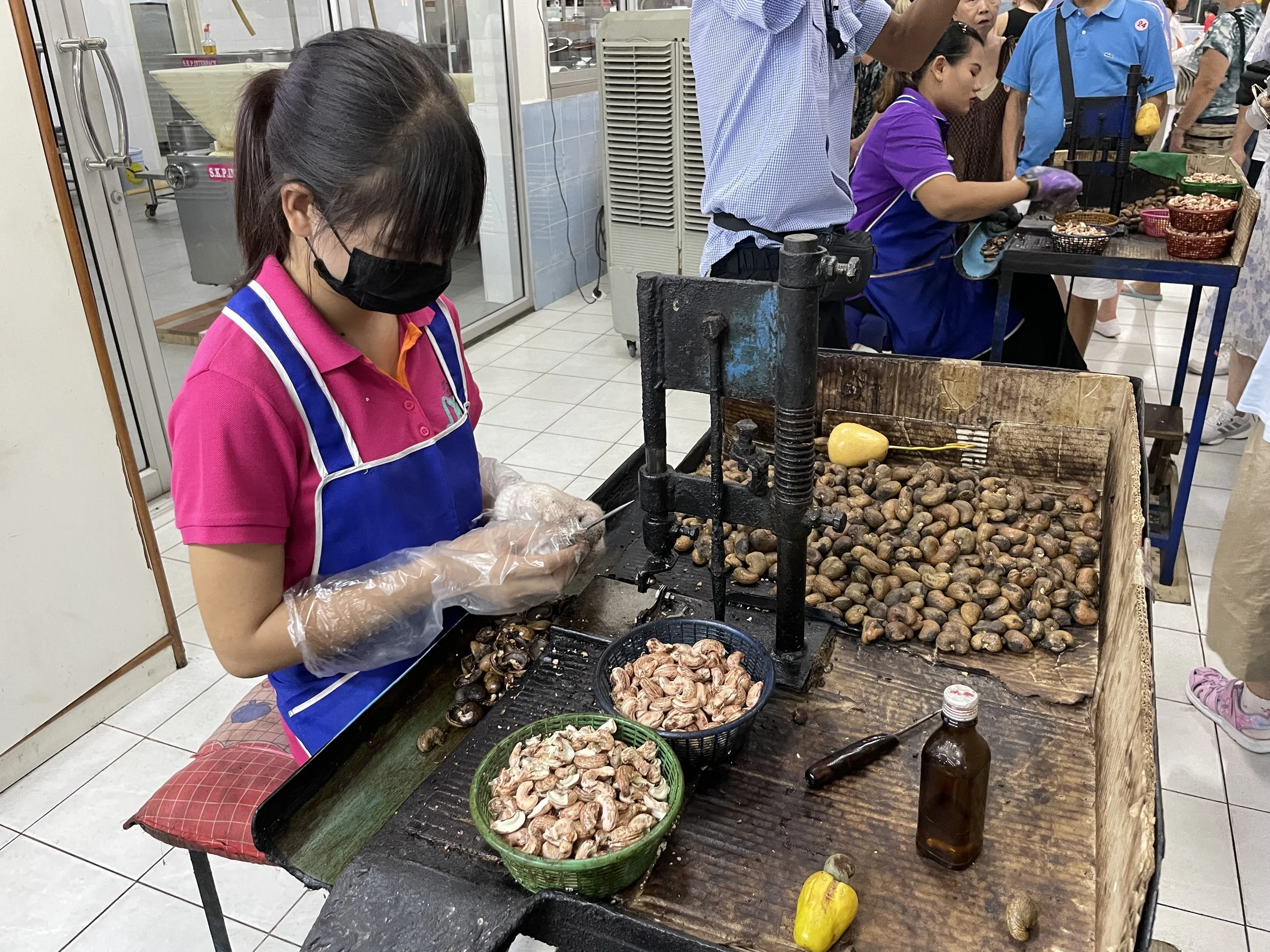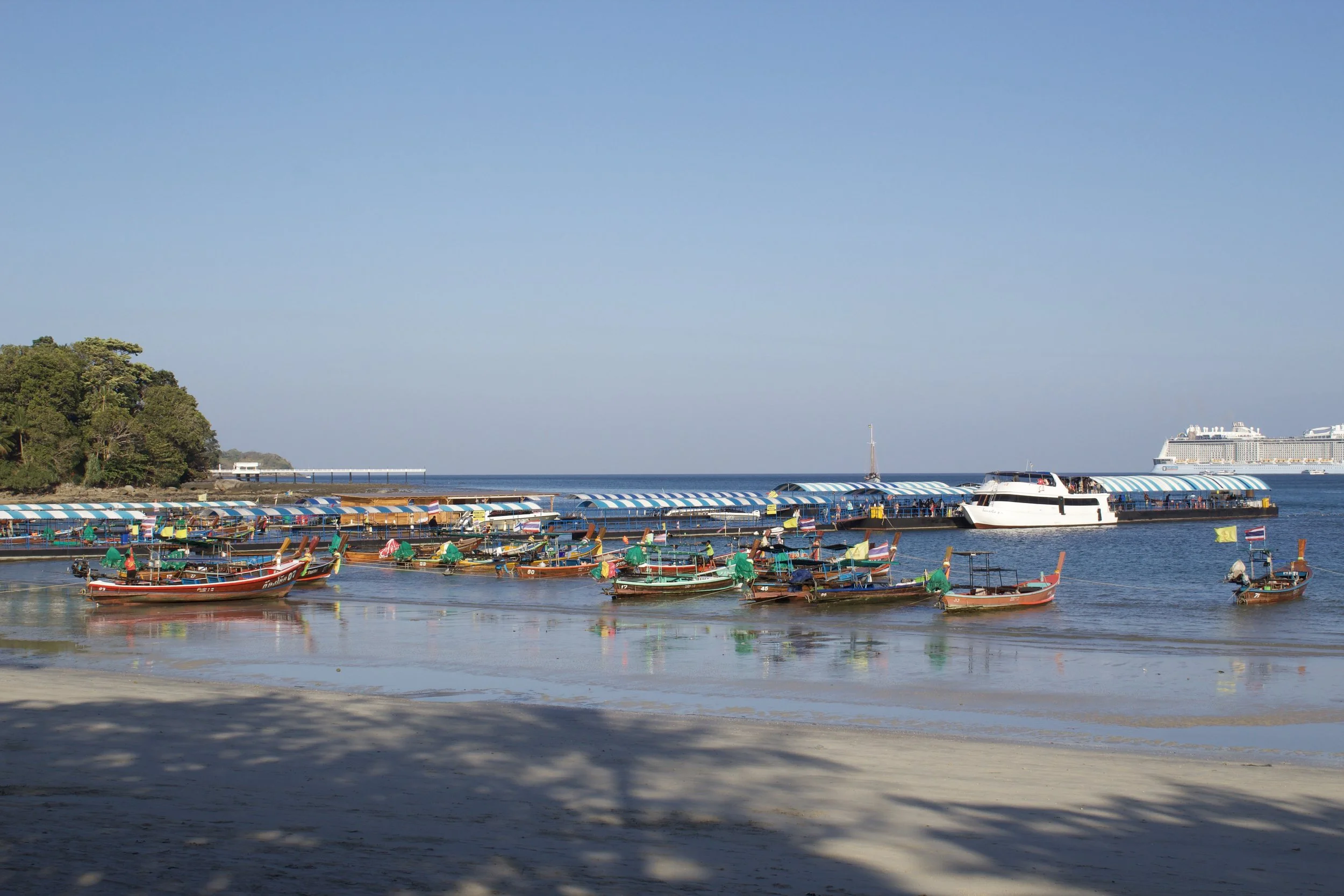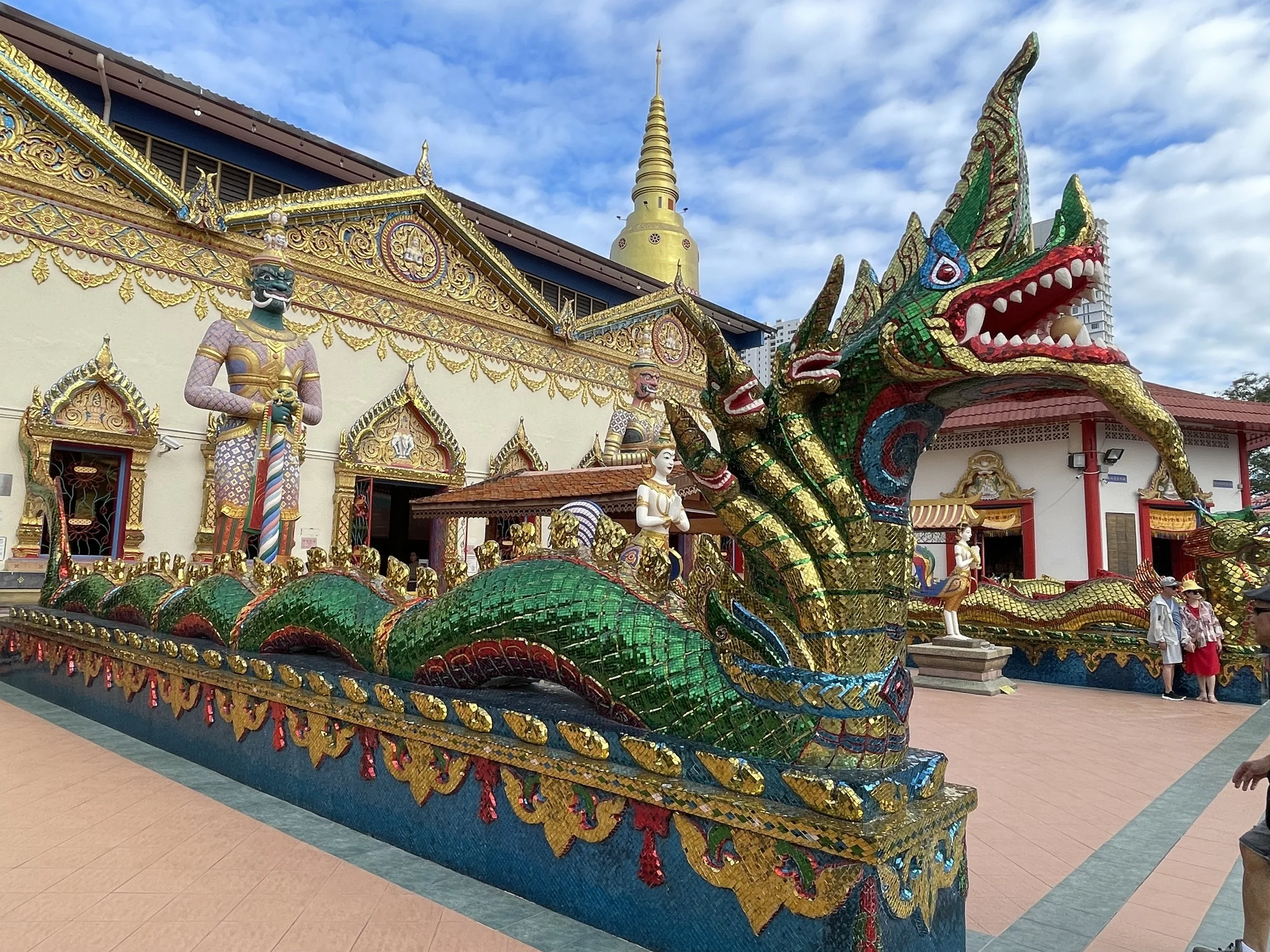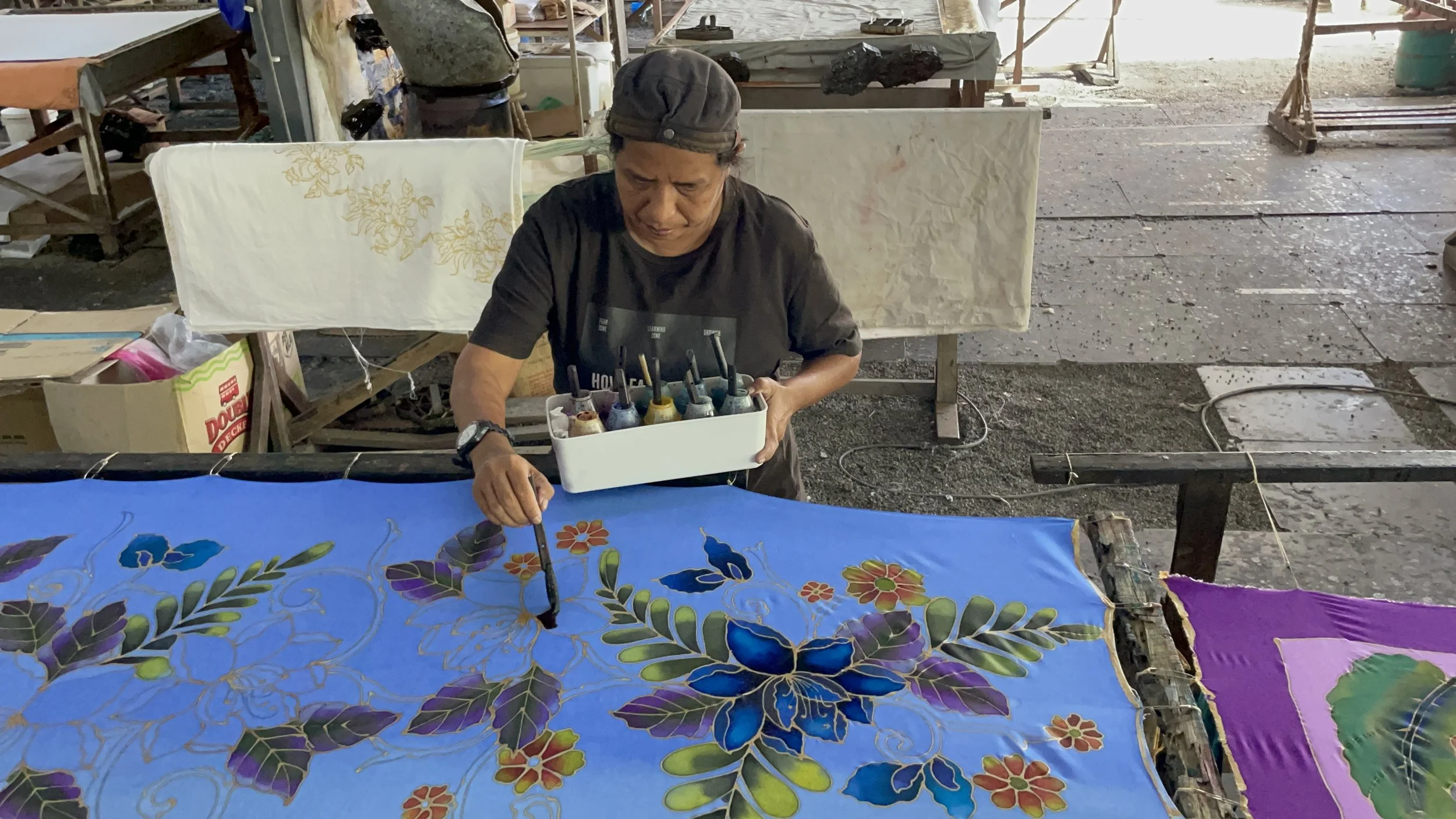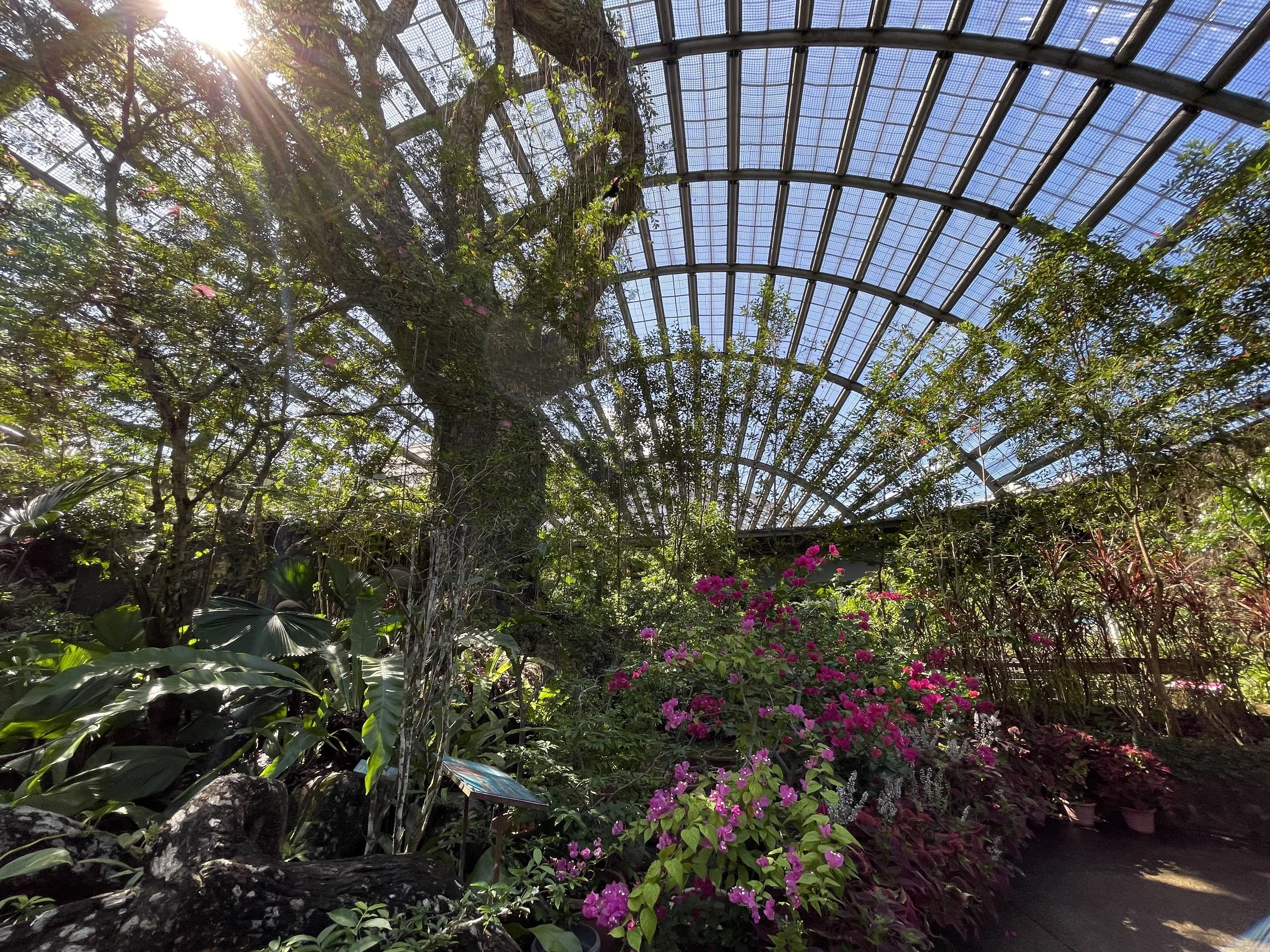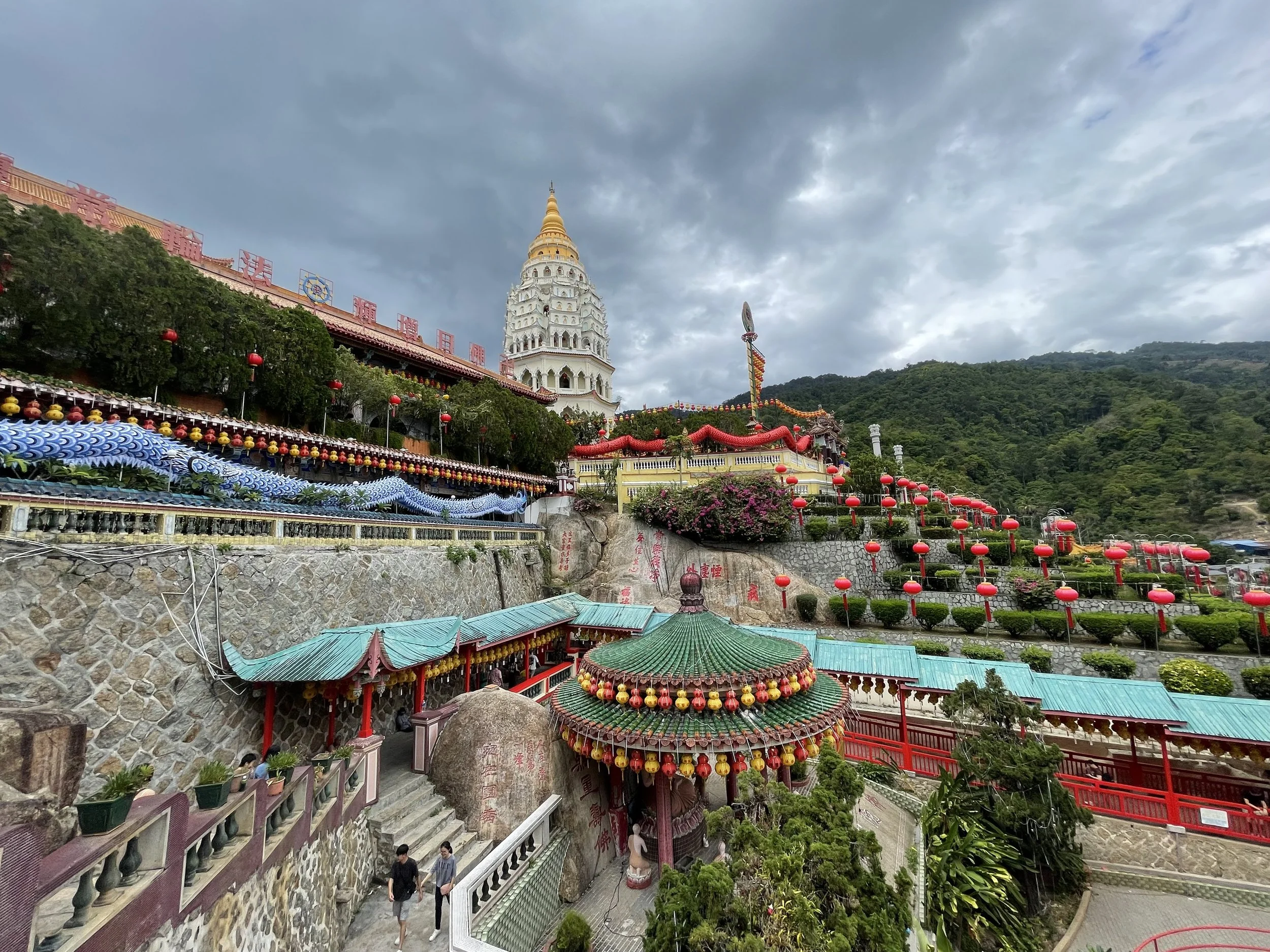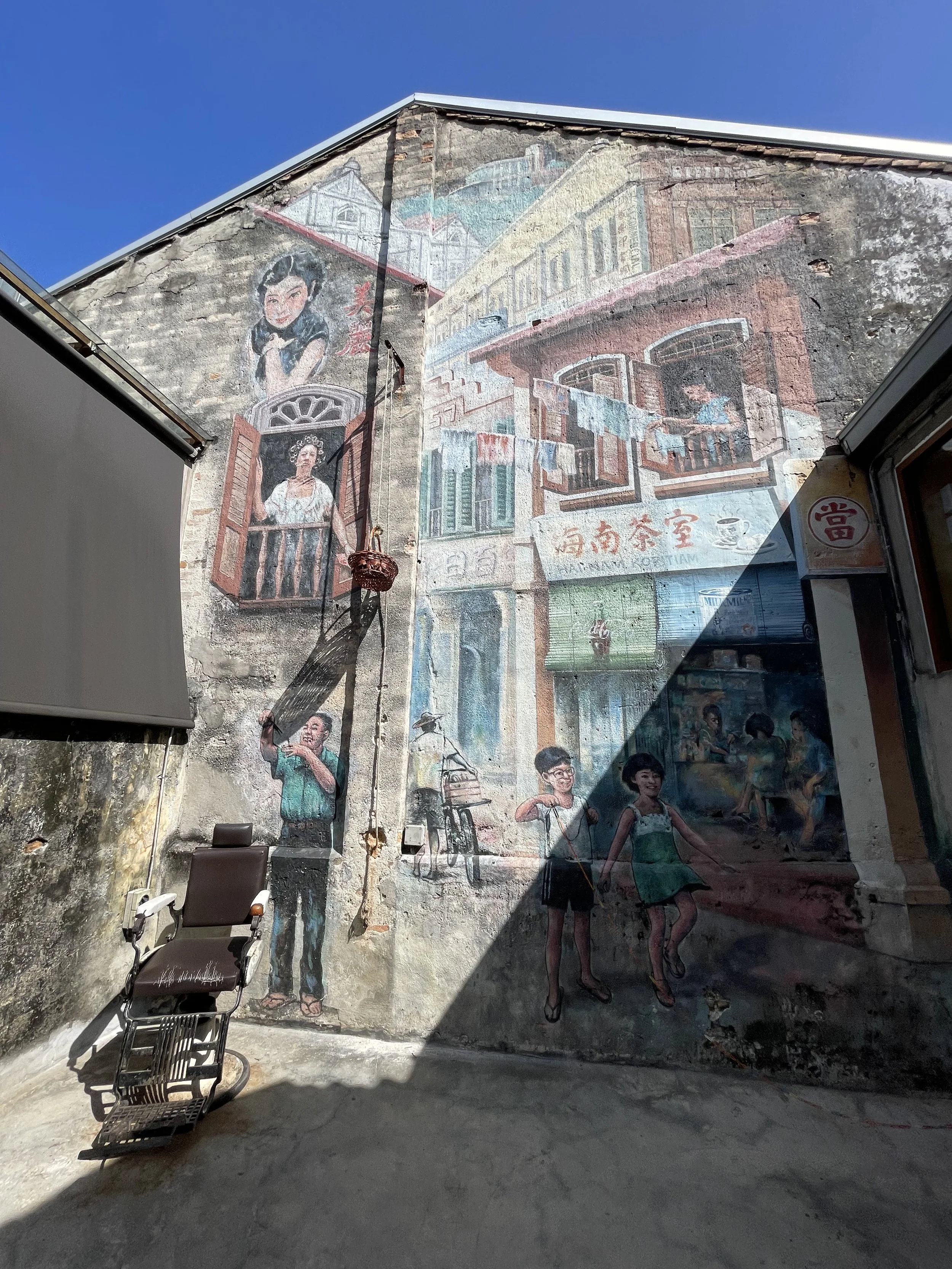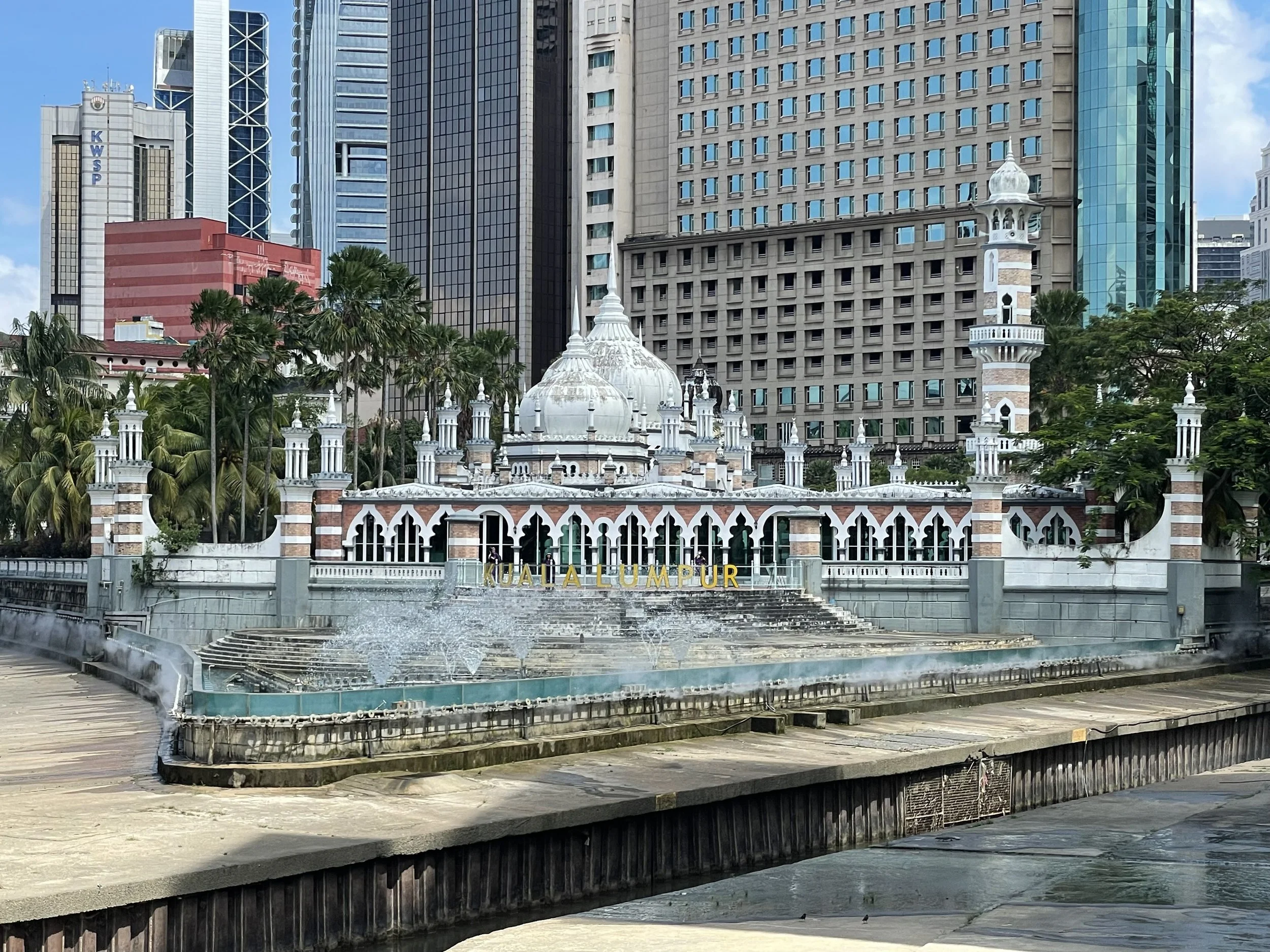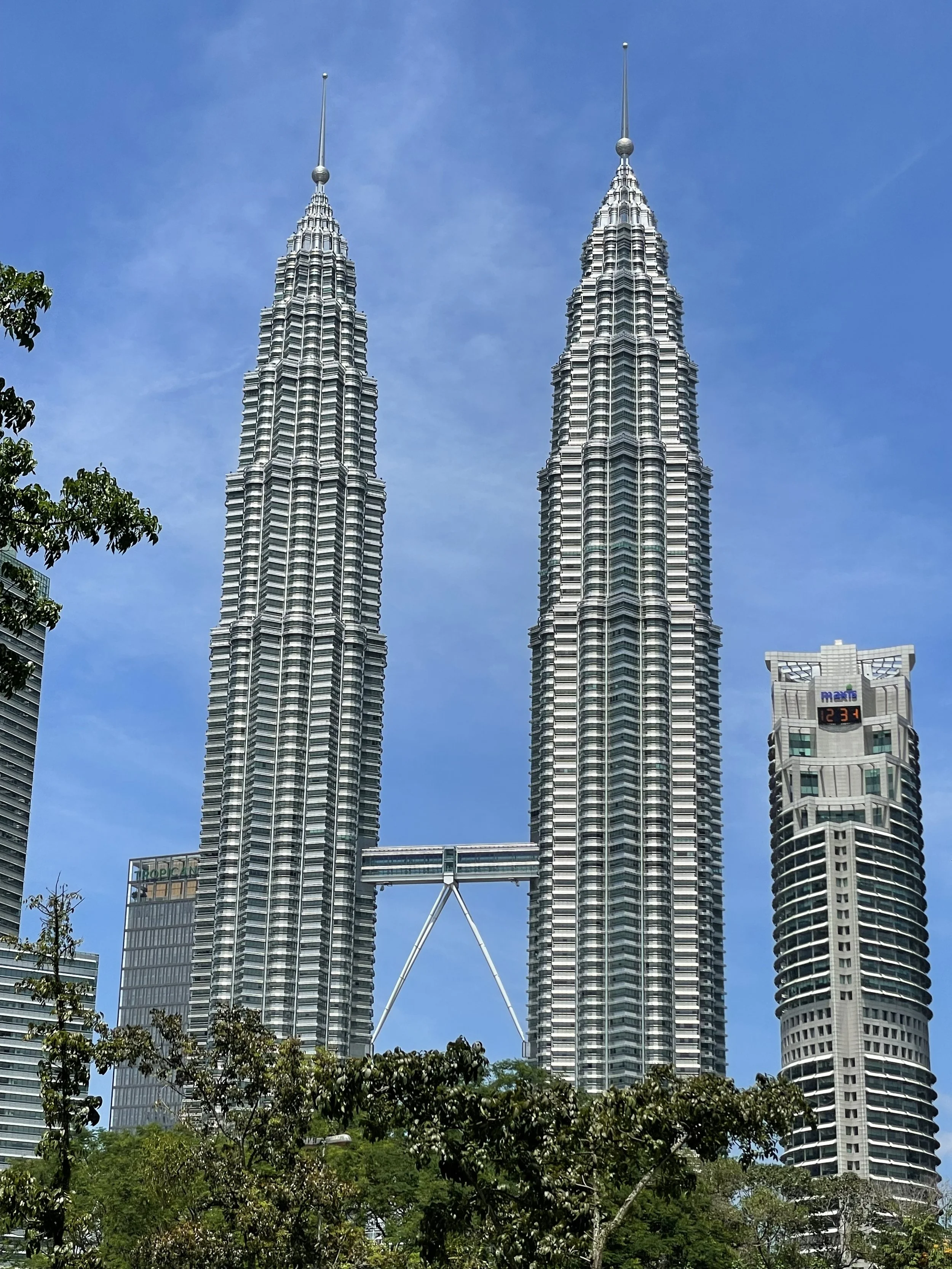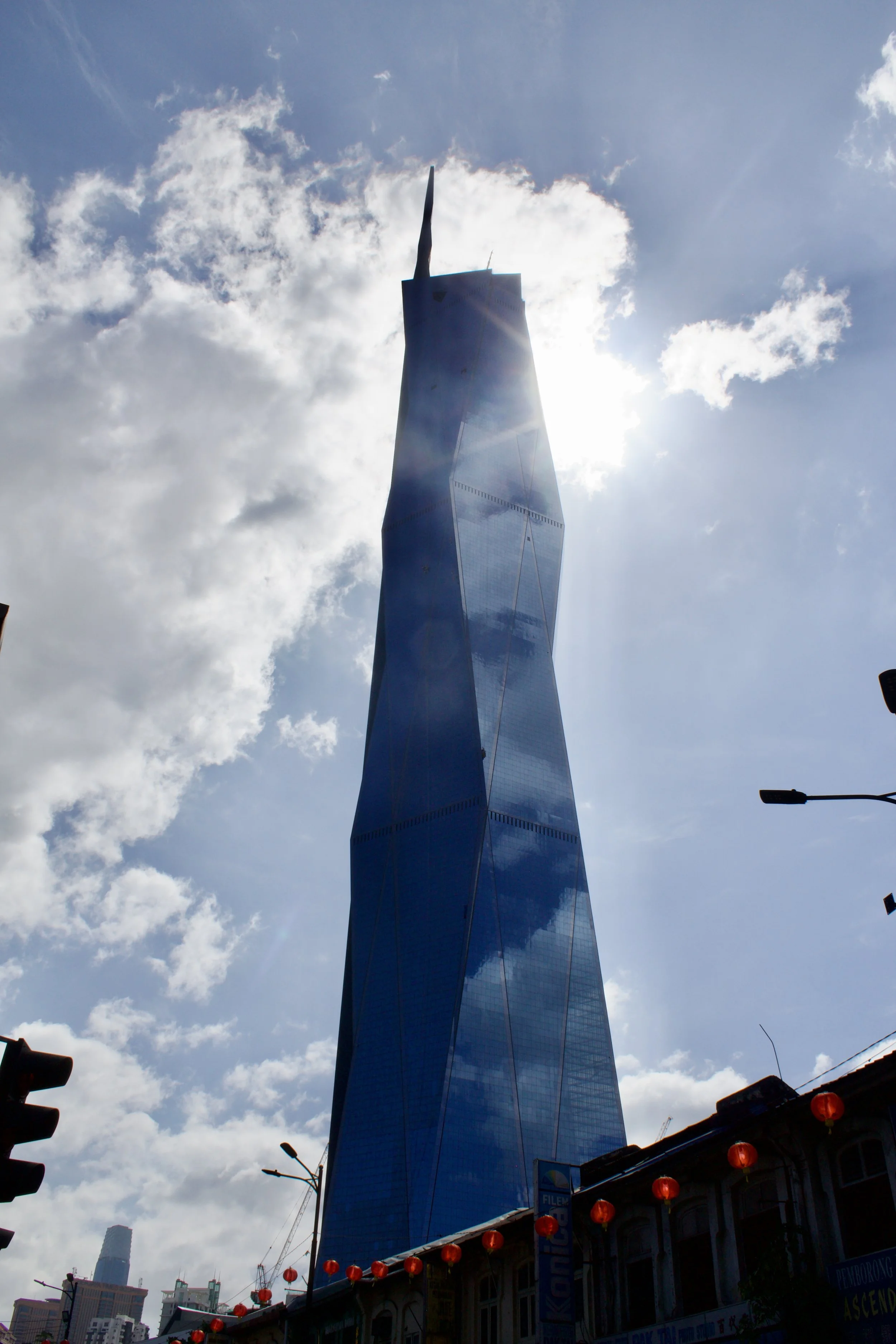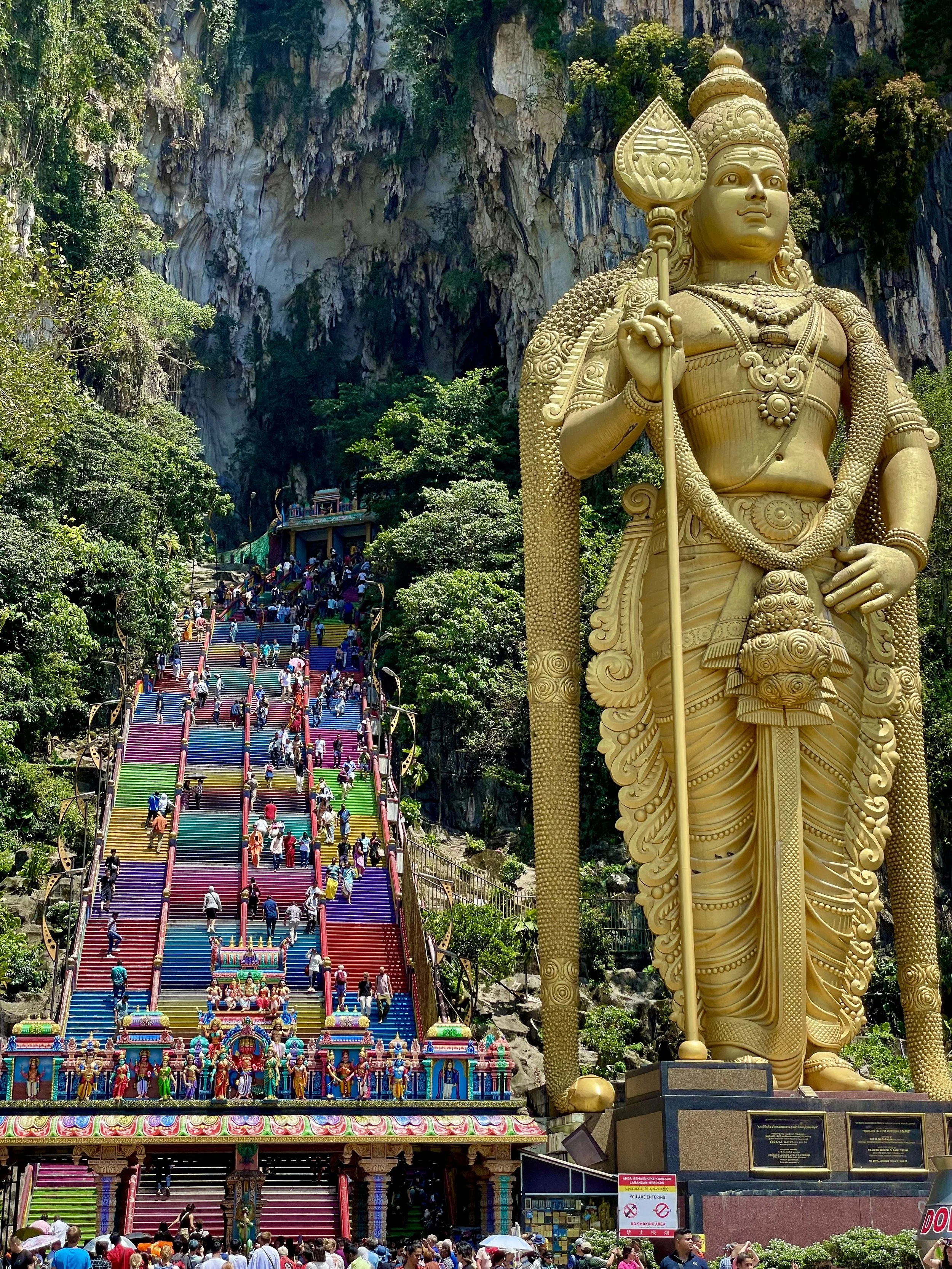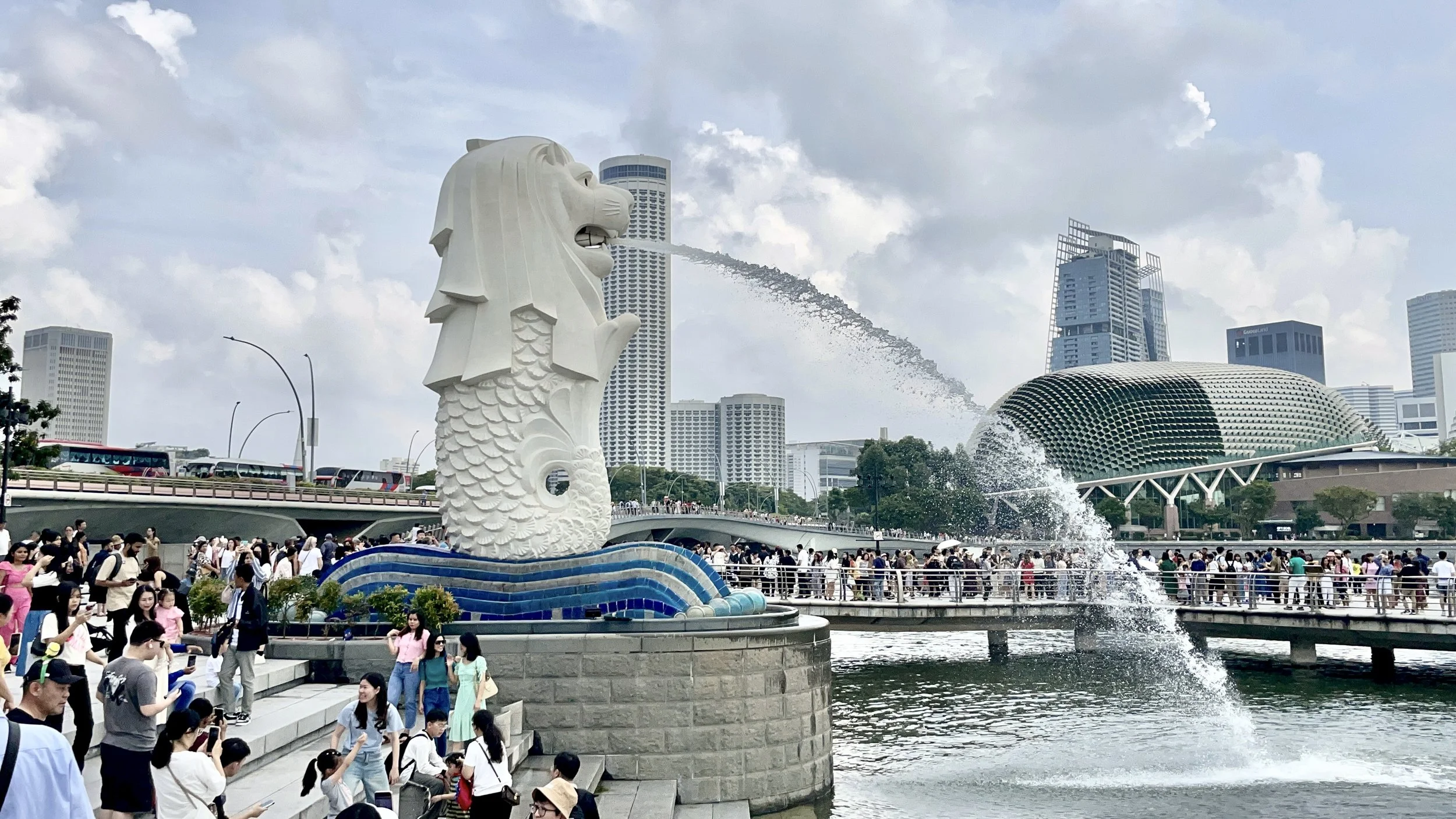Aomori, Japan
We arrived at the Port of Aomori early in the morning. The air was cool and misty, and a faint rainbow stretched across the bridge as we docked. It looked like a promising start to the day.
I joined a tour bound for Hirosaki, about an hour inland from the port. The drive passed through quiet farmland and low mountain scenery, with apple orchards visible along the road. The guide explained that Aomori is Japan’s main apple-growing region, producing more than half of the country’s total crop. The bright red Sun Fuji is the most famous variety, and farmers protect the fruit by wrapping each apple in paper to keep the skin unblemished. Juice and cider are sold almost everywhere, and many bakeries specialize in fresh apple pies.
Seafood is also central to the area’s identity. Scallops from Mutsu Bay are known for their sweetness, and tuna caught off the port of Ōma often sells for record prices at Tokyo’s fish markets. In 2019, a single bluefin tuna from Ōma sold for more than ¥330 million yen (over three million U.S. dollars) at auction, and in 2020 another sold for nearly ¥200 million yen. These headline-grabbing sales highlight just how prized Aomori’s tuna is across Japan. The local economy still depends heavily on these two products — apples from the orchards and fish from the sea.
Hirosaki Nebuta Museum
Our first stop in Hirosaki was a small museum near Hirosaki Castle that focuses on the city’s version of the Nebuta Festival. It is much smaller than the main museum in Aomori City but offers a more personal look at the local traditions that shape the event. Admission costs ¥600 for adults and ¥300 for children, and the museum is open daily from 9:00 a.m. to 5:00 p.m.
Inside, large paper floats glowed in a dimly lit hall. Each figure was built over a wire frame, covered with paper, and painted by hand. The displays change throughout the year to highlight different designs and techniques. The staff gave a short demonstration of the festival music and explained how the drums, flutes, and dancers work together during the celebration. Visitors were invited to take turns striking the taiko drum, and a musician performed on the shamisen, a three-stringed instrument that gives the festival its distinctive sound.
In another section of the building, local artisans demonstrated how they make wooden toys and hand-painted ceramics, both of which are sold in small shops around the region. The process was simple but detailed, and visitors could watch as each piece took shape. Small finished items were available for purchase in the museum’s gift shop, including carved dolls, ceramic dishes, and miniature float ornaments. The shop also carried postcards, keychains, and locally made snacks that make easy souvenirs.
It was a compact museum, easy to see in less than an hour, but it offered a close view of the craftsmanship and music that define Hirosaki’s version of the Nebuta Festival.
Hirosaki Castle
Hirosaki Castle was built in the early 1600s by the Tsugaru clan and is one of only twelve original castles still standing in Japan. The three-story keep sits in the center of Hirosaki Park, a public area that spans nearly 50 hectares. The castle is surrounded by moats and earthen walls that once served as its main defenses. Today, the setting feels calm and open, with tree-lined paths, arched bridges, and still ponds that reflect the tower above.
The park is most famous for its cherry blossoms, which attract more than two million visitors each spring. Over two thousand trees bloom across the grounds, turning the moats and walkways into a sea of pink and white. During the festival, visitors can rent small boats to paddle along the moat beneath the petals. Outside of spring, the park remains worth visiting. Summer brings dense greenery, autumn covers the grounds in red and gold, and winter leaves the castle surrounded by snow.
Several original gates, turrets, and stone walls still stand around the park, along with plaques in Japanese and English explaining the site’s history. The main keep is smaller than many of Japan’s other castles but remains well preserved and approachable.
In 2015, the entire tower was carefully moved about 70 meters from its original stone base so that the foundation could be repaired. The move was done without dismantling the structure — a rare engineering project in Japan. Once restoration is complete, the keep will be returned to its original position.
The castle grounds are open daily, with the inner area and tower accessible from late March through November. Admission to the keep and inner citadel is ¥320 for adults and ¥100 for children. Entry to the park itself is free year-round.
Around Aomori
Nebuta Museum Wa Rasse
This is the main Nebuta museum. It showcases full-sized floats from past Aomori Nebuta Festivals, which are held every August 2–7. The building itself is striking, with its red lattice design meant to resemble traditional festival curtains.
Inside, the museum displays four to five giant illuminated floats that can reach up to 9 meters wide and 5 meters tall. Visitors can walk right up to them, learn about how they’re constructed from washi paper and wire, and watch short video presentations of the festival.
There’s also an interactive zone where you can listen to the “haneto” festival chants, play the taiko drums, and see footage of the floats moving through the streets at night.
Admission:
¥1,000 for adults, ¥600 for high school students, ¥450 for elementary/middle school students.
Open daily 9:00 a.m. to 7:00 p.m. (May–August), and 9:00 a.m. to 6:00 p.m. (September–April).
ASPAM Observation Tower
The triangular tower near the waterfront has an observation deck with views of the city and surrounding mountains. Inside are souvenir shops, small food stalls, and exhibits featuring regional products like apples, scallops, and sake.
A-Factory and Aomori Bay Area
Across from Aomori Station, A-Factory sells apple juice, cider, sweets, and jams made from local fruit. The complex connects to the pedestrian walkway under the Aomori Bay Bridge, a good spot for photos of the harbor.
Furukawa Fish Market and Nokke-don
Just a few minutes’ walk from Aomori Station, Furukawa Fish Market is a must for seafood lovers. The market’s main draw is the “Nokke-don,” a build-your-own seafood bowl. Visitors purchase a set of meal tickets (starting around ¥1,500) and trade them for toppings from different stalls — everything from tuna and scallops to salmon roe and crab. Each bowl ends up unique, and it’s one of the best ways to sample local seafood without a high price tag. Most vendors accept cash only.
Seiryu-ji Temple and Showa Daibutsu
A short drive from the city center, Seiryu-ji Temple is home to the Showa Daibutsu, one of Japan’s largest seated bronze Buddha statues. The temple grounds are surrounded by forest and are open year-round.
Local Tips:
Most city buses and small shops in Aomori and Hirosaki prefer cash, though IC cards like Suica and PASMO are accepted on JR trains. Both cities are compact enough to explore on foot, and taxis are easy to find near stations and major attractions.
When to Visit
Aomori’s seasons each offer something different. Spring (late April to early May) brings cherry blossoms to Hirosaki Castle, while summer (August 2–7) is when the Aomori Nebuta Festival lights up the streets with floats and drums. Autumn (October to early November) is ideal for fall colors in Oirase Gorge and the Lake Towada area. Winter is cold and snowy but beautiful — and a good time to try hot local dishes and apple desserts in the city cafés.
Hakodate, Japan
We docked at the Hakodate Cruise Terminal on Hokkaido, Japan’s northernmost island. The forecast had called for rain, so umbrellas were recommended before we even left the ship. The gray skies that had followed us for much of this trip continued here, but Hakodate offered something new, the first signs of fall. Trees along the port and hillsides glowed with hints of orange and gold, a change we hadn’t seen in any of the other cities so far.
Hakodate sits on the southern tip of Hokkaido and has a population of roughly 250,000. It is often called “Squid Town,” a nod to its long fishing history and pride in seafood. This was the ship’s first entry point into Japan after leaving Korea, so everyone had to clear customs before getting off. The process was slow but efficient. Once cleared, we met up with our tour group by the bus for a four-hour sightseeing tour around the city.
Hakodate Morning Market
Our first stop was the Hakodate Morning Market, located just outside Hakodate Station, about a 10-minute drive from the cruise terminal. The market covers roughly four city blocks and has more than 250 stalls and small eateries.
It opens early, usually around 5:00 a.m., and winds down by noon as vendors sell out of their catch for the day. Entry is free. The main streets are filled with displays of crabs, scallops, and salmon roe, along with trays of dried seafood and boxes of local produce. There are also small indoor sections where vendors sell snacks, souvenirs, and packaged goods.
We were in port on a Sunday morning. The market was active but not crowded, and most of the shoppers seemed to be locals buying groceries. Some stalls offered samples of dried squid or melon, and the smell of the sea mixed with the freshness of fruit and vegetables. Near the center, there was a small tank where visitors could catch live squid, which was then cleaned and sliced for sashimi on the spot.
Most stalls accepted cash only, though a few of the larger seafood shops near the front displayed QR codes for mobile payments. Prices varied by vendor, but grilled scallops ran about ¥700 each, and large crabs could cost anywhere from ¥2,000 to ¥3,000, depending on size and season. The open streets made it easy to walk through and see everything without feeling rushed.
Mt. Hakodate
Next was Mount Hakodate. The ropeway was closed for maintenance during our visit, so we drove up the mountain instead. The road curved through dense forest, with short openings that revealed glimpses of the city and bay below. The view at the top was mostly hidden by clouds, but every so often the wind would move the mist just enough to uncover a partial view of the harbor and rooftops below. The strong west wind whipped across the overlook, and our guide explained that because of weather like this, Hakodate’s main streets were built unusually wide to serve as fire breaks after several major fires in the city’s past, including the Great Fire of 1934 which destroyed more than half the city.
The Mount Hakodate Ropeway usually runs from 10:00 a.m. to 10:00 p.m., with the last car going up around 9:50 p.m. Round-trip fares are ¥1,800 for adults and ¥900 for children, with one-way tickets available for ¥1,200 and ¥600 respectively. The base station is in Motomachi, about a 10-minute drive from Hakodate Station, and the summit rises 334 meters above sea level.
At the top there is an observation deck with 360-degree views of the city, a café, a souvenir shop, and an indoor seating area. The ropeway sometimes closes for annual maintenance or due to strong winds, which was the case during our visit. Mount Hakodate is best known for its sweeping night view, considered one of Japan’s top three city panoramas alongside Nagasaki and Kobe.
Goryokaku Tower
The final stop was the Goryōkaku Tower, which stands beside the star-shaped Goryōkaku Fort. The fort was built during the Edo period and later became the site of the Hakodate War in the 1860s. Admission to the tower costs ¥1,200 for adults, ¥900 for students, and ¥600 for children, with opening hours from 9:00 a.m. to 6:00 p.m. depending on the season. From the observation deck, the fort’s five-pointed layout and the moat that surrounds it were clearly visible below. Inside the tower lobby was a display showing photographs of towers across Japan, and I was happy to see that I had already visited at least three of them on this trip.
I particularly liked the uniforms of the elevator attendants. They wore black skirts and blazers trimmed with white cord, topped with matching black hats. The design was elegant and had a distinctly vintage look.
Before returning to the port, our guide, a man, mentioned that an undersea rail tunnel called the Seikan Tunnel connects Hokkaido to Japan’s main island of Honshu. He also noted that Hakodate’s local specialty is shio ramen, a clear salt-based style considered one of Japan’s oldest. The broth is light and simple, usually served with thin straight noodles and a few toppings like bamboo shoots or green onions. A bowl in town typically costs around ¥900 to ¥1,200, depending on the restaurant.
Once the tour was over, I got off the bus and walked around. I ended up at Hakodate Station, where a few food stalls were still open. I stopped in and grabbed some snacks before heading back to the ship.
It was a short visit, but the city’s mix of seafood markets, mountain views, and quiet history left a lasting impression.
Getting Around
The Hakodate City Tram is one of Japan’s oldest streetcar systems and still serves as a major way to move around the city. The lines connect many of Hakodate’s main sights, including the Morning Market, Motomachi District, Goryōkaku Park, and the base of Mount Hakodate. Fares range from ¥210 to ¥260 per ride, depending on distance, or visitors can buy a one-day tram pass for ¥600. The trams are small and frequent, running through wide streets that were rebuilt after the city’s major fires. Riding the tram is an easy, inexpensive way to see Hakodate from a local perspective, passing shops, schools, and neighborhoods at a slower pace than the cars around it.
Other Things to Do in Hakodate
For those spending more time in Hakodate, there are several places worth visiting beyond the main highlights.
The Motomachi District sits at the base of Mount Hakodate and is known for its sloping streets and Western-style buildings that date back to when the city was one of Japan’s first international ports. From there, you can walk to the Red Brick Warehouses along the bay, now filled with small shops, cafés, and souvenir stores.
The Kanemori Warehouse Area is especially popular in the evening when the lights reflect off the water. Not far away is the Old Public Hall of Hakodate Ward, a restored wooden building painted in shades of blue and gold that offers a look into the city’s Meiji-era past. Admission is ¥300 for adults.
For a quieter experience, visit the Trappistine Monastery, established by French nuns in 1898, or take a stroll through Hakodate Park, one of the city’s oldest green spaces. Both are free to enter. In spring, the park is filled with cherry blossoms, and in autumn, it shows the same fall colors we saw starting to appear around town.
If visiting in the evening, returning to Mount Hakodate for its famous night view is a must. A round-trip ropeway ticket costs ¥1,800 for adults and ¥900 for children. The view from the summit is often ranked among the best in Japan.
A Day in Busan, South Korea
View of Busan from the harbor
We arrived in Busan on a clear Friday morning. The dawn light cast a warm reflection on the city’s skyline, with cargo cranes stretching above the port and ferries and fishing boats drifting along the water. From the deck, the city unfolded in layers. The twin skyscrapers of Haeundae rose like glass pillars against the dark hills, and the lights along the waterfront shimmered across the harbor. It was a striking welcome, the kind that makes you pause for a moment just to take it all in.
It was my first time in Korea, and the day felt full of promise. I’d booked a guided tour, ready to make the most of my short stop in the country.
Busan is South Korea’s second largest city, home to more than 3.5 million people, and its port is the sixth busiest in the world, a major hub for trade and travel across Asia. Located on the country’s southeastern coast, Busan sits about 200 miles from Seoul, the capital and largest city, which lies in the northwest near the border with North Korea. Busan’s neighborhoods climb up steep hills in waves of color. The pastel painted homes of Gamcheon Culture Village spill down the slopes like an artist’s palette, while modern glass towers gleam along Haeundae Beach. The city blends fishing heritage with sleek development, with markets heavy with the scent of the sea sitting just blocks from boutique malls and high speed trains. Its mix of mountain, harbor, and beach makes it one of South Korea’s most visually striking cities.
After collecting my tour sticker, I stepped off the ship and joined the group. The morning air was cool as we boarded the bus. It was bright pink, inside and out, with “Happy Traveler” stitched across the seats in rainbow thread.
As we left the port, the number of high rise apartment buildings was striking. Our guide explained that about 60 percent of Busan’s residents live in condominiums like these, rising in clusters across the city’s hillsides. From the window, there seemed to be no end to them, row upon row of tall buildings broken only by the occasional park or highway. We crossed a series of sweeping bridges that curved over the water, offering quick glimpses of the port and the ships below before disappearing back into the maze of city streets. Our driver handled it all with calm precision, steering the massive vehicle through narrow roads and backing into impossibly tight parking spots.
Stop 1: Bokcheon Museum and Burial Mounds
Our first stop was Bokcheon Museum, home to ancient burial mounds dating back to the 3rd and 6th centuries. The museum does an excellent job explaining the early kingdoms that shaped Busan’s past. We spent about an hour exploring its three floors of artifacts, maps, and recreated tombs.
Stop 2: Busan Tower
Next was Busan Tower, one of the city’s most recognizable landmarks in Yongdusan Park. Clouds had started to roll in as the bus climbed the hill, and our driver skillfully maneuvered the narrow road before parking in a space that seemed barely wide enough for us.
The tower stands 120 meters tall and was built in 1973 as a symbol of the city’s maritime strength. Unlike other towers, it’s not used for broadcasting but purely for sightseeing, which gives it a relaxed, open feel. Visitors take an elevator to the top, where the 360 degree view stretches across the city to the harbor and surrounding hills. Inside, a small café and souvenir shop share the space with interactive digital maps that highlight Busan’s districts and landmarks. A narrow stairway connects the first and second viewing levels, so only a few people can pass through at a time, which makes it feel a bit cramped when busy. On clear days, you can see as far as the port and the bridges you crossed coming in. Just as we descended, the first drops of rain began to fall.
Stop 3: Lotte Department Store
Next, we stopped at Lotte Department Store Gwangbok Branch, one of Busan’s premier shopping destinations. By the time we arrived, the light drizzle had turned into a steady rain. We were given an hour to eat and shop.
The department store is more than a mall, it’s an attraction in itself. Inside are luxury brands, Korean skincare counters, and an enormous food hall filled with stalls selling everything from kimchi pancakes to bubble tea. The real gem is the rooftop Sky Park, which offers sweeping views of Busan Harbor and the city’s skyline. I didn’t make it up there because of the rain, but on a clear day, it’s one of the best spots to see the city from above.
I stopped at a bakery inside and bought a bun, then went to a place called Downtowener and ate chicken cheese fries. The food court area had several stalls offering treats that ranged from the savory to the whimsical. I saw Harry Potter themed donuts and overstuffed macarons decorated with hearts and eyes. The hour passed quickly, tucked away from the rain and surrounded by the bustle of shoppers and the scent of baked goods drifting through the air.
When it came time to head back, the rain hadn’t let up. I’d planned to walk around the city, but Busan would have to wait for a sunnier day. I returned to the ship, damp but satisfied with my glimpse of South Korea’s dynamic port city. One day in Korea was definitely not enough. I’ll be back to do a deeper dive into the country, eventually.
Getting Around Busan
Cruise ships dock at Busan Port International Passenger Terminal, about 15 minutes by taxi from Busan Station. The city’s metro is clean, efficient, and well signed in English. For independent travelers, a T money card works on both the subway and buses across Korea. Major sights like Busan Tower, Jagalchi Market, and Nampo dong are all connected by Metro Line 1, while Line 2 runs out to the beach districts of Haeundae and Gwangalli.
If you’re visiting on a short cruise stop, guided tours or hop on hop off buses are the easiest way to cover ground quickly. Otherwise, spend at least two days here. The mix of ocean views, mountains, and urban energy deserves more than a few passing hours.
Other Things to Do in Busan
If you have more time in Busan or want to plan a return trip, here are some great ways to spend a day or two exploring the city:
• Gamcheon Culture Village – A colorful hillside neighborhood filled with murals, art shops, and cafés.
• Haeundae Beach – The most famous beach in Busan, great for swimming and people watching in summer.
• Haedong Yonggungsa Temple – A seaside Buddhist temple perched dramatically above the ocean.
• Jagalchi Fish Market – Korea’s largest seafood market, where you can try freshly caught fish and shellfish.
• Gwangalli Beach – Known for its bridge views and lively nightlife.
• Beomeosa Temple – A historic temple nestled in the foothills of Geumjeongsan Mountain.
• Busan Citizens Park – A peaceful green space in the heart of the city, ideal for a quiet walk or picnic.
• Shinsegae Centum City – Recognized as the world’s largest department store, filled with restaurants, shops, and a spa.
• Taejongdae Resort Park – A scenic park with cliffs, walking trails, and coastal views.
• Oryukdo Skywalk – A glass platform built over the sea, offering sweeping views of the ocean below.
General Info
• Currency: South Korea uses the Korean won (₩). Credit cards are widely accepted, but it’s useful to keep small bills for local buses, markets, and small eateries.
• Language: The official language is Korean. English is common on public transport and at major attractions, though learning a few simple phrases in Korean is appreciated.
• Time Zone: Korea Standard Time (UTC +9).
• Weather: Busan’s coastal climate is mild year-round. Spring and fall are ideal for sightseeing, while summers are hot and humid.
• Transportation: The T-money card can be used on buses, subways, and some taxis throughout Korea. It can be recharged at convenience stores and subway stations.
• Safety: Busan is very safe for travelers. Crime is rare, and public areas are clean, well lit, and easy to navigate.
• Etiquette: A small bow or nod is a polite greeting. Remove your shoes when entering homes and certain restaurants.
• Connectivity: Free Wi-Fi is widely available. For longer stays, portable Wi-Fi routers or local SIM cards offer stronger connections.
Hiroshima, Japan
We arrived at the port of Hiroshima early in the morning. To look at the city now, you would never know the atrocity that once happened here. This city really needs no introduction. It is known worldwide as the place where the United States dropped the first atomic bomb. Hiroshima today looks and feels like any other modern Japanese city, with orderly streets, trams gliding by, and people going about their day, but the awareness of what happened here never leaves the backdrop.
I booked a guided tour that took us to several of the city’s most significant sites.
Shukkeien Garden
Our first stop was Shukkeien Garden, a calm pocket of green originally built in 1620 for a feudal lord. The name means “shrunken view garden,” designed to represent miniature landscapes of mountains, valleys, and lakes. The paths curve around ponds and through clusters of trees, crossing a series of narrow bridges made of both wood and stone. The most striking of them is the graceful Rainbow Bridge, which arcs over the central pond and connects several of the garden’s small islands. Pines are carefully shaped, koi swim lazily beneath the bridges, and small tea houses sit tucked into quiet corners. It is hard to believe this same garden was completely destroyed by the atomic blast and later rebuilt, tree by tree. Today it feels timeless again, though its history adds a quiet gravity to its beauty.
Peace Memorial Park
From there we made our way to Peace Memorial Park, a vast space filled with monuments dedicated to those who lost their lives in the bombing. The park’s centerpiece is the Atomic Bomb Dome, once the Hiroshima Prefectural Industrial Promotion Hall. The bomb detonated almost directly above it, and somehow its skeletal frame survived. It stands preserved as it looked on August 6, 1945, a haunting reminder of destruction and resilience.
Atomic Dome
Within the park are several memorials, each honoring different groups affected by the bombing. The Children’s Peace Monument stands at the center of an open plaza. It was inspired by Sadako Sasaki, a young girl who developed leukemia after radiation exposure and began folding paper cranes in hope of recovery. According to Japanese legend, anyone who folds one thousand cranes is granted a wish. Sadako hoped that by reaching a thousand, she might be healed. She continued folding even as her strength faded, using any paper she could find, including medicine wrappers. Though she passed away before completing her goal, her classmates finished the remaining cranes in her memory. Her story spread far beyond Japan and became a global symbol of peace and perseverance.
Surrounding her statue are glass cases filled with thousands of colorful paper cranes sent from around the world each year. Some come from schoolchildren, others from travelers moved by her story, each one a small but powerful offering of remembrance.
Thousands of paper crane
A short walk away is the Memorial Tower to the Mobilized Students, built to remember the more than 6,000 students who were conscripted to work in factories and construction during the war and lost their lives in the bombing. The tower’s layered concrete design rises toward the sky, with bronze figures and reliefs depicting the students’ sacrifice.
At the center of the park lies the Cenotaph for the A-Bomb Victims, an arched monument that shelters a stone chest containing the names of all who died, along with the inscription: “Let all the souls here rest in peace, for we shall not repeat the evil.” Across the reflecting pool burns the Flame of Peace, which will remain lit until nuclear weapons are eliminated. Nearby stands the Peace Bell, which visitors are invited to ring, its resonant tone carrying across the park. Together, these monuments form a quiet but powerful statement about remembrance and renewal.
We ended our visit at the Hiroshima Peace Memorial Museum, located within the park. The museum is housed in a long, low concrete building raised on pillars, designed by architect Kenzo Tange in the 1950s. Its clean, minimalist lines overlook the park’s reflecting pool and the Atomic Bomb Dome beyond it. Inside, the exhibits are direct and difficult, with photographs, survivor accounts, and personal belongings of victims. There is no dramatization, only truth. The smallest items, like a child’s burned school uniform, a tricycle, and a watch stopped at 8:15, serve as sad reminders of what was lost. It is a place that encourages quiet reflection.
The museum, however, was packed. Our guide had warned us it would be busy, but nothing prepared me for the crowds, hundreds of schoolchildren and tourists moving shoulder to shoulder through the galleries. It felt overwhelming, and after only a short time inside, I stepped out. Attached to the same building is a small café called Backen Mozart Café, where I spent the rest of my visit. I had brunch and a slice of Japanese cheesecake before heading back to the bus. The guide later handed out small flower-shaped cakes filled with custard and red bean paste, a sweet end to an emotionally heavy morning.
Hiroshima is often described as a city reborn, but being there, it is clear it is more than that. It is a city that remembers without being defined by its tragedy. Life continues, children play by the river, trams clang down the streets, and that normalcy might be the most powerful memorial of all.
Other Things to Do in Hiroshima
Hiroshima Castle – Also known as Carp Castle, this reconstructed fortress once served as the seat of local feudal lords before it was destroyed in 1945. The current wooden reconstruction houses a museum with displays on Hiroshima’s samurai history and architecture. The castle grounds are especially scenic in spring when the cherry blossoms bloom. Official site
Hondori Shopping Street – A covered pedestrian arcade lined with local shops, cafés, and restaurants that stretches through the heart of the city. It’s a good place to pick up souvenirs or try Hiroshima-style okonomiyaki, a savory pancake layered with cabbage, noodles, and seafood.
Miyajima Island – A short ferry ride from the city, this island is famous for the floating Itsukushima Shrine and its bright red torii gate that appears to rise from the sea at high tide. The island is also home to friendly deer, scenic hiking trails, and quiet temples.
Hiroshima Museum of Art – Located near the castle, this museum features European masters like Monet and Van Gogh alongside Japanese modern art. The building itself is calm and airy, a good stop for anyone who needs a lighter contrast after visiting the Peace Memorial Museum. Museum site
Okonomimura – A multi-floor food complex where each stall specializes in a slightly different version of Hiroshima’s signature dish, okonomiyaki. It’s lively, casual, and perfect for a quick meal before returning to the port or train station. Details
Kochi, Japan
Kochi was quaint and cute, a coastal city blending old traditions with small bursts of modern life. I joined a guided tour to see its highlights. The port itself was unremarkable, a practical arrival point lined with cranes, containers, and warehouses, but there were small touches of charm. “Welcome to Kochi” was painted in large blue letters across the pavement, and inside the terminal a few pop-up shops sold souvenirs to arriving passengers. A man dressed as a samurai mascot greeted visitors and posed for photos, adding a bit of fun to an otherwise functional setting.
Once we boarded the bus and left the dock area, Kochi began to show more of its character. The streets were quiet, the pace unhurried. Traditional homes lined the roads, and the distant hills softened the city’s industrial edges.
Located on the southern coast of Shikoku Island, Kochi is smaller and more personal than Japan’s major cities. Its scale makes it easy to explore in a day. Our first stop was Katsurahama Park, one of the city’s most scenic coastal areas.
Katsurahama Park
Katsurahama Park is known for its open views of the Pacific and its pebble beach, often described as black, though to me it looked more gray and white. Swimming isn’t allowed because of strong currents, but it’s a peaceful place to walk, take photos, and breathe in the sea air.
At the center of the park stands the Sakamoto Ryoma Statue, honoring one of Kochi’s most important historical figures. Ryoma helped guide Japan’s transition from feudal rule to modern government, and his story is deeply tied to Kochi’s identity.
The park is built on a slope, with a long paved path leading to an overlook and a series of uneven stone steps that drop toward the beach. It’s not strenuous, but the incline can be tiring on the return. Near the entrance, small shops sell local snacks, ice cream, and drinks, while the Katsurahama Aquarium sits just above the shore, showcasing marine life native to the region. The nearby Ryoma Memorial Museum and Katsurahama Shrine are also worth a short visit if time allows.
Aki City
After about an hour, we left the coast and drove inland to Aki City. Our stop was the Aki City Museum of History, which focuses on regional culture and samurai heritage. I’m told it features armor, swords, and other artifacts from the area’s ruling class. We didn’t go inside, but the grounds were well-kept, with a modern building set amid neat landscaping.
As we walked through the surrounding streets, I began noticing the rooftops. Many homes in Kochi are topped with silver-gray tiles that catch the light like fish scales. It’s a distinct local feature that ties the city’s older neighborhoods together.
We passed a small school where children were playing outside before reaching a model of a traditional Japanese home. We removed our shoes and stepped inside. Tatami mats covered the floors, and display boards explained the home’s layout and history. Sliding paper doors divided the rooms, and a small hearth sat at the center. It wasn’t elaborate, but it gave a simple, grounded look into daily life before modernization.
From there, we continued on foot to the Doi Kachu Samurai Residence.
Doi Kachu Samurai Residence
The Doi Kachu Samurai Residence, built in the 1800s, belonged to a mid-ranking samurai family who served the local lord. The house sits at the end of a narrow lane surrounded by wooden homes with the same silver-gray tile roofs seen across Kochi.
We didn’t go inside, but even from the street, the residence’s craftsmanship stood out: dark wooden beams, delicate sliding doors, and layered roof tiles. The air carried a faint scent of overripe yuzu, a local citrus grown throughout the region. This was also where several people in our group discovered that the nearby restrooms were the traditional squat kind, which caused some quiet hesitation before everyone regrouped and carried on.
Kochi Castle
Back in the city, Kochi Castle rises from a wooded hill above downtown. It’s one of Japan’s few castles where the main tower still contains much of the original wood and materials from its 17th-century construction, giving a true sense of its age and history. Built by the Yamauchi clan, it served as both a fortress and a center of local government.
At the base of the hill stands a bronze statue of Chiyo, the wife of Yamauchi Kazutoyo, the castle’s first lord. According to local history, she sold her wedding kimono to buy him a horse that helped advance his military career. The statue shows her beside the horse, a quiet but meaningful tribute to the people who shaped the castle’s story.
We joined a steady flow of visitors climbing the sloped path to the main tower. The stone steps are uneven and steep in sections, but shaded courtyards along the way give you room to pause.
Before entering, visitors must remove their shoes, so bringing socks is recommended. The interior is simple but detailed. Thick wooden pillars support the upper floors, and the rooms are lined with displays of samurai armor, swords, and weapons once used by the Yamauchi clan. Hanging scrolls, maps, and faded documents line the walls, showing what Kochi looked like during the Edo period. Some rooms hold scale models of the castle and town, and on the upper levels, narrow windows with heavy shutters open to views once used by guards to watch the grounds below.
A narrow staircase leads up to the tower. The steps are steep and polished smooth from centuries of use. Several people in our group gripped the rails and took their time, while taller visitors had to duck under the low beams on each level.
At the top, the effort pays off. A wide view stretches across the city, the river glinting below and green hills framing the horizon. The descent was quicker than the climb, though the steep stairs kept everyone cautious. People moved slowly and held the railings, careful with each step until they reached solid ground again.
Admission is 500 yen per adult, and an hour is enough for an unhurried visit.
Lunch at Tokugetsurō
We ended the tour with lunch at Tokugetsurō, one of Kochi’s oldest and most respected restaurants. The building dates back to the Meiji era and still retains its wooden beams and courtyard garden. Guests remove their shoes before stepping onto the tatami floors, where servers quietly deliver trays of lacquerware and ceramics.
The meal was a kaiseki-style presentation, precise and beautiful, with sashimi, small seafood bites, pickled vegetables, and other seasonal items. I admired the presentation more than the flavors. I don’t eat much seafood, so I left most of it untouched, but I could appreciate the artistry that went into each dish.
The setting was calm and traditional, even if the meal itself wasn’t quite for me.
As the ship prepared to depart, a group of local performers gathered on the pier for a send-off. A small band played traditional music while dancers in colorful costumes, pink, yellow, green, and blue, moved across the concrete, each holding naruko, wooden clappers that clicked in time with the music. Behind them, a large flag with Kochi’s emblem rippled in the wind.
It was a performance a lively and sincere performance. A cheerful farewell that gave Kochi a lasting warmth as we sailed away.
If you have more time in Kochi, consider visiting:
• Hirome Market – A bustling indoor food market near the castle known for local dishes like seared bonito (katsuo no tataki).
• Shimanto River – One of Japan’s cleanest rivers, ideal for scenic drives or kayaking.
• Muroto Geopark – A coastal UNESCO site known for its dramatic cliffs and ocean views.
Kyoto, Japan
The day started early in Osaka, around 5:45 a.m. There were only two cabs outside the port when we arrived, and I chose the one that had the most personality. The silver car looked like something between a taxi and a street racer, its wheel arches wrapped in flaming skull decals.
Inside, the dashboard was crowded with GPS units, cameras, and gauges. A large red “A” emblem was fixed to the ceiling, framed by flame decals, and surrounded by stickers pressed onto nearly every corner of the driver’s side.
The driver was a Japanese man who looked to be in his fifties and clearly enjoyed personalizing his car. He spoke at times, sometimes to us, sometimes to himself, in that half-mumbled way that leaves you unsure if you are meant to answer. His tone was pleasant though, and there was an easy kindness to him. He navigated Osaka’s busy streets with precision and got us to Osaka Station right on time.
Getting to Kyoto
After grabbing a quick snack, we made our way to the platform to catch the JR Tokaido Shinkansen to Kyoto. A one-way ticket between Osaka and Kyoto costs around 1,420 yen (about 9 USD) for an unreserved seat. The ride takes about fifteen minutes. As usual, it left right on time, and we arrived just a few minutes later.
Once there, I followed the signs through the massive Kyoto Station to ground level, where we were scheduled to meet our tour guide. She was running a little late due to local train delays, but she arrived soon after.
We purchased ICOCA cards, rechargeable IC cards used throughout the Kansai region. The card costs 2,000 yen, which includes a 500-yen deposit and 1,500 yen in usable credit. It can be used on local trains, subways, and buses, and even at convenience stores and vending machines.
The platform was already overflowing with people. Another delay had caused a buildup of commuters, and given our time constraints, our guide decided it would be faster to take a taxi to our first stop.
Fushimi Inari Taisha
Our first destination was Fushimi Inari Taisha, one of Kyoto’s most famous Shinto shrines and the head shrine of more than 30,000 Inari shrines across Japan. Founded in 711, it sits at the base of Mount Inari and is dedicated to Inari, the Shinto god of rice, agriculture, and prosperity.
Fox statues (kitsune) are scattered across the grounds. They are said to be messengers of the deity and often hold symbolic keys or scrolls in their mouths.
The shrine’s most recognizable feature is its tunnel of vermilion torii gates, each donated by individuals or businesses as a prayer for success. The full trail winds up Mount Inari, which rises about 233 meters, and takes roughly two hours to complete.
Hours: Open 24 hours a day
Admission: Free
We visited early, when it was busy but not overcrowded. We walked through the temple grounds and followed the first few sections of the gate path before exiting. Even that short walk gave a clear sense of the shrine’s beauty and its deep connection to Japan’s cultural identity.
Arashiyama Bamboo Forest
From there, we took a train to the Arashiyama Bamboo Forest in western Kyoto. The bamboo stalks towered overhead, some reaching nearly twenty meters high. The path stretched for several hundred meters, curving through the dense greenery.
Visitors can also explore by rickshaw, known locally as jinrikisha. The red and black rickshaws are pulled by men in traditional running gear and have been part of the area’s culture since the Meiji era. Rides start at around 5,000 yen (about 33 USD) for two people for 10–12 minutes, though longer routes cost more.
I’ll tell you this, every one of those rickshaw operators was in phenomenal shape. They were quite pleasant to look at.
My first impression on arriving at the forest was, “Wow, there are a lot of people here to look at bamboo.” The air smelled clean, and the sound of the wind rustling through the bamboo was calming, even with the crowds that had gathered by midmorning.
The forest is part of Japan’s list of “100 Soundscapes”, recognized for how its natural sounds reflect the country’s cultural appreciation of nature.
Hours: Open 24 hours
Admission: Free
Arriving early in the morning is the best way to experience it with fewer people.
Gion District
By eleven we needed to leave the group to stay on schedule, so we caught a cab to Gion, Kyoto’s well-known geisha district. Stretching between the Kamo River and Yasaka Shrine, Gion is a maze of narrow streets lined with old wooden townhouses called machiya and small teahouses where geiko and maiko still perform.
People in colorful rental kimonos strolled past, stopping for photos in front of traditional storefronts. We didn’t dress up, but we spent time browsing the shops and watching the movement of the crowd.
Gion began centuries ago as a stop for pilgrims visiting Yasaka Shrine and has managed to preserve much of its traditional character even as modern tourism has grown. Some areas are now closed to non-residents because of overcrowding and issues with tourists following or photographing geisha without permission.
Return to Osaka
Around one in the afternoon, we headed back to Kyoto Station. The return cab was another memorable one. The driver had flash cards with common travel phrases and a sign that said, “I do not speak English, Korean, or Chinese.”Communication was a mix of pointing, smiling, and polite nods, but he got us back to the station without a problem.
We caught the bullet train back to Osaka and then transferred to the local line that returned us to the cruise port. Before heading back to the ship, I stopped by the Osaka Aquarium Kaiyukan to take a closer look at the building’s striking exterior, shaped like a giant glass wave. What stood out most was the massive image of a whale shark on the front of the building, a nod to the aquarium’s most famous resident.
Admission: 2,700 yen (about 18 USD) for adults
After visiting the aquarium, I headed back to the ship. It was a good day.
Other Things to Do in Kyoto
We were supposed to visit Kinkaku-ji (The Golden Pavilion) but ran out of time. The temple is one of Kyoto’s most iconic landmarks. Its top two floors are covered in gold leaf, reflecting beautifully on the surface of the surrounding pond.
Hours: 9 a.m. – 5 p.m. Admission: 500 yen per adult
Kiyomizu-dera Temple – Famous for its wooden stage overlooking the city (entry 400 yen)
Nishiki Market – A narrow food market filled with local specialties and souvenirs
Philosopher’s Path – A quiet stone walkway lined with cherry trees, especially popular in spring
Osaka, Japan
Getting There
Our first visit to Osaka was a day trip. We woke up around 4:30 a.m. to catch a cab from the hotel to Tokyo Station. The streets were quiet, the pavement slick with rain, and the city still half asleep. Tokyo’s weather was wet and gray, but I was optimistic that by the time we reached Osaka, it would clear up.
When we arrived, the main terminal was still closed. Metal barricades blocked the gates, and a few early travelers waited alongside us. About fifteen minutes later, station staff arrived to unlock the entrance. We exchanged our tickets at the turnstile and hurried through the quiet halls. Most of the shops were still closed. My mom had hoped to buy a bento box, but instead we found sandwiches and chicken nanban. Mine wasn’t the traditional version you see on menus. It was fried chicken wrapped in rice, drizzled with a sweet brown sauce, and bundled neatly in seaweed. It was the perfect early morning train meal.
At exactly 6:00 a.m., the Shinkansen pulled out of the station with the precision Japan is famous for. The two and a half hour ride to Osaka was smooth and quiet, the scenery outside shifting from Tokyo’s dense skyline to rolling hills, rice fields, and small towns. When we arrived, the skies were still overcast.
Dotonbori and Surrounding Streets
We stepped off the train at Osaka Station just after 8:30 a.m. The station is enormous, a maze of escalators, shops, and intersecting lines. We followed the signs to the taxi stand and took a short ride to the Dotonbori area, passing clean, orderly streets lined with small stores and cafés.
We met our tour guide at the Swissôtel and began our walking and train tour through Osaka.
Our first stop was Dotonbori, Osaka’s most famous entertainment and food district. The streets were already filling with people taking photos in front of the Glico Running Man, the large neon billboard of a runner dressed in white that has become one of Osaka’s most recognizable landmarks. We walked through the surrounding streets and passed Hōzen-ji Temple, where visitors poured water over a moss-covered statue of the deity Fudō-Myōō. Just around the corner was Hōzenji Yokocho, a narrow stone walkway lined with small shops and the remains of what had once been theaters.
After some wandering, I stopped at a shop and bought a chocolate Danish that looked like a cinnamon roll but wasn’t. I only took one bite before an older woman gently scolded me for eating while walking. In Japan, it is considered impolite to eat on the go, and I quickly learned my lesson. By that point, the clouds had started to break, and sunlight spilled through the narrow alleys. Because we visited during the day, we did not see the full glow of Dotonbori’s lights, but even without them, the area was lively.
Osaka Castle
Next, we visited Osaka Castle, surrounded by a wide moat and peaceful parkland. The sun was fully out by then, and the temperature had climbed. The castle stood high above the trees, its layered white walls and green-tiled roofs glinting in the light. The grounds were busy with families, tour groups, and schoolchildren in matching uniforms.
We walked up the hill to the main tower, passing stone walls and old gates that hinted at its centuries of history. Built in the late 1500s by Toyotomi Hideyoshi, Osaka Castle once symbolized Japan’s unification and still feels like the heart of the city. We explored the surrounding gardens, which offered views of the moat and the city skyline beyond. Before leaving, we took the tram back down for 300 yen per person. It played a catchy little tune that was light and childlike, the kind of melody you might hear on a children’s theme park ride. We did not go inside the castle or museum since time was short, but even from the outside, it was impressive.
Umeda Sky Building
Our third stop was the Umeda Sky Building, two forty story towers joined at the top by a circular observation deck called the Floating Garden Observatory. Admission is 1,500 yen per adult. Visitors reach the observatory by taking a glass elevator to the upper floors and then an escalator that crosses between the two towers high above the ground. The escalator is enclosed in glass, giving a clear view of the city as you move between the buildings.
The observation area has floor to ceiling windows and an open air circular deck with a full view of Osaka in every direction. The interior is modern, made of glass, steel, and polished stone, with a small café where visitors can sit near the windows.
Outside on the deck there is a Fence of Vows, where couples attach heart shaped locks engraved with their names or dates. The locks are sold in the observatory shop, and the fence lines the outer edge of the viewing platform. From there, the view stretches across the city to the horizon.
As we explored, there were still signs of the 2025 Expo that had recently ended, with banners, displays, and temporary structures that hadn’t yet been cleared away. It added an interesting layer to the visit, a mix of everyday Osaka and the afterglow of an international event.
Heading Back to Tokyo
We took local trains between each stop, which was easy once we figured out the color coded subway lines. By late afternoon, we ended up at Grand Green Osaka, a large complex near Osaka Station with restaurants and shops. We had lunch there before heading back to catch the evening Shinkansen to Tokyo.
The ride home was quiet. It had been a long day, but Osaka’s energy, bright, efficient, and full of character, lingered in my mind long after we returned to Tokyo.
Second Visit to Osaka
Arriving by Ship
Two days later, we were back in Osaka, this time arriving by sea. Our cruise ship docked around 11 a.m. at the Tempozan Pier, near the Osaka Aquarium. From the deck, we could see the building’s red and blue panels and the large whale shark mural that stretches across the front.
Dotonbori
We had the day to ourselves and planned to visit a few places we didn’t have time for on the first trip. After disembarking, we took the train toward Dotonbori. The ride was short and easy to navigate using the Osaka Metro. The streets were busy, lined with shops, restaurants, and food stalls along the canal. We spent time browsing souvenir shops and stopping for small snacks before continuing on.
Shitennoji Temple
From Dotonbori, we took the subway to Shitennoji Temple, one of Japan’s oldest Buddhist temples, founded in 593 by Prince Shōtoku. The temple was rebuilt many times over the centuries but still follows its original layout, with a central pagoda surrounded by gates, halls, and gardens. The grounds include stone walkways, koi ponds, and several pagodas that stand out against the city skyline. Admission to the inner area is 300 yen.
I went inside, walked through the courtyard, and took photos of the five-story pagoda and main hall. Wooden beams framed the buildings in straight, simple lines, and the air smelled faintly of incense from nearby offerings. In one corner of the courtyard, visitors tossed coins into collection boxes and bowed their heads in prayer before ringing a small bell.
I needed to use the bathroom and was glad to see one on site. I walked in expecting to find a regular toilet, but instead found a style I hadn’t seen before. Given its position, I guessed it was a squat toilet. After a moment of hesitation, I figured out how to use it. It wasn’t difficult, but it did require strong thighs.
Tsūtenkaku Tower
Our next stop was Tsūtenkaku Tower, a well-known landmark in the Shinsekai district. The area itself was developed in the early 1900s as a symbol of Osaka’s modernization, modeled loosely after Paris and New York. The current tower stands 103 meters tall and was rebuilt in 1956 after the original was destroyed in World War II. Admission is 900 yen.
Inside, the lower floors have small exhibits and shops selling snacks and souvenirs, including the tower’s mascot, Billiken, a smiling charm figure said to bring good luck. The observation deck offers views across southern Osaka, from the dense neighborhoods below to the high-rises in the distance. The lower streets around Shinsekai are filled with kushikatsu restaurants—places serving skewered fried food—along with pachinko parlors and neon signs that stack tightly together. It’s one of the few areas in Osaka where the city’s older style still feels intact.
Back at the Port
After visiting the tower, we took the train back to the port. The ship stayed overnight in Osaka, giving us time to rest and prepare for the next day’s adventure.
Shimizu, Japan
We arrived in port midmorning and the weather looked promising. The sky was blue with clouds in the distance. I joined my tour group and headed down to the bus. Our guide was a perky Japanese woman nicknamed Eight. She told us she loved to travel and had spent her twenties backpacking around the world. During the summer she works at the Fifth Station of Mount Fuji. I didn’t know Mount Fuji had stations before that moment. It was explained there are ten in total, starting from the base and ending at the summit, with the fifth being the most accessible by road. It has shops, rest areas, and views of the surrounding landscape when the weather is clear.
Sunpu Castle Park
Our first stop was Sunpu Castle Park, once the retirement home of shogun Tokugawa Ieyasu. The original castle burned down centuries ago, but the gates, walls, and a few towers have been carefully reconstructed. The park is calm and easy to walk through, with koi ponds, pine trees, and paths lined with flowers. Entry is free, and the visit was pleasant. Outside the park, there was a statue of a wasabi plant, which I found oddly interesting.
Kunōzan Tōshōgū Shrine
The next stop was Kunōzan Tōshōgū Shrine, a richly decorated complex dedicated to Tokugawa Ieyasu. The buildings are covered in red lacquer, gold leaf, and carvings of flowers and mythical creatures. As we pulled up, a woman dressed in a peach kimono was carrying her baby, who was dressed in all white, with her two small children walking beside her in toddler-sized kimonos. Around the grounds we saw more families doing the same. Mothers wore elegant kimonos, and each child’s outfit was unique, with vivid patterns, bright colors, and embroidered details that stood out against the shrine’s red buildings. Little boys ran around in traditional attire but still behaved exactly as five year olds do.
Our guide explained that they were celebrating Shichi Go San, a traditional ceremony held for children aged three, five, and seven to pray for good health and growth. She also showed us the proper way to make an offering using a five yen coin, followed by two bows, two claps, and one final bow. The scene felt joyful and hopeful. By then, clouds had rolled in and it looked like it might rain.
Miho no Matsubara
The final stop was Miho no Matsubara, a long stretch of beach lined with pine trees. It is one of Japan’s most famous views of Mount Fuji, though the mountain stayed hidden that day. They say the sand here is black, but it looked more gray to me under the overcast sky. We walked down toward the water hoping for a break in the clouds, but there was no sign of the mountain. I headed back toward the gift shop slightly disappointed but still glad I came. The sea breeze and the statue of the celestial maiden Hagoromo near the entrance gave the place its own charm.
The pine grove behind the beach is what really stood out. It stretches for about seven kilometers and holds tens of thousands of black pines, some hundreds of years old. The oldest and most famous of them is the Hagoromo no Matsu, said to be the spot where a celestial maiden once hung her robe before returning to the heavens. Walking through the grove feels like stepping into a story. The trunks are twisted and weathered, and the ground is soft with fallen pine needles. A long wooden walkway runs along the back, built to protect the forest floor and let visitors move easily among the trees. The space feels layered and lived in, part shrine, part forest, part coastline, and even without Mount Fuji in sight, it is a memorable stop.
After that, we headed back to the port. On the ride back, Eight showed us photos she and her husband had taken of Mount Fuji from different angles throughout the seasons. I am guessing this was her way of consoling us for not getting to see the mountain firsthand.
Getting Around
Most cruise excursions to these sites are done by guided bus tour from Shimizu Port. Independent travelers can reach Sunpu Castle Park from JR Shizuoka Station on foot, about ten minutes. Kunōzan Tōshōgū Shrine and Miho no Matsubara are both accessible by local buses or taxis from central Shizuoka. Miho no Matsubara is about forty minutes by bus from Shimizu Station.
Other Things to Do in Shimizu
Shimizu is part of Shizuoka City, and there is plenty to do beyond the port. The Shimizu Fish Market Kashi-no-Ichi offers fresh seafood, including local specialties like sakura shrimp and tuna auctions in the morning. S-Pulse Dream Plaza near the harbor combines shopping, dining, and a small Mount Fuji museum. For art lovers, the Shizuoka Prefectural Museum of Art features both Japanese and Western works, including pieces by Rodin.
Travelers staying longer can also explore the tea fields that stretch through the surrounding hills. Shizuoka is known for its green tea, and some farms offer tastings and tours. For wide views of the city, head to the Nihondaira Plateau, where you can see Suruga Bay and, on a clear day, Mount Fuji rising above it.
Tokyo, Japan
Tokyo Tower from my room window
Day 1: Arrival
My two week trip to Japan began at O’Hare Airport in Chicago. The flight was a direct thirteen hour route to Tokyo, and this time I was traveling with family. Two of my companions were seniors with mobility issues, so we used wheelchair assistance at the airport. The porters were efficient and kind, and the process through the priority security line was quick and well organized.
Our flight was delayed by about forty minutes for maintenance, but once we boarded, everything went smoothly. I ended up in a middle seat in the middle row, not my usual choice but fine for this flight. As usual, I couldn’t sleep, so I played games with my travel companions and watched a few movies. The food was forgettable, but that’s typical of most U.S. airlines.
We landed in Tokyo in the early evening. A team of wheelchair porters met us at the gate and guided us through customs. The process was seamless and far easier than expected after such a long flight. They helped with our bags and took us down to the street level, where we met our hired driver. When the porters learned we had prearranged a car, they looked slightly concerned and explained that only registered taxis are licensed by the government. One of them went to verify our driver’s credentials before giving us a thumbs up to continue.
Our driver was hard to miss, dressed in a silver reflective suit, black and white sneakers, and a matching bucket hat. The ride into the city was quiet, the lights of Tokyo reflecting off the wet pavement. By then, I had been awake for about twenty hours, and fatigue had caught up with me.
Hotel Toranomon Hills
We arrived at Hotel Toranomon Hills, near Shimbashi Station, where the staff greeted us with polite smiles and immediately took care of our luggage. One of our travel companions had already checked in, so we went straight to the room. From the window, Tokyo Tower, painted orange and white, stood clearly against the skyline. I barely had time to take in the view before falling asleep. We had an early morning ahead.
Japan’s reputation for cleanliness is well earned, but one thing stood out right away: there are very few public trash cans. People simply carry their garbage until they find a proper place to dispose of it. Restaurants and shops only accept trash from items bought there, which helps keep the streets orderly and clean, though it takes some getting used to for visitors.
What Tokyo lacks in bins, it makes up for in bathrooms. They are easy to find, spotless, and often equipped with high tech toilets that include heated seats and multiple flush options. Some shrines and older train stations still use squat toilets, which can be tricky if you have bad knees.
Eating while walking is generally discouraged, and many areas have signs reminding people not to do so. Most eat where they buy their food, and even convenience stores often have small counters set aside for that purpose.
The weather stayed mostly overcast while I was in Tokyo, with light rain falling off and on throughout the trip.
The Shinkansen at Tokyo Station
Day 2: Bullet Train to Osaka
The next morning, I left early for Tokyo Station to catch the Tōkaidō Shinkansen to Osaka. Inside the station, everything moved in quiet order with ticket lines, platform signs, and a steady flow of commuters. The train departed exactly at 6:00 a.m., on schedule.
The ride to Osaka took about 2.5 hours and cost roughly ¥14,000 one way. The journey was smooth and silent, with wide seats, clean windows, and views of small towns and countryside along the route. Japan’s trains are known for punctuality, and this one lived up to it.
Ginza
Day 3: Tsukiji Market, Meiji Shrine, Ginza, Tokyo Tower, and Shibuya Crossing
Back in Tokyo, I started the morning at Tsukiji Outer Market. The narrow streets were lined with vendors selling sushi, grilled seafood, tamago omelets, and fruit skewers. People moved quickly between stalls, sampling bites or carrying trays of seafood. Upstairs, I stopped in the small food court for a bowl of ramen that was simple and satisfying. Most stalls open around 5:00 a.m. and close by early afternoon. Vendors accept both cash and IC cards like Suica or Pasmo.
Meiji Jingu Shrine
After breakfast, I took the subway to Meiji Jingu Shrine near Harajuku Station. The entrance is marked by a large wooden torii gate that opens onto a wide, tree lined path leading to the shrine. Partway along, there’s a display of sake barrels, wrapped in straw and stacked neatly in rows. Each one was donated by brewers from across Japan as an offering to the deities. Directly across from them are wine barrels from France, sent in honor of Emperor Meiji’s efforts to open Japan to Western culture.
Sake barrels
The shrine honors Emperor Meiji and Empress Shoken and is free to visit from sunrise to sunset. At the entrance, visitors pause at the water basin to rinse their hands and mouth before entering. The grounds are compact but calm, with smooth gravel walkways and wooden buildings framed by trees. Despite being close to Harajuku’s busy streets, it feels quietly separate, a small pause in the middle of the city.
From there, we took a cab to Ginza, one of Tokyo’s most recognized shopping areas. Wide streets are flanked by department stores, designer boutiques, and restaurants.
Tokyo Tower
Later in the afternoon, I walked to Tokyo Tower. The orange and white structure rises 333 meters above the city and was modeled after the Eiffel Tower. From the main observation deck at 150 meters (¥1,200), the view stretched across Tokyo’s skyline. The top deck at 250 meters (¥3,000) offers an even higher perspective. Inside were souvenir shops and glass floor panels that let you look straight down to the streets below.
Shibuya at night
I stopped at Shibuya Crossing. For me it was a bit overwhelming. When the lights change, hundreds of people cross from every direction at once. The surrounding buildings flash with bright advertisements and large video screens. It is a short moment but captures the pace and energy that define Tokyo.
Osanbashi International Passenger Terminal
Day 4: Yokohama Port
On the final morning, we took a cab to Osanbashi International Passenger Terminal in Yokohama, about 45 minutes to an hour from central Tokyo. When we arrived, porters greeted us with carts for our luggage and guided us to the entrance. The terminal is large and modern, with wide walkways and a curved wooden deck that overlooks the harbor.
Inside, there were check in counters and waiting areas clearly labeled in both English and Japanese. The check in process was quick and organized. Staff verified passports and cruise documents, attached luggage tags, and directed passengers toward the security area before boarding. Everything ran smoothly and efficiently, setting the tone for the trip ahead.
Toyko from the Tokyo Tower
Getting Around and Other Things to Do
Tokyo’s transportation system is one of the most reliable in the world. The Tokyo Metro and Toei Subway serve most major districts, while the JR Yamanote Line makes a convenient loop through popular neighborhoods like Shinjuku, Shibuya, and Ueno. Trains run from about 5:00 a.m. to midnight, and signs are clearly marked in English. Fares range from ¥180 to ¥300, depending on distance.
The easiest way to pay for transit is with a Suica or Pasmo IC card, which can also be used for convenience stores, vending machines, and even some attractions. Visitors can buy these cards at train stations or load them onto smartphones through Apple Pay or Google Wallet. Google Maps and the Tokyo Metro App provide accurate train times and routes in English.
For short trips, taxis are clean, safe, and well regulated, though they cost more than public transport. Many drivers do not speak English, so having your destination written in Japanese helps. The back doors open automatically, and payment can be made by cash, card, or IC card.
If you prefer to explore at a slower pace, Tokyo is also a very walkable city. Many districts, such as Shibuya, Shinjuku, and Ginza, are best explored on foot. Umbrellas are easy to find at convenience stores if the weather turns.
Other popular areas include:
• Asakusa and Senso ji Temple, Tokyo’s oldest temple and one of its most visited landmarks.
• Ueno Park, home to museums, cherry blossoms, and Japan’s oldest zoo.
• Akihabara, known for electronics, gaming, and anime culture.
• Odaiba, a man made island with museums, shopping centers, and views of Rainbow Bridge.
• Roppongi Hills, a modern area with restaurants, art museums, and observation decks.
Last Day: Tokyo Skytree
On my last day in Tokyo, I visited Tokyo Skytree, the tallest structure in Japan at 634 meters. The complex around it includes a shopping center and aquarium, but the main draw is the observation decks. The elevators climb so fast your ears pop before you reach the top. From the upper deck, Tokyo stretches endlessly in every direction, a sea of buildings, rivers, and roads. The air was clear that day, and as a pleasant surprise, I finally saw Mount Fuji in the distance, its snow-covered peak blending with the haze. After several cloudy days, it felt like the perfect farewell view of the city.
View of Tokyo from the Skytree with Mount Fuji in the distance
Japan: A Journey by Land & Sea
Japan had been on my mother’s wish list for years, so I finally planned the trip she kept putting off. We joined Celebrity Cruises for a twelve day journey around the country, starting and ending in Tokyo, with stops in Shimizu, Osaka, Kochi, Hiroshima, Busan in South Korea, Hakodate, and Aomori. Between ports, we took trains, buses, and taxis, and spent plenty of time on foot. Seeing Japan this way gave us a little bit of everything, cities, castles, mountains, and markets.
Tokyo
We arrived a few days early to settle in and see the city. I visited Meiji Shrine, walked through Tsukiji Fish Market, and had ramen in a small food court on the upper floor. Later, I walked to Tokyo Tower, its orange and white frame standing out against the clouds. From the top, the city stretched as far as I could see. We also stopped at Shibuya Crossing, where hundreds of people move through the intersection at once, mostly without colliding.
Shimizu
Our first port was Shimizu, known for its views of Mount Fuji. A local tour took us to Miho no Matsubara, a pine-lined beach where Fuji appears over the bay on clear days. It was a slower start to the trip, quiet and easygoing. The sky was overcast, so the mountain never showed itself, but I could imagine how striking the view must be when it does.
Osaka
Next came Osaka, a city bubbling with personality. On this visit, we stopped at Osaka Castle, rode the tram down the hill as its cheerful tune played, and later visited the Umeda Sky Building with its open-air observation deck connecting two towers high above the city. We also explored the Osaka Aquarium Kaiyukan from the outside, walked through the lively Dotonbori area, and saw Tsūtenkaku Tower in the Shinsekai district.
Kyoto
From the Osaka cruise port, we took a taxi to Osaka Station, then boarded the train to Kyoto. In the city, we visited Shitennoji Temple, the Gion district, and the Bamboo Forest.
Kochi
Kochi was smaller and felt more local. We visited Kochi Castle, one of Japan’s few surviving original castles. It was a short bus ride from the port, then a climb up narrow wooden stairs worn smooth from use. The view from the top looked out across the city and the surrounding hills.
Hiroshima
In Hiroshima, we joined a guided tour through Peace Memorial Park, stopping at the Atomic Bomb Dome, Children’s Peace Monument, and the Peace Memorial Museum. The exhibits were simple but powerful, more reminders than displays. It is a place that makes you quiet.
Busan, South Korea
Our day in Busan showed how close and different two countries can be. We visited Yongdusan Park, Busan Tower, and Gamcheon Culture Village, where homes are painted every color imaginable. Vendors near the port sold tteokbokki, skewers, and sweet pastries. The city felt bright and spontaneous, a contrast to Japan’s precision.
Hakodate
Hakodate had an easy pace. We started at the Morning Market, where stalls sold crab, squid, and sea urchin, then went to Goryokaku Tower to see the star shaped fort from above. That night, we rode up Mount Hakodate for a clear view of the city lights curving along the water.
Aomori
The last stop was Aomori, known for its apples and the Nebuta Festival. At the Nebuta Museum WA-RASSE, we saw the huge illuminated floats used in the parades. Across the street, the A-Factory sold juices, ciders, and snacks made from local apples. Aomori is also famous for its tuna. In 2019, one sold for more than 200 million yen, something the city still talks about.
The Return
By the time we sailed back to Tokyo, we had seen Japan in motion by ship, train, taxi, bus, and on foot. Each way of getting around showed something different about how the country works. The cruise connected the ports, but what stayed with me were the moments in between, waiting on platforms, walking through neighborhoods, and seeing how smoothly everything runs.
You can find more about each stop in my detailed posts, including what I saw, how I got around, and what stood out.
Read the full series:
Tokyo • Shimizu • Osaka • Kyoto • Kochi • Hiroshima • Busan • Hakodate • Aomori
A Day Trip to Phuket Thailand
Let me start by saying—Phuket is hot. Not just summer-in-the-city hot, but tropical, sun-soaked, sticky kind of hot. The kind of heat that wraps around you and doesn’t let go. But honestly, if you dress right and stay hydrated, the heat just becomes part of the adventure.
That morning, our ship anchored just offshore from Thailand’s largest island. Unlike many ports, Phuket doesn’t have a large cruise terminal, so we boarded a tender boat for the ride to shore. The water was calm, the sun already bright overhead, and the shoreline dotted with colorful traditional Thai fishing boats, their crews busy preparing nets for the day ahead.
After a short ride, we landed directly on the beach. As we stepped off the Patong Jetty, we were met by a flurry of activity—local guides holding signs, calling out tours and excursions, welcoming visitors in both English and Thai. I quickly found my tour group and joined them for a short walk through the town to our waiting tour bus. Once onboard, our guide pulled out a small map and gave us an overview of the day ahead—temples, scenic viewpoints, snacks, and local crafts.
Secret Cliff Resort
Secret Cliff Resort & Restaurant
Our first stop took us along a winding coastal road to the Secret Cliff Resort & Restaurant, perched high above the sea. Even before we stepped off the bus, I could tell we were in for a view. The resort sits on a lush hillside, with panoramic vistas of the Andaman Sea and nearby beaches.
Inside, we were welcomed with a light snack and a cool beverage, a small but appreciated gesture. There was time to sit, relax, and take in the beautiful view. Between the sea breeze and the distant sound of waves crashing below, the moment felt calm and luxurious—an ideal start to our island day.
Shrine of Elephants
Laem Promthep – Viewpoints & a Shrine of Elephants
From there, we continued on to Laem Promthep, one of the most famous and photographed viewpoints in all of Phuket. The cliffs, the sea, and the open sky combined into a view that was absolutely worth the hype. The cape is known for being especially stunning at sunset, but even during the day, it’s spectacular.
After walking the path along the cliff, we came across something unexpected and unforgettable—a shrine surrounded by hundreds of elephant statues of every size and shape. This wasn’t just a random display—it was a deeply spiritual site known as the Brahma Shrine, dedicated to Phra Phrom, the Thai representation of the Hindu god Brahma.
In Thai culture, devotees often leave elephant figurines at Brahma shrines as a sign of thanks for answered prayers. The elephant symbolizes strength, wisdom, and good fortune, and the sheer number of offerings here told countless untold stories of hope, faith, and gratitude. It was one of the most unique spiritual sites I encountered on the trip.
A quick traveler’s tip: there’s a public restroom at this stop, but it’s BYOTP—bring your own toilet paper or plan to purchase some at a nearby kiosk.
Wat Lattiwanaram
Next, we visited Wat Lattiwanaram (วัดลัฎฐิวนาราม), a quiet and peaceful Buddhist temple nestled just outside the busy tourist zones. Unlike some of Thailand’s more visited temples, this one felt like a hidden gem—tranquil and surrounded by lush greenery.
As is customary, we removed our shoes before entering the main hall. Inside, we found golden Buddha statues and hand-painted murals. The scent of incense floated through the air, and monks in saffron robes moved silently across the temple grounds. It was a moment of peace and reflection that balanced the day’s energy beautifully.
Sribhurapa Orchid Co., Ltd. – Where Cashews Come to Life
Our next stop offered a tasty change of pace. At Sribhurapa Orchid Co., Ltd., we toured a small factory where we got to see cashew nuts processed entirely by hand—a surprisingly intricate and labor-intensive process.
What stood out most were the women cracking the nuts—quick, precise, and clearly skilled at what they did. They moved with rhythmic efficiency, breaking open each shell with practiced ease. Watching them work was like watching artisans at their craft—fast, focused, and impressive.
Of course, the tour ended with a tasting session and a well-stocked gift shop. There were sweet, spicy, and savory options—coconut-glazed, chili-roasted, and more. I walked out with a few bags tucked into my daypack (and let’s be honest, one of them didn’t make it past the bus ride back).
Coastal Free Time in Town
Back in town, we were given some free time to either shop, explore, or grab a bite by the beach. I opted to take it slow—wandered through a few shops selling souvenirs and local crafts, then and sat down on a seawall overlooking the water. Sometimes it’s during these quiet stretches that the day really settles in and stays with you.
Back to Patong Jetty
Eventually, it was time to return to Patong Jetty and catch the tender back to the ship. As the boat pulled away from shore, I looked back at the island—its hills rising in the distance, the temples tucked into the trees, the ocean shimmering below.
A Day On Penang Island, Malaysia
Before we dive in, if you’re more of a watcher than a reader, I’ve got you covered.
🎥 Click here to check out the full Phuket day trip video on YouTube
We arrived at Penang Island just as the sun began to rise, casting golden light over the shoreline. From the upper deck of the cruise ship, the island looked like a tranquil paradise, with Georgetown’s skyline faintly outlined in the morning haze. It was a beautiful and peaceful welcome to Malaysia.
Wat Chayamangkalaram
After a short delay due to a minor mechanical issue with our tour bus, we were off to explore. Our first destination was Wat Chayamangkalaram, a Thai Buddhist temple in the heart of Georgetown. The temple is best known for housing one of the world’s largest reclining Buddha statues, stretching an impressive 33 meters in length. Before entering, we removed our shoes—a customary practice at many temples in Southeast Asia. A small sign at the entrance caught my attention: “Beware of Shoe Thieves.” Our tour guide, prepared for this possibility, had written his name directly on his shoes. Not a bad idea.
The temple grounds were vibrant and colorful, with four large dragon statues flanking the entrance and smaller figures of guards and mythical beings scattered throughout. It was both a visual feast and a peaceful start to the day.
Artist hand painting Batik fabric
Next, we made our way to Craft Batik, a workshop dedicated to the traditional Malaysian art of batik fabric-making. Here, we watched local artisans skillfully apply wax stamps to cloth before dyeing them in vivid colors. It was mesmerizing to see how much time and care went into each design. Naturally, the tour ended in a gift shop where we had the chance to purchase scarves, sarongs, and other handmade items crafted on-site.
Entopia Butterfly Farm
Our third stop was Entopia Butterfly Farm, one of Penang’s most beloved attractions. This wasn’t just a butterfly garden—it was an immersive nature experience. The space was lush and tropical, filled not only with fluttering butterflies but also insects, reptiles, and small animals. It felt like walking through a living fairytale.
After the butterflies, we headed to Hotel JEN Penang where we were served a well-deserved lunch. The food was satisfying, and the cool comfort of the hotel was a welcome break from the tropical heat.
Kek Lok Si Temple
With full stomachs, we continued to our next destination: Kek Lok Si Temple. Known as one of the largest Buddhist temples in Southeast Asia, Kek Lok Si is a sprawling complex perched on a hill in Air Itam. The temple features tiered roofs, vibrant murals, and an enormous statue of the Goddess of Mercy, Kuan Yin. As expected, there were stairs—lots of them. But the views from the upper levels made the climb worth it, offering a panoramic look over the city below.
By the time we wrapped up at Kek Lok Si, I was starting to feel the wear and tear of the day. There was one final stop left on the tour, but I was running out of steam. I asked the driver if I could be dropped off at the port early. He agreed—but not before I signed a waiver. Once back in town, I made the walk to the port on foot, wandering through Georgetown’s streets and taking in the fading afternoon light.
Along the way, I stumbled upon something unexpected—one of the largest sticks of incense I’ve ever seen, burning slowly in front of a shrine. It was a perfect way to end a day full of cultural sights, vibrant color, and spiritual beauty.
Click here to watch the full Phuket day trip video on YouTube
Things To Adore In Kuala Lumpur: Temples, Towers, Markets & Monkeys
Before we jump into the full story, if you’re someone who prefers visuals over words—this one’s for you.
👉 Click here to check out the full Kuala Lumpur day trip video on YouTube
Kuala Lumpur is a city that hums with life. It’s where gleaming skyscrapers meet spiritual sanctuaries, vibrant street markets spill onto sidewalks, and ancient caves echo with the chatter of monkeys and the footsteps of pilgrims. On a shore excursion from our cruise, we dove into the heart of this eclectic city, uncovering sacred temples, local street art, iconic towers, and the wild wonders of Batu Caves—all in one packed and unforgettable day.
Thean Hou Temple
First Stop: Thean Hou Temple
Our day began at Thean Hou Temple, a six-tiered Chinese temple perched atop Robson Hill. Completed in 1987, this architectural gem is dedicated to Mazu, the Chinese Goddess of the Sea, and is one of the oldest and most ornate temples in Southeast Asia. With its red pillars, intricate carvings, and rows of glowing lanterns, the temple blends modern design with traditional Chinese elements.
We wandered through its peaceful courtyards, watching as worshippers lit incense and bowed in prayer. In some sections of the temple, you must remove your shoes before entering as a sign of respect. Be sure to mark or tie your shoes together, as they’ve been known to mysteriously “walk away” if left unattended for too long!
The elevated view of the city skyline from the temple grounds was an added bonus, offering a moment of calm before we dove into the city’s hustle.
Street Murals
Murals and Murmurs in Pusat Bandaraya
Next, we made our way to Pusat Bandaraya, where Kuala Lumpur’s street art scene shines. Tucked between buildings and hidden in alleyways, the murals here are vibrant and imaginative—depicting everything from traditional Malaysian culture to whimsical modern scenes. Each wall told a story, turning the city into an open-air gallery.
It’s a place where you want your camera ready, because every corner seems made for a snapshot—and a few laughs.
Petaling Market
Market Buzz at Jalan Petaling Street
No visit to KL is complete without a stop at Jalan Petaling Street Market, located in the heart of Chinatown. With over a century of history, this market pulses with energy. The air was filled with the scent of sizzling street food and the calls of vendors selling everything from knockoff designer handbags to souvenirs and gadgets.
Haggling is part of the fun, and the market is a fantastic place to experience the multicultural vibrancy that defines Malaysia. Whether you’re after snacks, gifts, or just people-watching, it’s easy to lose track of time in this lively maze.
Sultan Abdul Samad Jamek Mosque
Quiet Reflection at Sultan Abdul Samad Jamek Mosque
After the chaos of the market, we found peace at the Sultan Abdul Samad Jamek Mosque, one of Kuala Lumpur’s oldest and most beautiful mosques. Built in 1909 at the meeting point of the Klang and Gombak Rivers, it showcases stunning Mughal architecture with its onion-shaped domes, arches, and minarets.
Though we admired it from the outside, the tranquil setting and graceful architecture left a lasting impression. It’s a quiet reminder of the city’s deep Islamic roots amid its modern growth.
The Petronas Twin Towers
Towering Icons: The Petronas Twin Towers
Our next stop was the city’s most iconic landmark—the Petronas Twin Towers. Soaring 452 meters (1,482 ft) into the sky, these twin spires were once the tallest buildings in the world and still dominate the Kuala Lumpur skyline today.
We stood in the plaza below, taking in their gleaming silver façade and snapping photos from every angle. These towers aren’t just architectural marvels—they’re symbols of Malaysia’s ambition, modernization, and global reach.
Merdeka 118
A New Giant: Merdeka 118
As we continued our city tour, we couldn’t miss the sight of Merdeka 118, Kuala Lumpur’s newest skyscraper and the tallest building in Malaysia. Completed in November 2023 and officially opened in January 2024, this 118-story megatall skyscraper reaches a height of 678.9 meters (2,227 feet) . Its name, "Merdeka," meaning "independence" in Malay, reflects its proximity to the historic Stadium Merdeka, where Malaysia declared independence in 1957. The building’s design, featuring a diamond-shaped façade, symbolizes unity and diversity. Inside, it houses offices, hotels, and an observation deck offering panoramic views of the city.
Batu Caves
The Grand Finale: Batu Caves (And Monkeys!)
Our final destination of the day was also the most adventurous: Batu Caves. Located just outside the city, this complex of limestone caves and cave temples is one of the most important Hindu pilgrimage sites outside of India. It’s dedicated primarily to Lord Murugan, whose massive golden statue greets visitors at the base.
Standing at the foot of 272 steep steps in the sweltering afternoon heat, I took a deep breath and began the climb. It felt like a thousand steps, and with the 90-degree weather, I was extremely thankful for the water bottle I’d packed.
Note for women travelers: Your legs must be covered to enter the temple, but if you’re not dressed appropriately, you’re in luck—there’s a conveniently placed gift shop at the bottom of the stairs where you can purchase a wrap.
As we made our way up, we were greeted by the resident monkeys, who roam freely around the stairs and temple grounds. They may be cute, but don’t be fooled—they’re quick, clever, and not at all shy about stealing your snacks or snatching up anything loosely held. If a monkey grabs your stuff, consider it theirs now.
Once inside the caves, we discovered even more steps, leading to shrines nestled into the towering limestone walls. The cave itself is both majestic and humbling, echoing with chants, footsteps, and the natural drip of water from the cave ceiling.
During the Thaipusam Festival, Batu Caves becomes a vibrant pilgrimage site, drawing thousands of devotees carrying offerings in a powerful and colorful celebration of faith.
The Ride Back
By the time we finished exploring, I really needed a restroom—but discovered there was a small fee to use the facilities at the caves, so I opted to wait it out. Tired, sticky, and slightly dehydrated, we boarded the coach and headed back to the cruise terminal.
It had been a very busy day filled with color, history, faith, and the kind of real-world adventure that makes travel unforgettable. From temple rooftops to market stalls, from skyscrapers to sacred caves—Kuala Lumpur gave us a little bit of everything.
A Day in Singapore
I arrived in Singapore on a quiet Sunday morning, landing at Changi Airport after a grueling 17-hour flight. Eager to finally be on solid ground, I stepped off the plane and was immediately struck by how empty the airport was. I had expected a bustling scene, but instead, it was surprisingly calm. Clearing customs was a breeze, and within minutes, I was shedding layers of clothing, embracing the warmth of Singapore’s tropical air.
At the taxi stand, I quickly caught a cab to my hotel. As we drove through the city, I noticed how deserted the streets were. Curious, I asked the driver about it, and he explained that not only was it still early, but it was also the Lunar New Year holiday—a time when many locals were away traveling.
The driver dropped me off at the Carlton City Hotel, located in the heart of Chinatown. Since it was still quite early, my room wasn’t ready yet. I left my bags with the concierge and set off to explore the city.
I walked for hours, taking in the sights. I stopped by the iconic Merlion, admired the towering Ferris wheel, and marveled at the grandeur of Marina Bay Sands. Along the way, I passed bustling food stalls and tour buses packed with visitors. Though the aroma of street food was tempting, most of it was seafood—which isn’t really my thing—so I decided to keep moving.
After several hours of exploring, I returned to the hotel, exhausted and drenched in sweat from the humid heat. Checking in with the front desk, I was told my room would be ready in about 15 minutes. When the wait was finally over, I took the elevator up, walked down the hall, and entered my room. It was modern and comfortable. Without hesitation, I dropped my bags and jumped straight into the shower. The next thing I knew, I had passed out from sheer exhaustion.
Hours later, I woke up to darkness outside. Ready to explore again, I ventured out to the Gardens by the Bay. The illuminated Supertrees were mesmerizing, and I wandered through the park, soaking in the beauty of the night.
Everything was going well—until the rain started. At first, it was light, but before I knew it, I was caught in a full downpour. I rushed to the nearest train station for shelter, waiting for the rain to ease. Once it lightened up, I walked back to the hotel, drenched but strangely content.
Tomorrow, I have a ship to catch.


